2014 - Caucasus by Motorcycle
Travel certainly educates.
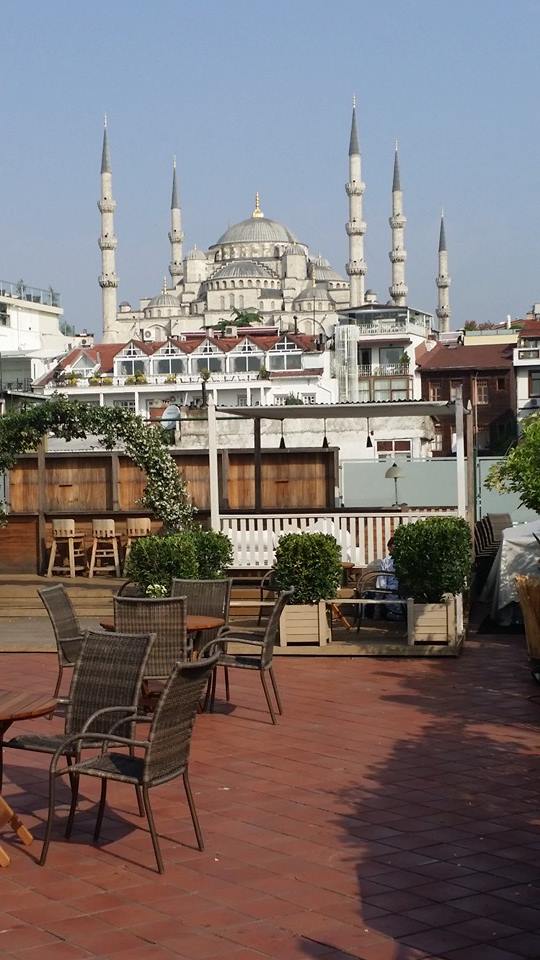
Above: Haggia Sophia... once a Christian church... then a mosque... then a museum... now slated to become a mosque once again.
From terrace at breakfast... Armada Hotel, Istanbul, Turkey. 19 June 2014.
On the road to Baku.
Even as a septuagenarian dictator and conqueror of Berlin, he kept studying. "Look at me," he said in about 1950, "I'm old and I'm still studying." His library books are all carefully marked with his notes and marginalia. It was the thoughtful and diligent autodidactive fervor, well concealed under the crude manners of a brutal peasant, that his opponents such as Trotsky ignored at their peril.
On Josef Stalin. Footnote page 51, "Young Stalin," Simon Sebag Montefiore

Above: Trabzon Airport, eastern Turkey on the Black Sea. Getting closer... on the road to Baku. 19 June 2014.
... the revolutionary proletariat alone is destined by History to liberate mankind and bring the world happiness...." humanity must undergo great "trial and suffering and change"... before it achieved "scientifically proven socialism."
Josef Stalin
Its the family, stupid!
Note (above image) the lady in the chardor. She's among many women so dressed who flew on our AirBus 21, on Onur Airlines (private, domestic Turkish owned airline), from Istanbul to Trabzon. 1 1/2 hour flight. 19 June 2014.
She's from Saudi. Trabzon is emerging as a regular tourist destination for Saudis who drive from the Black Sea shore in Trabzon a short distance into a cool, green, mountain environment 500 to 600 feet higher in elevation... like people everywhere who seek respite from the heat. The Brits went to hill stations in India. The Mah am ee uns (sic) go to North Carolina in summer, Texans go to Colorado, and Phoenecians (sic?) go to Park City.
I can't help notice how unusual it seems for modern, Saudi women to be in the company of their western dressed husbands and children while they themselves dress in a way where no part of their body is showing, except their eyes. Some of the women I saw on our aircraft were young mothers with 3 to 5 kids in tow.
The Muslim husband has more options in dress. One in particular I saw today was outfitted in designer jeans, a baseball cap, a t-shirt with an ad slogan, and designer sun glasses. It seems strange. Just sayin.
Islam isn't the only religion, however, that has strictures on dress. Sikhs, Orthodox Jews, Mormons, Mennonites all have dress requirements. Female modesty is the aim of many of those religious dress requirements. The religious rationale for female modesty, I believe, ultimately boils down to ensuring that conjugal relations are family centered and not promiscuous. "Multiplying and replenishing the earth" is the priority of such religious cultures, and to accomplish it requires strict rules governing the association of men and women... or so the argument goes.
Muslim resistance to some aspects of western, secular culture is likely rooted in Muslim fear that evolving, less restricted, western cultural sexual mores assault Muslims' desire to advance their own culture via a tradition which mandates conjugal relations occur exclusively between a husband and wife.
And, so the spin would go, family formation is "so important" in Muslim culture... that the bearer of children, the giver of life... the mother... must be given the supreme honor of having her physically protected from the gazes of would be suitors who are not her husband... - the chardor, or so the spin goes.
As Western culture as "de religionized (sic)" it has also "commoditized" sex. As a result, the incentive for family formation as a western cultural ethic has faded. Most western cultures (Europe and the United States) are now birthing at well less than population replacement rate. Conversely, Islamic population continues to grow as the family forming ethic, buttressed by "holding women sacred," suffuses Islamic religious practice... or so the argument goes?
Istanbul was once Constantinople, or so the song goes.
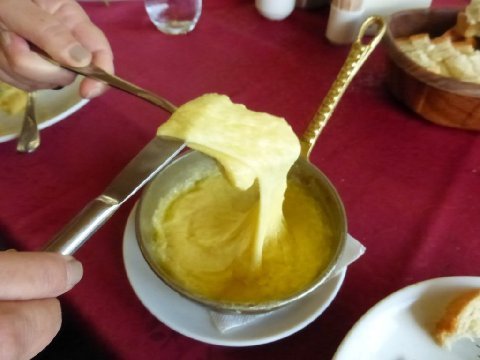
Above: Kuymak, Cheese mixed with corn meal, both foods produced in the region near Trabzon, Turkey. 19 June 2014.
Served as an appetizer at evening meal at Bayan Bay, an outdoor restaurant on a small lake several miles west of Trabzon. TIMDT and Mwah (sic) both agree that food in Turkey is wonderful. Beaucoup veggies laced with olive oil and spices. Various cheeses. Tonight, as main courses, TIMDT had trout and Mwah (sic) had kofta (lamb kabob).
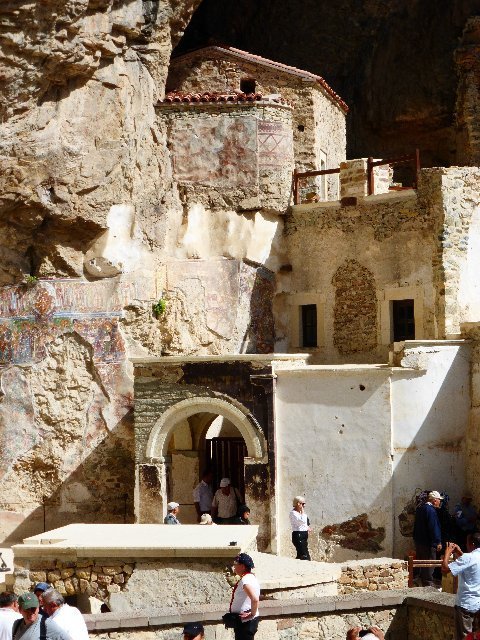
Above: Sumela Monastery, eastern Turkey, near The Black Sea. 20 June 2014.
Greek Orthodox monastery dates to 386 AD and is said to have been ordered built by Justinian.
TIMDT can be seen in white top and black pants in the southeast quartile of the image.
The Monastery is located in Altindere (Golden Creek) National Park about 40 kilometers from Trabzug.
The ride from the Trabzug Novotel Hotel to the monastery was the first segment ridden on the MotoDiscovery motorcycle tour, "From the Black Sea to the Caspian."
TIMDT and Mwah (sic) are riding tandem on a BMW R1200 GS motorcycle.
From Sumela monastery, 13 bikes and 17 riders backtracked to the 010 coast highway and the 120 mile ride along the Black Sea coast to the Georgia border.
Noteworthy along the ride were numerous high rise, sea facing, residential construction projects. Kaz says cheap money in the US directed to Turkey is financing a construction boom of unprecedented proportions.

Above: Fresco from ceiling of chapel of Sumela Monastery, eastern Turkey. 20 June 2014.
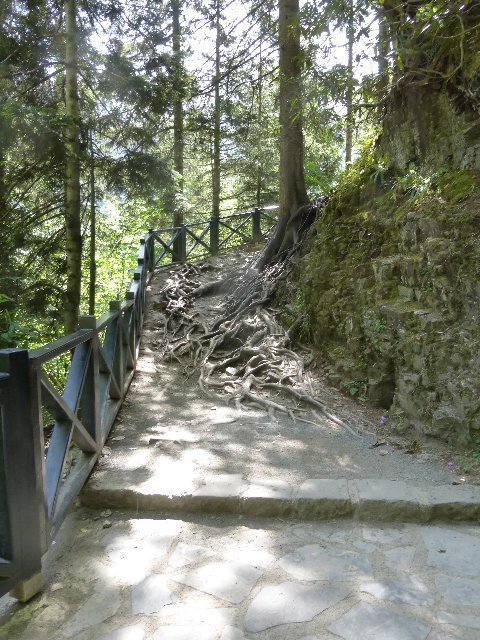
Above: 20 June 2014. Tree roots' long term destruction of the path to Sumela Monastery, eastern Turkey. Despite all humans can do, the earth takes it all back. Several years ago I saw the temples of Angor Wat, in Cambodia, being turned to dust by imperceptible, but powerful, invasive jungle forces.
Man has been on earth but a short time when time's measurement is geologic. Likely time is also short before the earth becomes inhospitable to mankind.
I'm with Steven Hawking... who says, mankind should be working assiduously to hedge its survival bets by getting some of its species on other planets.
Efforts to prolong earth's viability are folly considering the earth's inevitable demise whether by root invasion as above, comet, blowing of the Yellowstone caldera, or 1/3 of California falling into the sea when the inevitable big one hits.
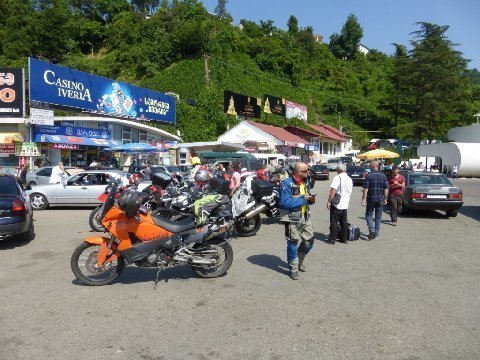
Above: Republic of Georgia, beyond immigration. 20 kilometers from Batumi, Georgia's port on the Black Sea.
Tour leader Kaz is in the blue motorcycle jacket. His KTM 990 Adventure motorcycle (orange) is at left.
Tiflis (Tiblisi) Seminary (Stalin's high school years - 1890's).
The Empire's seminaries were "notorious for the savagery of their customs, medieval pedagoguery, and law of the fist," comments Trotsky. "All the vices banned by the Holy Scriptures flourished in this hotbed of piety." This seminary, nicknamed the Stone Sack, was worse than most: "utterly joyless," reported one pupil. "Droningly boring - we felt we were in prison."
On the road to Baku... 20 July 2014.
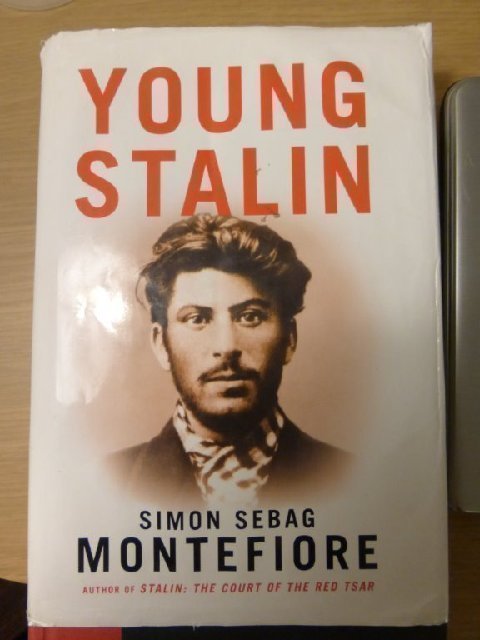
Above: Book. "Young Stalin," by Simon Sebag Montefiore. 21 June 2014.
1901. Young Stalin, moving up in the Tiflis (Tiblisi) underground Marxist hierarchy, has the Tsar's secret police close on his tail. To take the heat off, he gets on a train bound for Batumi, turbulent oil port of the Russian Empire, "where he would spread blood and fire."
From "Young Stalin..."
Comrade Soso (Stalin) brought his new merciless style to Batumi with a vengeance. Within three months of his move to the seaside boom town, the Rothschilds' refinery had mysteriously caught fire. A militant strike had led to the storming of the prison and a Cossack massacre. The town was flooded with Marxist pamphlets; informers were being murdered, horses slaughtered, factory managers shot. Soso was in a feud with the old-style Georgian revolutionaries and was having an affair with a married girl while the secret police hunted him down.
The cited Rothschild refinery was at the western terminus of a railway from Baku that by the end of the 19th century carried on-fifth of the world's oil production. The Batumi refinery was built by Ludwig Nobel, brother of Swedish dynamite inventor Alfred.
On the road to Baku......
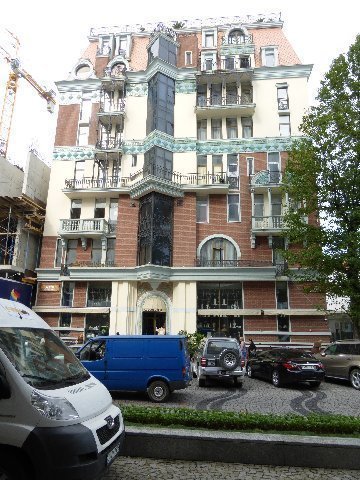
Above: Batumi's eclectic, post Soviet, architecture stands out. 21 June 2014.
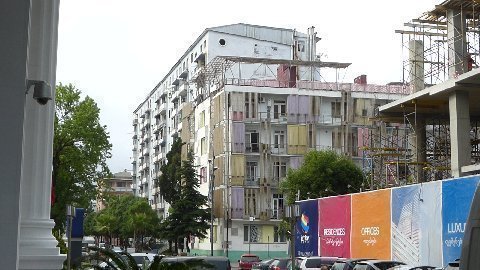
Above: And the post Soviet architecture contrasts with old apartment blocks from the Soviet period. 21 June 2014.

Above: 21 June 2014. From sea level at Batumi we climb an unpaved Caucusus mountain route, over the 7000 foot Goderzi summit. Considering the difficulty of the riding terrain, TIMDT and Girl Scout, otherwise pillion riders, rode in the follow van. We would ride down the mountain to Bakuriani, a ski resort town, where we would spend the night. The ride was about 250 kilometers, about 50 kilometers of which was eight out of ten riding difficulty unpaved.
We are in the semi-autonomous Georgian province of Adjara. Adjara and Batumi are the first choice as vacation spots for Tiblisi and Armenia residents.
Under Ottoman control from the 16th centure to 1878, most of Adjara's inhabitants were converted to Islam, but today Muslims comprise only about 30% of the population.
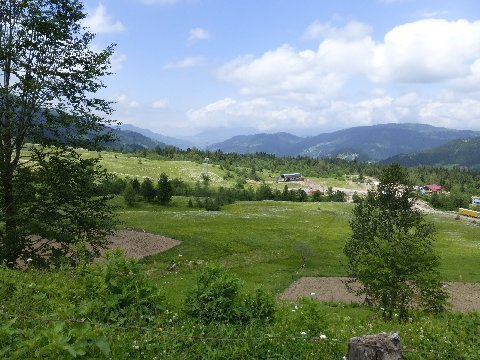
Above: 21 June 2014. Ski lift on the Batumi side of Goderdzi summit.
The lift is part of a small ski resort being developed at Goderdzi pass. Getting there will be a problem until the road is upgraded, but, there was paving going on 15 kilometers or so below the summit.

Above: 21 June 2014. At Goderdzi summit we encountered the pictured motorcycle rider, gazing trance-like down the route he had just ridden in the spectacularly scenic, Adjara province, Caucusus mountains of Georgia.
Our ascent route followed the picturesque Acharistskali River which flows into the Black Sea. On the descent from Goderdzi pass, the route followed the Mtkvari River, which flows east to eventually reach the Caspian Sea.
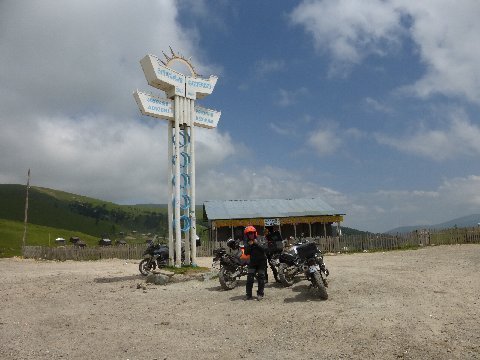
Above: 21 June 2014. Goderdzi summit, Caucusus mountains, Georgia. Brazil, Taos, and Mwah (sic) enjoyed shaslick and salad at the little summit restaurant while waiting for the other riders and the van.
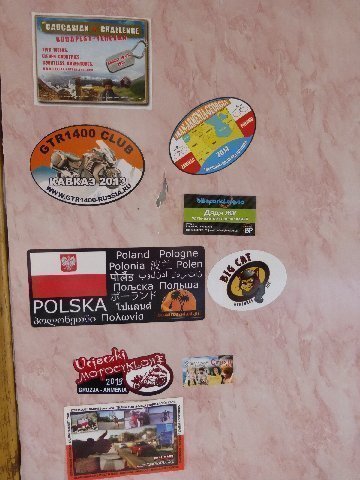
Above: 21 June 2014. Stickers from previous motorcycle expeditions on wall of tiny restaurant at Goderdzi summit.
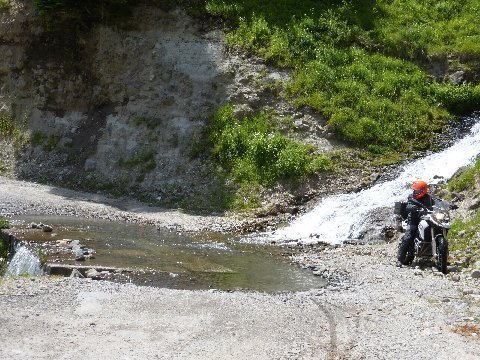
Above: 21 June 2014. Taos reconsiders the water crossing he had just negotiated on the descent from Goderdzi pass. Slabs had been put in the foot deep water to facilitate vehicle crossing, but the slabs were slippery and had exposed rebar coming out the sides and ends.
Taos and Mwah (sic) had left ahead of the others. Taos was GPS equipped and did an excellent job of navigating our way to our hotel in Bakuriani.
Bakuriani was enshrouded in a thick fog when we arrived. It took us close to an hour to find our hotel. We asked several people for directions and found none who knew where the hotel was. Finally we found a taxi driver - and old Burt Richmond trick - who we paid to lead us to our destination.
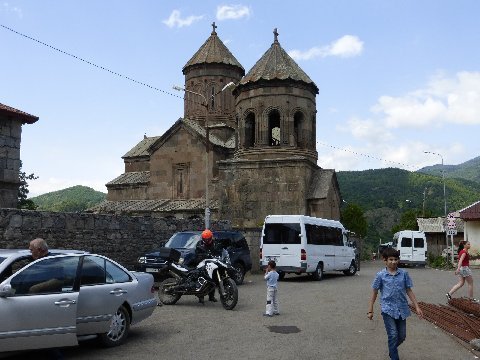
Above: 21 June 2014. Zarzma Church. Taos and bike in front of the church.
After reaching tarmac,Taos and I stopped at the church which was only one kilometer off the main road.
15th century frescoes were on the ceiling of the church and one out building.
The Georgian Orthodox Church is a separate entity "in communion" with the Greek and Armenian orthodox churches.
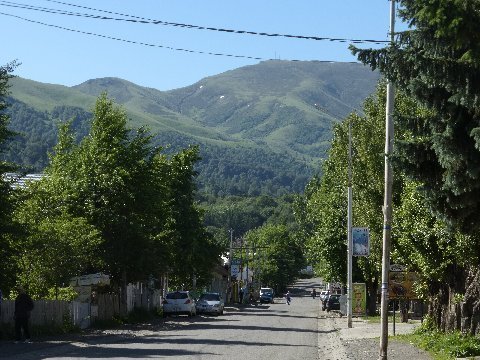
Above: 22 June 2014. Bakuriani, Georgia. Ski resort.
When the Park City brand implodes (now apparently headed that direction) we can come here to Georgia to ski. Here there is the sense of aspiration with many hotels under construction and new lifts and runs being established.
We spent the night of 21 June 2014 in this town at the Hotel Villa Palace.
When Taos and Mwah (sic) rode into the town late yesterday afternoon, the area was enshrouded in fog. It took us an hour to find the hotel.
21 June 2014 Addendum:
Enjoy the diary as usual.
How do you transfer quote from Stalin book to your email?
Basketball,
Pelham, NY
The most beautiful shorelines of the Mediterranean have been destroyed by building and now turkey as well C it while it's nice. I remember how gorgeous Nice was in the 50s with the fields and fields of beautiful flowers which made fabulous. Perfume which no longer exists. it's one concrete sprawl of horror. Ditto Greek islands and the Spanish coast.
Comic Mom,
Park City, UT
wow!!
just great. thanks Steve.
you got to see that all especially that iconic --pardon the word but it is--fresco.
Brand Man,
Venice, CA
Looks wonderful, hope all are enjoying.
Markco,
Ojai, CA
AWESOME!
Car Guy, Tacoma, WA
Steve,
Yours is a great way for me to keep up with the trip progress. I rode some of this area in 2000 and actually introduced Kaz to Georgia & Azerbaijan. Hopefully, you find Baku to be great fun with lots of treasures!
Isetta, Chicago, IL
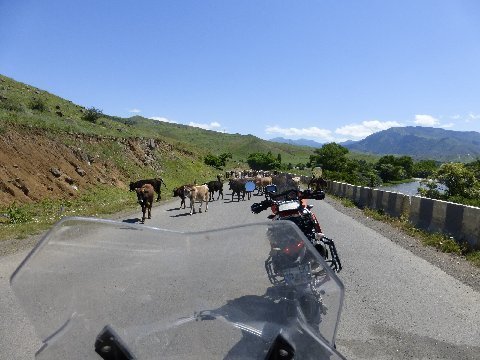
Above: 22 June 2014. Route from Akhaltsikhe, Georgia to the Armenian frontier.
Squint and you can be in Paradox Valley, southwestern Colorado, where CO SR 91 is a regular cattle drive route.
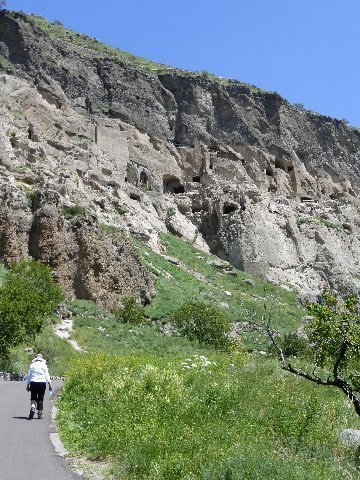
Above: 22 June 2014. TIMDT makes her way up to the Vardzia cave city,in the Mtkvari River valley. In the 13th century the Georgian Church established a monastery where up to 2000 monks lived at one time. The monastery is located 10 miles off the main route from Akhaltskihe, Georgia to the Armenian border.
Looks like a poor man's Cappadocia.
Wonderful 300 foot vertical climb on a near perfect day... it was a little warm... 85 degrees. Both TIMDT and Mwah (sic) were happy to get the exercise.,
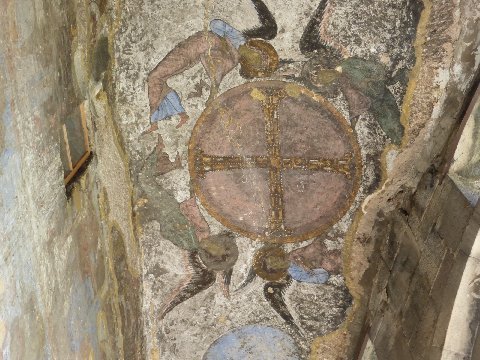
Above: 22 June 2014. Frescoes on the vault ceiling adjacent to the chapel carved into the cave city of Vardzia. The frescoes date back to the 12th century.
Christian ruins are old here. Areas comprising Georgia and Armenia were among the areas to adopt Christianity.
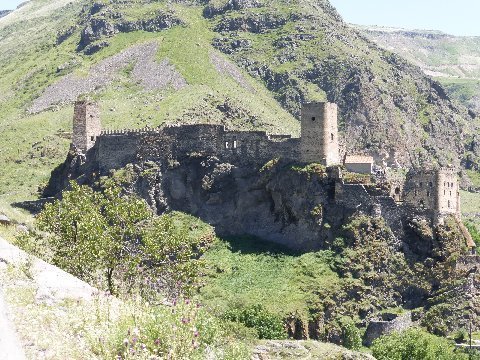
Above: 22 June 2014. Khertvisi Fortress.
At the junction of an unidentified river ant the Mtkvari River. We leave the Mtkvari River and now follow the unidentified river until we reach the Armenian frontier.
The Adjara region is pockmarked with old churches and castles.
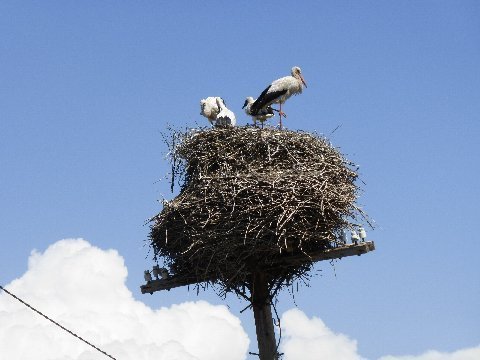
Above: 22 June 2014. Storks in pole nest in Gorelovka, the last town size in Georgia before reaching Armenia.
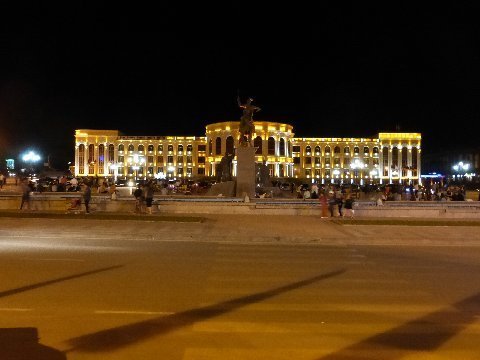
Above: 22 June 2014. Russian architecture, central square, Gyumri, Armenia.
Gyumri is Armenia's second city. We stayed in Araks Hotel.
The city was leveled by an earthquake in 1988. 50K deaths.
Lots of smokers in these here parts... no non smoking zones. It would be hard getting used to this were one to spend any amount of time in this region.
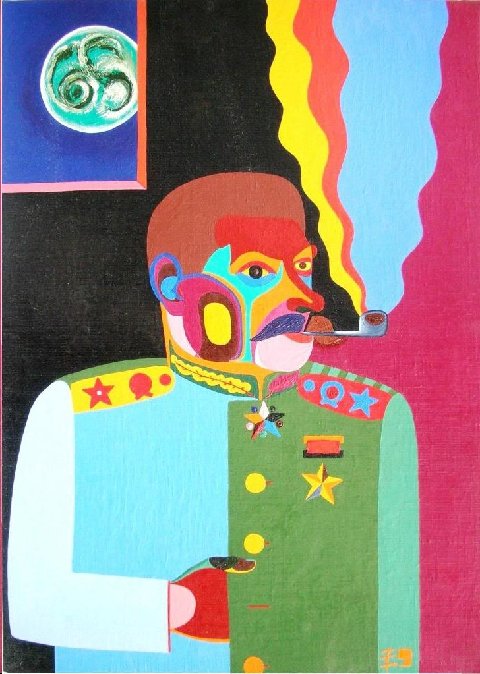
Above: 22 June 2014. Josef Stalin.
Nineteen-hundred-and five began and ended with slaughter. It was the year of revolution in which young Stalin, for the first time, commanded armed men, tasted power, and embraced terror and gangsterism. On 06 February, he was in Baku when some Armenians shot a Tartar in the center of the city. Azeri Turks - or "Tartars" as they were often called - retaliated. The news spread. The authorities, who had long resented Armenian wealth and success, encouraged the Muslim Azeri mobs to pour into the city.
For five long days, Azeri gangs killed every Armenian they could find, when the frenzied hatred that comes from religious tension, economic jealousy and neighbourly proximity. While anti-Semitic pogroms broke out across the empire,k Baku descended into an orgy of ethnic killing, burning, raping, shooting and throat-cutting. The governor, Prince Nakashidze, and his police chief did nothing. Cossacks handed over Orthodox Armenians to be slaughtered by Azeri mobs, armed by the police. One Armenian oil baron was besieged in his palace by an Azeri mob, whom he picked off with a Winchester rifle until he ran out of ammunition and was torn to pieces. Eventually, the Armenians, wealthier and better armed, started to fight back and massacre Azeris.
"They don't even know why they're killing each other," said the mayor. "Thousands of dead lay in the streets," wrote a witness of the Baku slaughters, "and covered the Christian and Mussulman cemeteries. The odour of corpses stifled us. Everywhere women with mad eyes sought their children, and husbands were moving heaps of rotting flesh." At least 2,000 died.
Stalin was there to see these infernal and apocalyptic sights. He had formed a small Bolshevik Battle Squad in Baku. Now he gathered this mainly Muslim gang and ordered them to divided the two communities wherever possible while simultaneously taking the opportunity to steal any useful printing equipment - and raise money for the Party by protection-rackets. Stalin, according to his first biographer, Essad Bey, who grew up in Baku, "presented himself to the head of the Armenian household and gravely informed him that the time was near when the household would fall beneath the knives of the Muslims," but "after a donation to Bolshevik funds, Stalin conveyed the Armenian merchants to the countryside."
Chapter 14, "Young Stalin," Simon Sebag Montefiore
On the road to Baku...
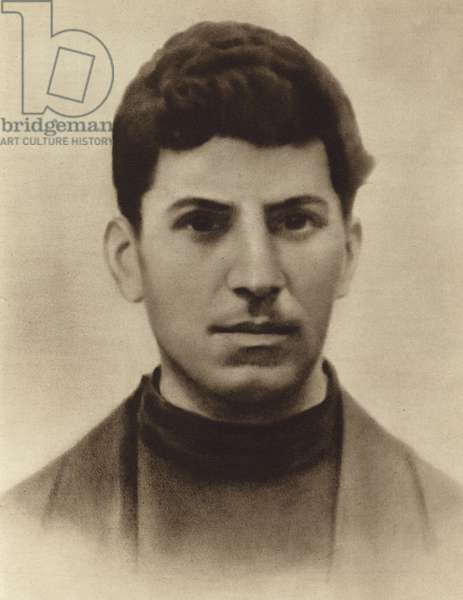
Above: Young Stalin.
Soso (Young Stalin) suffered bitterly, terrified of the drunk Beso (his father). "My Soso was a very sensitive child," reports Keke (Stalin's mother). "As soon as he heard the sound of his father's singing balaam-balaam from the street, he'd immediately run to me asking if he could go and wait at our neighbours until his father fell asleep."
Crazy Beso now spent so much on drink that he even had to sell his belt - and, explained Stalin later, "a Georgian has to bee in desperate straits to sell his belt." The more she despised Beso, the more Keke spoiled Soso: "I always wrapped him up warmly with his woollen scarf. He for his part loved me very much too. When he saw the drunken father, his eyes filled with tears, his lips turned blue and he cuddled me and begged me to hide him."
Beso was violent to both Keke and Soso. A son was the pride of a Georgian man, but perhaps Soso had come to represent a husband's greatest humiliation if the evil tongues were right after all (that Beso wasn't Stalin's father). Once Beso threw Stalin so hard to the floor that there was blood in the child's urine for days. "Undeserved beatings made the boy as hard and heartless as the father himself," believed his schoolmate Josef Iremashvili, who published his memoirs. It was through his father "that he learned to hate people." Young Davrichewy recalls how Keke "surrounded him with maternal love and defended him against all comers," while Beso treated him "like a dog beating him for nothing."
Chapter 2, "Young Stalin," Simon Sebag Montefiore
On the road to Baku....
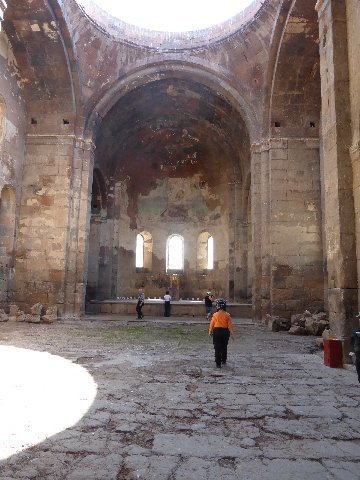
Above: 23 June 2014. TIMDT checks out ancient, 8th century Armenian church along the route from Gyumri to Yerevan, Armenia. Brightness to the right is sun coming in from open, long since destroyed, dome.
Above the three windows in the apse is a partial fresco dating to the 7th century.
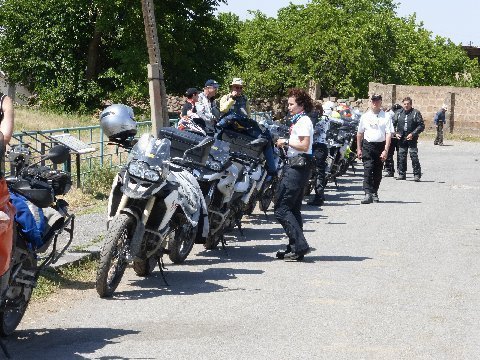
Above: 23 June 2014. Bikes and riders at rest stop. On the road to Baku. Short ride today from Gyumri to Yerevan. Terrain is grass covered steppe like landscape with outline of high mountain ranges in the distance on either side.
As we rode (TIMDT pillion) I frequently glanced in a direction, 2 o'clock, to see if I could capture the outlines of Mt. Ararat. It wasn't until around 20 kilometers outside of Yerevan, however, that the big mountain, over 5000 meters in elevation, loomed. The atmosphere was hazy, but I could see the mountain and its contours fairly clearly. I thought about stopping to capture an image, but, coming into a strange town, and riding without GPS, I wanted to stay close to the group. With TIMDT on the back I didn't want to do a "goose chase" looking for the hotel in a strange city. Surely, I'd get a chance to "image" the famed mountain during our two night stay in Yerevan.
Ararat is a sacred mountain to Armenians, but has little significance to Turks. Yet because of the closed border between Turkey and Armenia, Armenians have no access to the mountain, located in Turkey, other than seeing it loom over their capital city.
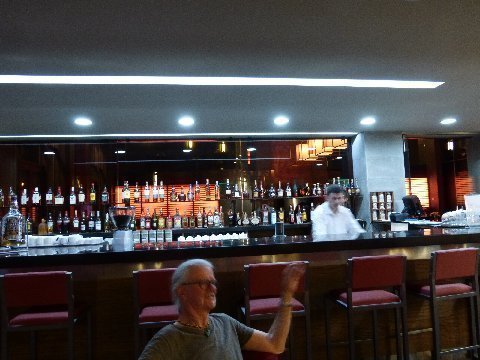
Above: 23 June 2014. Bar at Tufenkian Hotel, Yerevan, Armenia.
Bartender Q and A:
The Bishop: Will the border between Turkey and Armenia ever be opened?
BT: (good English, low 30's, married, one child): I don't think so. There is too much bad history. We are Christian and our neighbors on either side of us are Muslim. They want to kill us.
The Bishop: Is there compulsory military service in Armenia?
BT: Yes. Boys must serve three years. Girls can join and do non combat jobs, but it is not compulsory for them.
We Armenians are always on our guard. We are on edge. Fighting on the border with Azerbaijan could start any time. Regularly there are incidents where they kill our troops.
Bishop: What is Armenia's relationship with Israel, considering Turkey has a strong connection with Israel?
BT: Not good. Israel does not recognize the Armenian genocide. They feel that the Holocaust should be the only genocide that is recognized.
Bishop: How important is the large Armenian diaspora?
BT: The diaspora is very important. Armenians abroad... Charles Aznavour, Kirk Kerkorian and many others contribute to Armenia. We are embarrassed by Kim Kardashian.
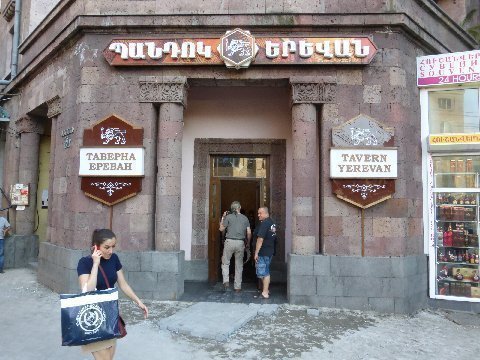
Above: 23 June 2014. Tavern Yerevan. Dinner.

Above: 23 June 2014. Bread plate and one of the many appetizers placed on the table before arrival of the main course.
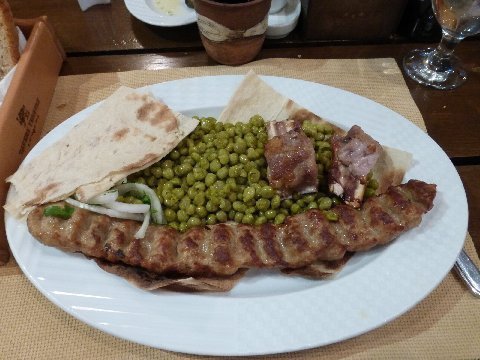
Above: 23 June 2014. Beef kofta and peas.
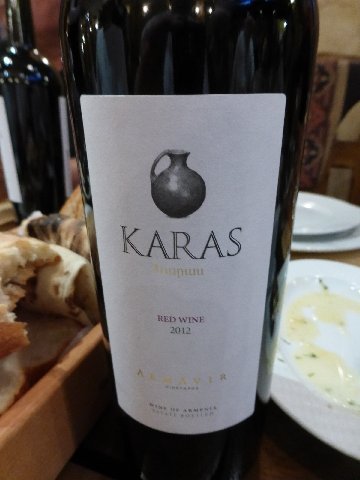
Above: 23 June 2014. Armenian red
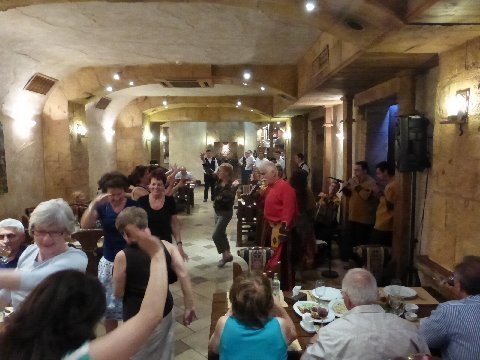
Above: 23 June 2014. Spontaneous boogie by restaurant patrons, including some of our group, to Armenian folk music. Locals were happy to see us gringos dancing and were eager to offer dancing tips. Very festive atmosphere!
The music highlighted Armenia's ambiguous location, neither Europe, nor Asia. While Armenians are Christian, and while their life-style practices seem orientated towards European life, their folk music is decidedly "Eastern" in sound and rhythm.
Located in the southern Caucusus, with Asian Anatolia on the west and Moslem Azerbaijan on the east, it seems hard to categorize, at least from a cartographer's point of view, Armenia as Europe.
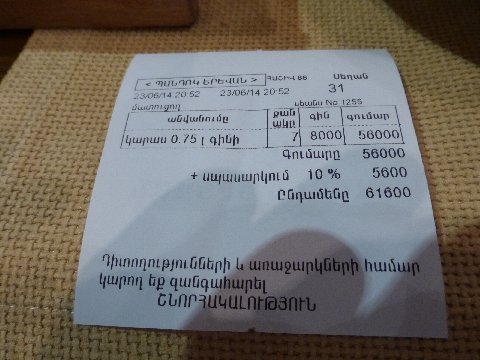
Above: 23 June 2014. Uh... waiter... could you please itemize this bill?
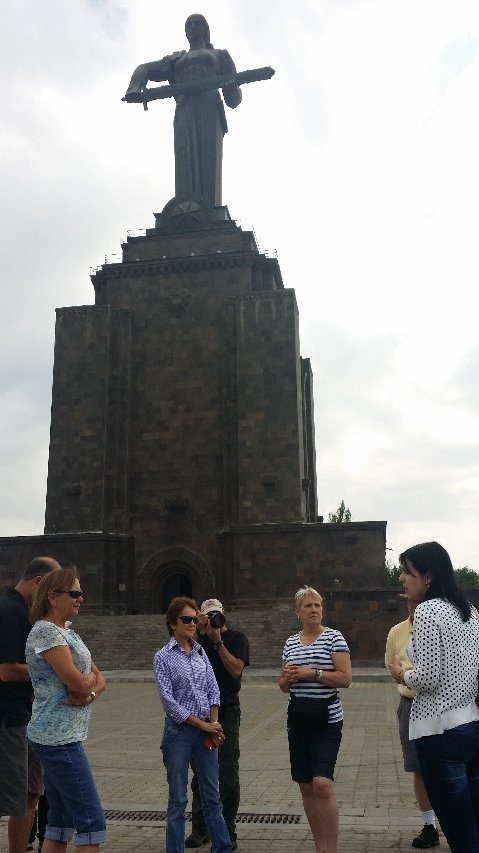
Above: 24 June 2014. Some of our tour participants listen to Vilena, our Armenian guide, for the day's city tour of Yerevan. Tour goers are standing at the base of the Mother Armenia monument. Yerevan, Armenia.
Joe Stalin (on the road to Baku, in search of the Caspian oil) stood where Mother Armenia now stands until the demise of the Soviet Union when the statue was torn down and shipped to Russia.
Russia remains Armenia's principal guarantor, notwithstanding Armenia's independence. Russian is spoken by most Armenians and is a mandatory topic in the public school system.
Mother Armenia (image above), looks towards Turkey, long standing Armenia antagonist, with her sword ready to draw.
At the heart of the "antagonism" between Turkey and Armenia lies the putative "genocide." During WWI large numbers of Armenians lived in Ottoman Turkey. Some of these Armenians decided to side with Christian Russia during the war. Three Ottoman pashas forced marched hundreds of thousands of Armenians from their homes in eastern Turkey to Syria to mitigate their supposed threat to the war effort... where the Ottoman's sided with Russia's enemy, Germany.
Documentation has not been produced to validate the fact that the Turkish pashas deliberately executed a pogrom to kill Armenians, but there is little dispute that between 1.5 and 2.0 million Armenians were killed in Ottoman Turkey between 1915 and 1922.
Turkey's unwillingness to "recognize" the genocide keeps the dispute alive for the Armenians. In 2009 leaders of the two countries attended sports diplomacy soccer matches in each of the two countries and seemingly made some progress towards resolution of the "genocide" issue, but diplomatic relations were thwarted when Turkey said it could not move forward as long as Armenia's relations with Azerbaijan continued to be in a shambles.
The Armenia / Turkey frontier remains closed. The Armenian side of the border is guarded by Russian troops. Most of Armenia's army is faced off against Azerbaijan.
Conflict between Christian Armenians and their Moslem neighbors (sometimes rulers) goes back centuries. There are also long periods in history where the two peoples have coexisted in peace.
23 June 2014 Addendum
Steve, have you had the Borjomi mineral water?
The Monk,
Salina, UT
Yes! Consumed it regularly while in Georgia!
wonderful and wonderfully shot--great documentation. thanks Steve.
Brand Man,
Venice, CA
Looks like a great trip Steve. Call when you return regarding August.
John Galt,
Walla Walla, WA
Looking forward to August ride.
Thanks for taking me along on another exotic journey.
Spook,
Reston, VA
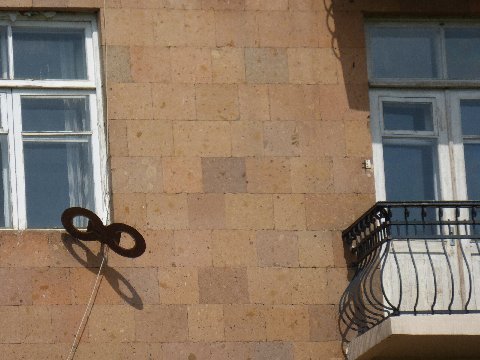
Above: 24 June 2014. Tufa stone.
Tufa stone, a vocanic rock quarried in Armenia, is widely used as building facade throughout the city of Yerevan.
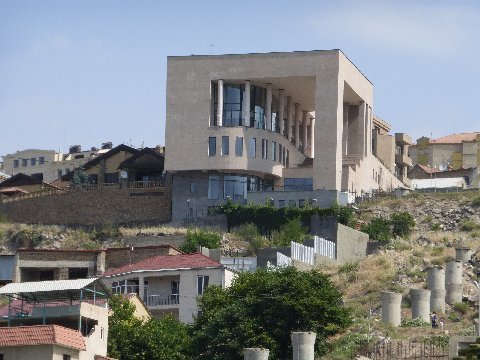
Above: 24 June 2014. Charles Aznavour's home. Yerevan.
The diaspora. Armenia's population is 3MM. But, 7 MM Armenians live outside of the country. 2MM in Russia. 1MM in the United States. 0.5 MM in France. Sizeable numbers in South America and Australia.
Wealthy non-resident Armenians "give back" to Armenia. With 25% unemployment, the country is highly dependent on remittances from abroad. Aznavour, for one, has given many benefit concerts with proceeds going to Armenia.
American investor Kirk Kirkorian is a diaspora supporter of Armenia.
Diaspora philanthropist and art collector Gerald L. Cafesjian has spent millions of dolllars completing the Cascade monument started in the Soviet period. Within the monument is the Cafesjian museum which houses a vast collection of art and glassware.
The diaspora took shape in its present form starting in 1917 when large numbers of Armenians from eastern Turkey left for the US and Europe to escape persecution from the Ottomans.

Above: 24 June 2019. Cat sculpted by Fernando Botero stands at the base of the Cascade. It was the first element of the Cafesjian collection put in place.
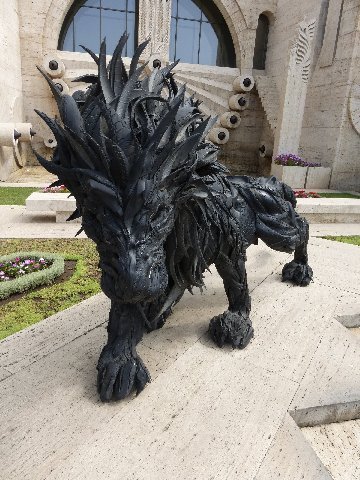
Above: 24 June 2014. "Monster" sculpture fabricated from car and truck tires at Cafesjian's Cascade Museum, Yerevan, Armenia.
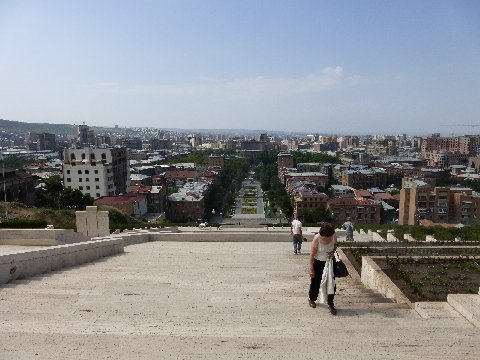
Above: 24 June 2014. Vista of Yerevan looking down the "cascade" to a tree lined park below. Museum pieces are located on the cascading steps and in an enclosed area where viewers can ride a "mechanical stair," (that's what Vilena called the escalator) in an indoor section of the cascade and view art pieces, mostly glass sculpture, on either side.
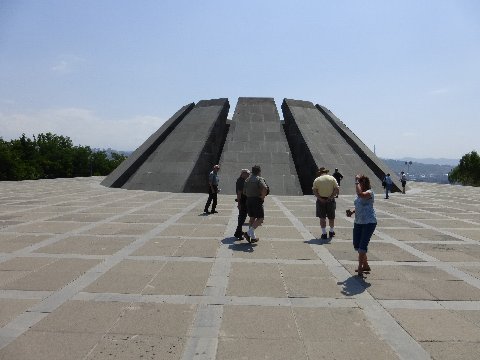
Above: 24 June 2014. Armenian Genocide Monument.
Vilena was passionate, even to the point of being repetitive, about Armenia's hurt that its "genocide" is not recognized by the Turks and by many other countries in the world.
France is loved in Armenia as the French have recognized the Armenian genocide. All recent French presidents have paid visits to Armenia. It is possible (my speculation) that the fact that France's most famous and beloved living singer, Charles Aznavour is Armenian, has something to do with French/Armenian friendship.
The US does not recognize the genocide. Potential destabilization of the US's important relationship with Turkey is cited as a reason.
Similarly with Israel. Israel does not recognize the Armenian genocide. Israel his held out for significant criticism by the Armenians given the country's intimate tie to the Holocaust. Recall the hotel bartender said, "they want to be the only ones to be seen to have suffered at the hands of despots."
The reason for Israel's lack of recognition of the Armenian genocide is similar to that of the US. $4 billion in annual trade occurs between Israel and Turkey. There are 7 flights daily from Istanbul to Tel Aviv.
Post Script: France's relationship with Turkey is "OK." Though outward relations between France and Turkey sometimes are seen to be frosty, commerce and tourism between the two countries is robust.
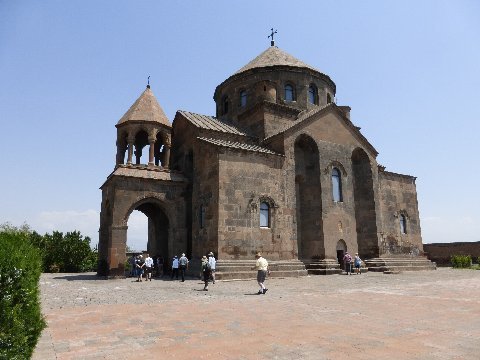
Above: 24 June 2014. Church of St. Hripsme. 618 AD.
Armenia was one of the first countries (or peoples) to adopt Christianity. Fourth century.
The Armenian Apostolic Church is "alive and well" today. Vilena reports widespread support and high levels of devotion amongst the people to the church. Traditional Christian values are "encouraged (read enforced?)." For example, sex before marriage is discouraged/forbidden.
Directing sexual activities to family formation seems evident throughout Yerevan, where I saw numerous young families on Yerevan city streets and squares. This, in contrast, to Italy, which has one of the West's lowest birth rates, where, last time I was in Florence, six years ago, Florentines would rush up to the rare, occasional baby carriage on the street to "baby talk" with the child.
The Soviets tried to repress the Armenian Apostolic Church, but, Armenian church leaders were effective in keeping the Church intact even if religious practice had to take on a more clandestine approach during the Communist period.
Today, the Russian government is trying desperately to revive its own Russian Orthodox religion. Russian leaders now believe that Russian culture and the Russian Church are like a double helix, one strand's survival depending on its inter-linkage with the other strand. Armenia's more-than-replacement birth rate is a source of envy for Russians concerns about Russian population implosion. Russia loses one million in population annually.
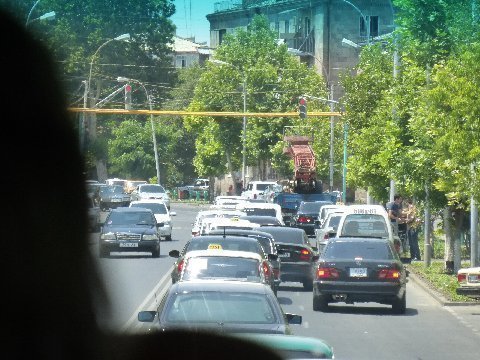
Above: 24 June 2014. Gas lines (yellow pipe above street in image) are above the street in Yerevan. The Soviets apparently believed that the cost of underground gas line infrastructure was too steep. Vilena reports that there have been no serious incidents occurring due to broken or damaged gas lines.
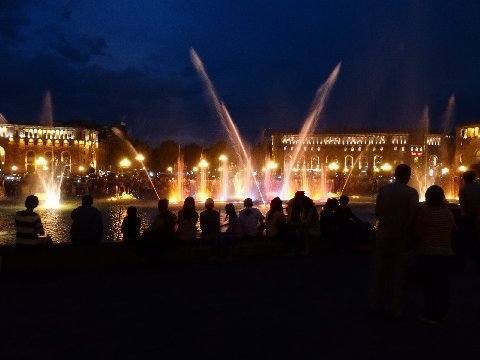
Above: 24 June 2014. Sound, water, and light, Republic Square, Yerevan, Armenia.
TIMDT and Mwah (sic) enjoyed a nice evening walk around the central areas of the city.
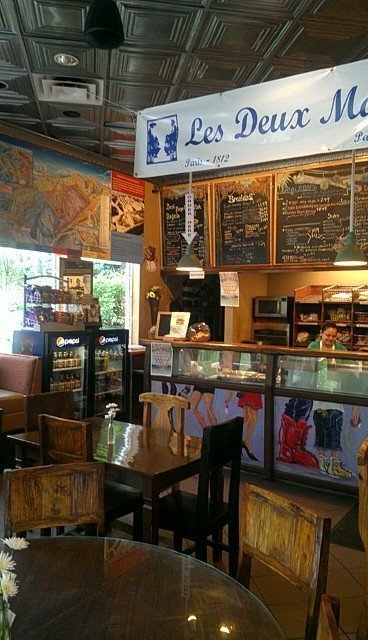
bove: Wha....? LSDM....? No one home? Image forwarded 24 June 2014 by Tucson... I guess he was there... lonely and forlorn.
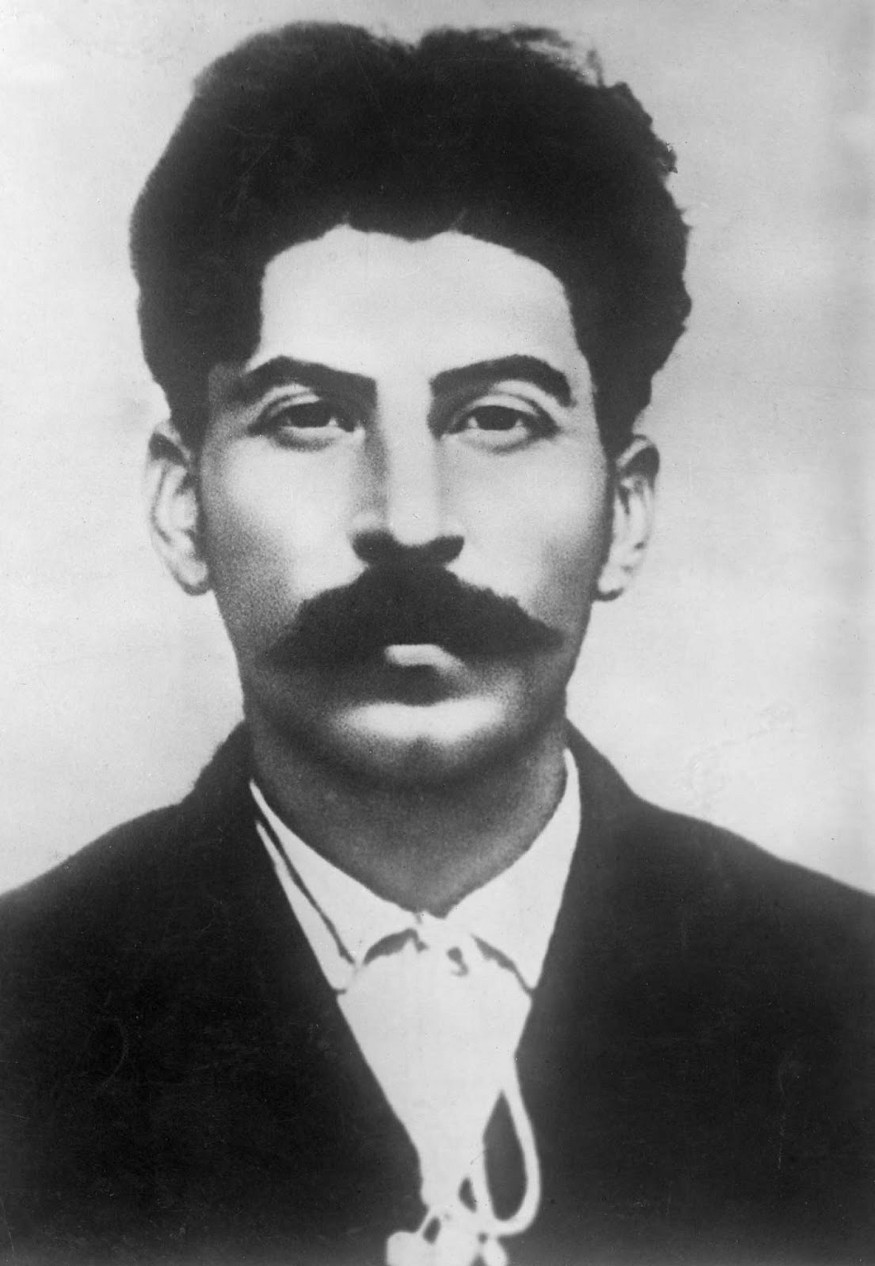
Above: Josef Stalin in his early 30's.
On 17 December 1878 the baby was christened Josef, known as Soso - the boy who would become Stalin. Soso was "weak, fragile, thin," said his mother. "If there was a bug, he was sure to catch it first." The second and third toes of his left foot were webbed.
"Young Stalin," Simon Sebag Montefiore
On the road to Baku, in search of the Caspian oil.
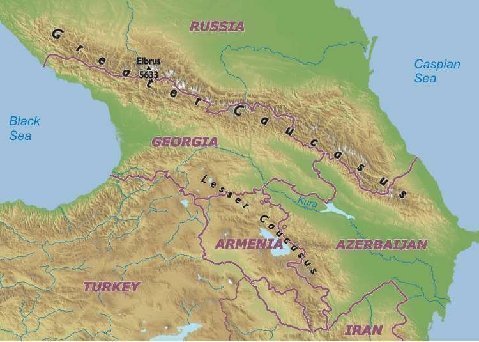
Above: 25 June 2014. Map of Caucusus supplied by Shock.
Trabzon, Turkey is on the Black Sea some 150 kilometers west of the Georgia frontier. Batumi, Georgia is 25 kilometers north of the Turkey frontier, on the Black Sea. Yerevan, Armenia is 130 kilometers south of Lake Sevan in central Armenia.
Today, 25 June 2014, we will ride north 160 kilometers from Yerevan via Lake Sevan to Dzoraget, a small Armenian mountain town not far from the Georgia frontier. Tomorrow, 26 June 2014, we will re-enter Georgia for a short period before swinging back south into Azerbaijan... on the road to Baku, which is on the Caspian Sea peninsula at the far eastern side of the map.
On the road to Baku... in search of the Caspian oil...
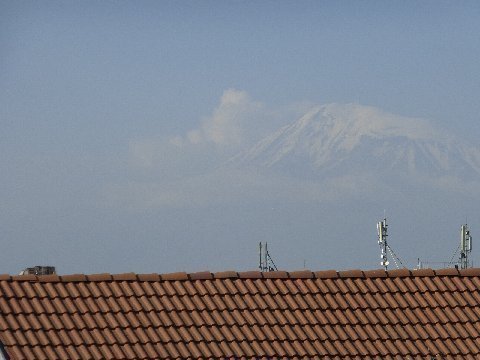
Above: 25 June 2014. Mt. Ararat. From our hotel window, in Tufenkian Hotel, Yerevan.
This was the best view we ever had of the storied Mt. Ararat which looms over Yerevan.
One of many paradoxes seen in Armenia, Ararat is sacred to Armenia, yet, because it is in Turkey, the mountain is inaccessible to them. References to Ararat are seen everywhere in Yerevan... on bill boards and shop fronts. An Armenian mineral water is branded "Noah."
For Turkey, Mt. Ararat, located in sparsely populated eastern Turkey, is less important in a historic sense, or in the sense of how it underpins nationhood, as it does in Armenia.
Other Armenian paradoxes:
Armenia, a Christian nation, has no diplomatic relations with its neighbors to the east, Azerbaijan, and to the west, Turkey, both Muslim countries. Yet, there is a strong relationship between Armenia, and an open border, with Muslim neighbor Iran, to the south.
There is considerable trade between Armenia and Iran passing through Armenia's short, 40 kilometer, southern border with Iran.
According to Vilena, Armenia is a regular tourist destination for Iranis. In Armenia Iranis find alcohol, casinos and beautiful mountain and lake resorts. Beyond Armenia is Georgia and its Black Sea coast line. Vilena notes a thriving business at the Armenia/Iran frontier, where Iranis returning to Iran, stock up on wine sold in Coca Cola bottles, and vodka sold in used water bottles. Apparently, Irani customs knows the game well, and for a bottle of "tribute" to their own coffers they allow most of the "contraband" through.
Another paradox...
Armenia has strong relations with Iran, the United States, and Russia, three countries that don't get along particularly well amongst themselves.
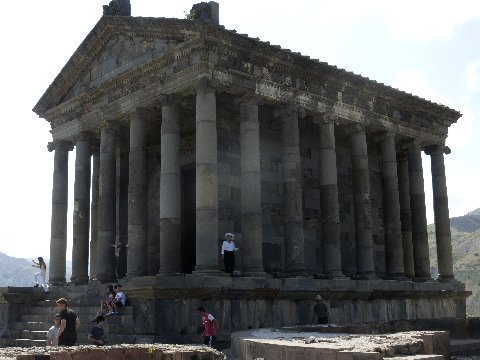
Above: 25 June 2014. Temple of Mihr, TIMDT in white shirt stands on temple, looking out at the camera.
Before leaving for Lake Sevan, we detoured to Garni, 15 kilometers in and 15 kilometers out to the main road.
Garni is located on a precipice overlooking a steep canyon with a river flowing below. It is the site of temples, in layered excavations, starting from the 9th century BC.
The Temple of Mihr, at Garni, was erected in the second half of the first century, AD, during the Roman period.
Riding out to Garni we had pretty good views of a partially haze occluded Ararat. We hoped to stop for images on our way out, but, by the time we started our return to the main highway north, the mountain was totally occluded by the haze.
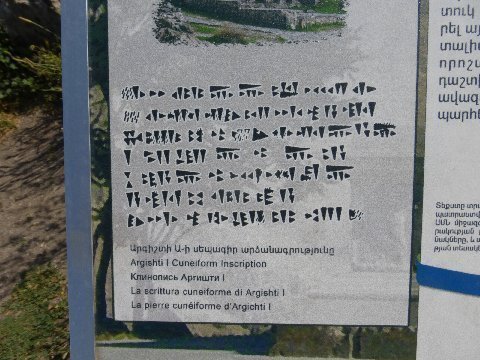
Above: 25 June 2014. Cuneiform writing story board showing cuneiform writing sample of actual steles found at Garni site.
The Ararat Valley, including Garni, was included in the Ararat Kingdom in the first quarter of the 8th century BC, during the reign of King Argishti I. The excavations, conducted in the territory of the monument in 1963, uncovered the lower half of a basalt stone inside the palace hall. A cuneiform carving attributed to Argishti I is preserved on the front section of the stone. The carving says "I conquered with Khaldian power Glamiani, which was the state of Siluni. When I returned from the hostile mountains, I drove away the men and the women."
Argishti reminds me of Anakin Skywalker, who when he returned from avenging the death of his mother who was taken captive by the sand people, said, to the effect, "I hated them... I killed them all... even the women and the children." The more things change, the more things stay the same.... even in the long distant past.... in a galaxy far far away.
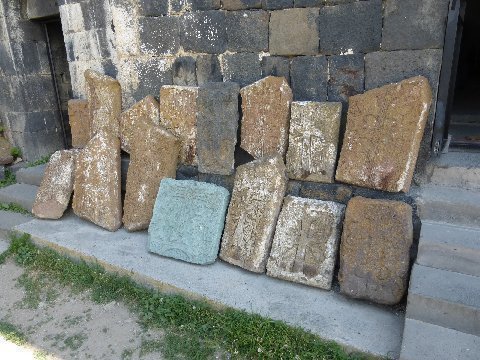
Above: 25 June 2014. Cross stones at the Sevan Monestery.
Where Russian, Greek, and Georgian Orthodoxy has icons, the Armenian Apostolic Chruch has cross stones.
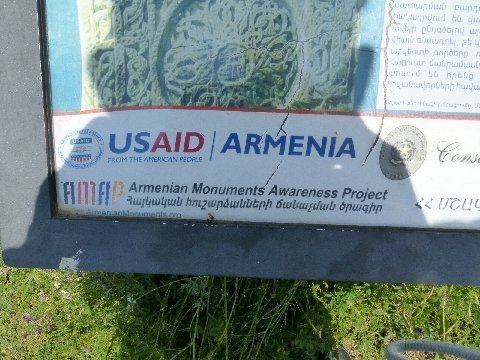
Above: 25 June 2014. Sign at Sevan Monastery.
Your tax dollars at work!
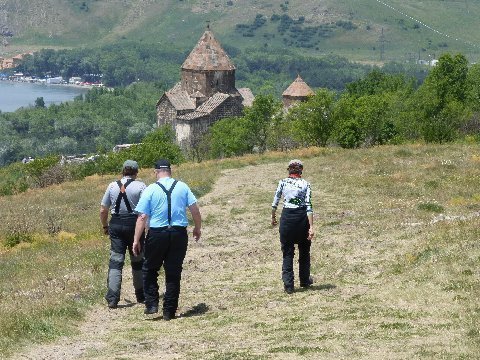
Above: 25 June 2014. Motorcycle tour participants, Taos, Shock, and Brazil walk back from a vista of Lake Sevan, towards the Sevan Monastery. A small section of the lake is seen at left.
Lake Sevan is 80 km long by 30 km at its widest. The lake is at 6000 feet above sea level, perfect for escaping warm summer temperatures.
The lake's only outlet is the Hrazdan River, which is tapped for hydroelectric power and irrigations before it flows through Yerevan to the south.
25 June 2014 Addendum:
Another great journey that we share vicariously. Thanks Steve.
Basketball,
Pelham, NY
Despite the Armenian waiter's contention, Israel's failure to formally recognize the Armenian genocide has nothing to do with a desire to focus on the Holocaust, and everything to do with diplomatic relations with Turkey (be that as it may be). The U.S. has struggled, unsuccessfully, with the same problem. It's all about Turkey and diplomacy; not historical reality.
Thanks for sharing your travel diary, including the un-itemized dinner bill.
Best regards, and safe travels.
FeeNix,
Phoenix, AZ
Incredible journey Steve! I am thoroughly enjoying it.
Nathans,
Massapequa, NY
Steve, why do you say PC brand imploding? Safe trip.
Mr. Ed,
Naples, FL
Two 800 pound gorillas, Vailisker and PCMR, duking (sic) it out over who should control 7/8 of land now used by PCMR. PCMR failed to renew its lease with Vailisker as required in lease documentation. Vailisker pounced to evict. Courts have supported Vailisker so far, but, angry PCMR seems bent on fighting the ruling to the end. As the dispute is prolonged, the Park City brand is damaged. Google it. "Vailisker" is my own nick name for Vail and Talisker, the two parties united in fighting PCMR.
Our ward has a missionary serving an Armenian-speaking mission in Ventura, CA. There is apparently a very large Armenian community in Southern California.
Rudy Jr.
Salt Lake City
Enjoying your travelogue, great pictures. I have found good flight to India using AA miles, but cannot fly to Kolkata, but rather Hyderabad. When y'all get back, please ask Margaret if she has a good agent over there who books in country flights. Thanks
Safe travels, see you in DV soon,
Mezzanine,
Miami, FL
Looking forward to the trip with you guys!
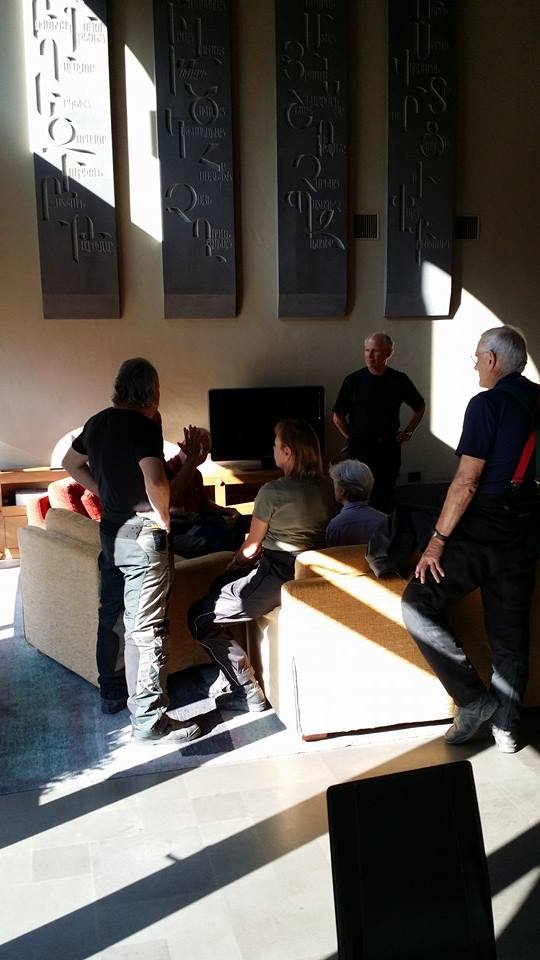
Above: 26 June 2014. Post-breakfast, morning ride briefing. Hotel
Tufenkian Avan Dzoraget Hotel, Dzoraget, Armenia.
Today our destination would be Naftalan, Azerbaijan, 200 miles.
Because the frontier is closed between Azerbaijan and Armenia, we would exit Armenia into Georgia, take a back road to the Tiblisi, Georgia to Baku, Azerbaijan main highway, and then cross, heading southeast, into Azerbaijan. Two border crossings. Armenia's borders are open only to Iran on the south and Georgia on the north.
Nagorno-Karabach
The Armenia/Turkey frontier is closed due to the unresolved dispute between the two countries where Armenia protests neighbor Turkey's unwillingness to recognize the "genocide."
Why is the border between Armenia and Azerbaijan closed? Nagorono-Karabakh,is a former Armenian province, later Azerbaijani province now separating the two countries.
Josef Stalin (On the road to Baku... and the Caspian oil!) separated Nagorno-Karabakh from Armenia in the 1920s and made it an autonomous region within Azerbaijan. The natural growth of the Azeri population outpaced growth of the Armenian one and Azeri settlers were moved to Armenian villages. By the 1980s the territory's population was down to about 75% Armenian.
Demands to join Armenia SSR grew in 1987-88, until the local assembly voted for independence from Azerbaijan SSR in December 1989, and hostilities commenced.
From 1989 to 1994 the area was racked by war, which, in its first stage, pitted the Karabakhis against overwhelming Azeri and Soviet forces.
After the fall of the USSR, the war escalated into a heavily armed clash between Armenian troops and fedayeen commandos on the one side and the Azeri army assisted by Turkish officers on the other.
A cease fire was declared in May 1994 and the territorial lines have remained constant since then. The war cost around 30,000 lives. It also resulted in a mass emigration of Azeris, by some estimates up to 750,000, in addition to 150,000 additional Azeries from Armenia.
Since the cease fire, there has been no resolution of Nagorno Karabach's status.
The area functions as a "de facto" adjunct to Armenia, uses Armenian currency etc.
Bako Sahakyan, Nagorno-Karabakh's president, ran on a pro-independence platform. But, all political decisions and economic reforms are essentially handed down from Yerevan.
Frosty relations to the point of closed borders contributes to the "on edge," "wary," even fatalistic view felt by Armenians.
Armenia's strong friendship with Russia, which garrisons troops along the Turkey/Armenia border, Iran, and France provide it with strong guarantees that Turkey or Azerbaijan won't be tempted to show aggression on the Nagorno-Karabach issue. The United States, also, putatively, a strong friend, may be a less reliable guarantor of Armenian sovereignty than it once was now that the US appears to have disengaged from interventionism in this part of the world.
Notwithstanding "guarantees" from strong friends, the Armenians are a wary people. The Yerevan bartender told us this two days ago.
Armenian Anecdote
Two years ago some friends and Mwah (sic) were on a motorcycle jaunt that stopped in Torrey, UT, the town adjacent to Capital Reef National Park.
We found rooms at the Howard Johnson motel. We asked the "motel clerk" how we could get a ride from his motel to El Diablo Restaurant. We don't like to ride the bikes to dinner as wine will be consumed. "There are no taxis," said the clerk. We asked the clerk to take us to El Diablo when he was off duty, and, offered to pay him. The "clerk" demurred for a minute, then said, "OK, I will take you... and pick you up after dinner. But, I won't accept payment."
As the "clerk" drove us to dinner, we noted that he spoke English with an accent. We asked him where he was from. Initially reluctant to tell us his provenance, he finally said, "I'm from Armenia. I immigrated to the United States with my father. In a lottery system, we chanced on an American immigration visa. We moved to Los Angeles, where we had relatives. My father and I bought all four motels in Torrey. I was acting as the motel clerk back at the Howard Johnson, but I'm actually the owner of all four motels in town (there's a Best Western, a Day's Inn, and an unbranded motel, in addition to the Howard Johnson Motel, in Torrey).
I thought a few things at the time, and mentioned these sentiments to my friends.... the man was wary of telling us his story... when he got to know us better... determining, I guess, that we didn't threaten him in any way, he opened. up.
I love hearing stories like this... assuming they're on the up ands up. America has always benefited from the efforts of "hungry," hard working, entrepreneurial, and, OK, "wary" immigrants.
Armenians are known to be resourceful in a business sense. Here, shortly after arriving in the United States from Armenia, country still beleaguered from Soviet Days, this diminutive looking Armenian "kid"... young 30 something... owned four motels near one of America's more obscure, but upcoming, national parks. I don't doubt that he bought the motels at a great price. He purchased when the tourism industry was in deep recession post 9/11.
I may be making something out of nothing...for all I know, the guy might have been a tax dodger... but the young motel owner's wariness, which I noticed at the outset of our encounter, may mirror the wariness of his people, here in the southern Caucusus... a people hardened - and made wary - by numerous clashes with their neighbors over the centuries... and therefore, very resourceful when they operate in the free atmosphere of the United States.
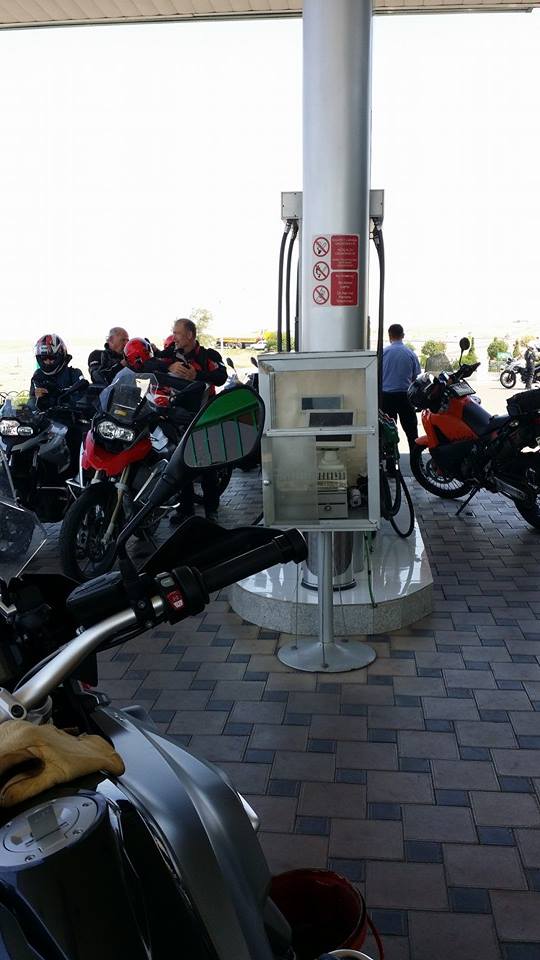
Above: 26 June 2014. Gas stop, 50 kilometers south of our destination for the evening, Naftalan, Armenia.
The first three "events", leaving Armenia, entering Georgia, and leaving Georgia... went quickly and smoothly. The entry into Azerbaijan took two hours. We were required to get motorcycle insurance. In a multi-step process, clerk's took down almost all data from each of our passports and our motorcycle carnets (transit papers) took $20 and then provided our insurance policies.
We gave the $20 and our papers to the clerks. They issued us a small receipt and directed us to a window that said "Cash." Except that we didn't give cash to the guys manning the window... we gave them the receipts. The "cash guys" entered some more data taken from the cash receipts, returned the receipts and told us to go back and wait for our insurance policies and passports at the original window.
I was worried about TIMDT during the process. She was made to go through a different line for passengers on busses... and, I guess motorcycles. She finished her process about an hour before we did and had to stand in the sun, with Chicago Girl, who also went through the "passenger" border procedure.
I tried to text TIMDT to give her a progress report, but she had left her phone on the bike. When I had completed customs I rode out of the enclosed border crossing are and TIMDT was there waiting in seemingly OK spirits. She hopped on the bike and we sped off to join the rest of the group.
After leaving Georgia and the southern Caucusus,, heading east towards the Caspian Sea, the landscape flattened and became arid and dry looking. Squint and we could have been riding in Nevada or Utah. I noticed some low ranges not far the highway to the left and, my own mind, compared the ride a bit to riding south on US 6 from Price, UT, to Green River, UT, with the book cliffs on my left.
Temperature also increased to over 90 degrees. A warm ride. We arrived in Naftalan, Azerbaijan, about 4:00 PM... in time for a cold drink and a sandwich in the shaded garden behind the Chinar Oil Bath Sanatorium and Spa, a haunt legitimized by Russians during the Soviet period. A bath in the unique Naftalan oil (looks like crude, but not good for refining for some reason or another) putatively did something wonderful for the skin.
I would consider the oil bath for tomorrow. For now it was time to shower, put on some clean clothes and meet our riding friends for dinner.
26 June 2014 Addendum:
Steve,
Fascinating stuff, thanks for the history. One correction, the USA did recognize the genocide last year.
Bill,
Tacoma, WA
Well, you may be partially right. My reading is that over 40 individual US states have passed resolutions recognizing the Armenian genocide, but, the US federal government has not. There was, or is, a House bill, to recognize, but it has been tabled due lack of confidence of passage in the Senate or ultimate veto by the President.
Clearer interpretations welcome. No time to research further.
Hi Steve, I’m really enjoying your travel tales (as always). Did you know that Gerard Cafesjian spent much of his legal career here in St. Paul, MN? He became something of a local celebrity when he contributed more than $1 million of his personal funds to spearhead restoration of a historic Carousel that is now located at Como Park. I worked with his daughter Kathleen at the time (pre-Target) and remember her joking about how he was spending her inheritance.
General Counsel,
Minneapolis, MN
thanks again. very informative and well illustrated. (there is a big armenian community in l.a. don't tell anyone but a good many thugs and gangsters .)
Brand Man,
Venice, CA
Ummmm.... well there ya go!
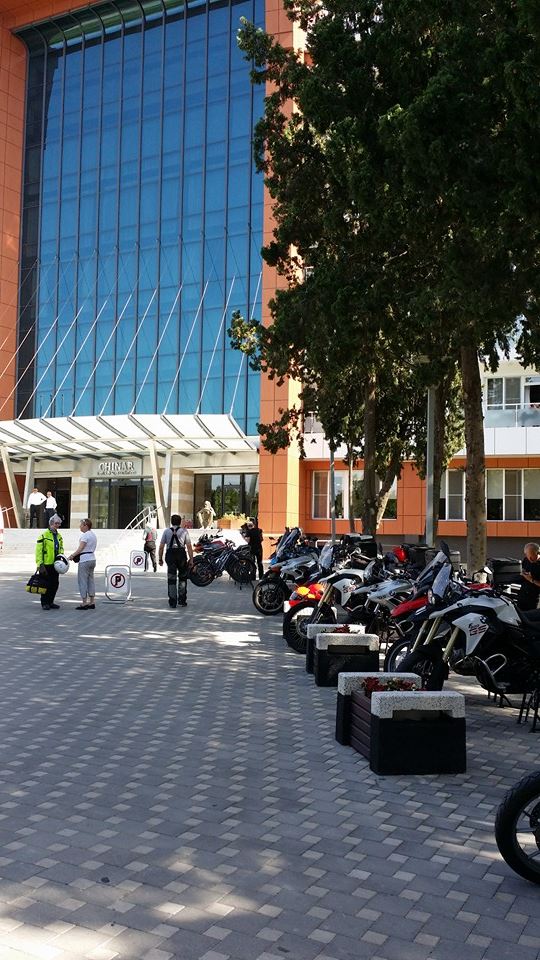
Above: 27 June 2014. Bikes ready to go, Chinar Hotel and Spa, Naftalan, Azerbaijan.
Some of our tour participants, including Skip Moscorro, owner of the motorcycle touring company, MotoDiscovery, which is handling our tour, took the oil bath treatment earlier in the morning. Despite the fact that he now smells like turpentine (not), he says the treatment softened his skin.
The Naftalan spa is known for oil baths where the bather immerses herself in a bathtub of crude oil. The treatment, apparently is therapeutic, using Naftalan oil, a form of crude oil not used for further refinement into fuel or byproduct. The practice of oil bathing was started by visiting Russians during the Soviet period.
Mwah (sic) passed on the treatment. Full nude body clean up by handlers after the bath spooked me.
The day would entail a fairly grueling 200 mile ride to Baku... grueling, mainly because of a 10 mile long construction project requiring riding in mud, loose rocks, some recently graded, "really loose rocks and dirt," ruts, corrugated tarmac in heavy dust, with beaucoup unruly oncoming traffic. It was like a scene out of "Mad Max - Road Warrior." TIMDT, riding pillion, was a trooper... knowing this condition in advance, I would have sent her in a taxi... but she made it and kept a stiff upper lip. I was proud of her.
Riding into a large city is always interesting. Traffic is usually heavy, so riders bunch up to stay close to the leader, in this case, leader Kaz, of Kazoom Moto Adventures, Istanbul (co sponsor of our trip with Skip Moscorro and MotoDiscovery)... so as to not get separated. In degree of difficulty for city entering, in my own experience, Baku ranks fifth. From first to fifth: Palermo, Dar es Salaam, Guwahati, Paris, Baku. Honorable mention... Saigon, Marakkesh, and Adis Ababa, Lusaka.
Temperature peaked at about 95 degrees during the ride. Squint... and the terrain could have been Utah or Wyoming desert.
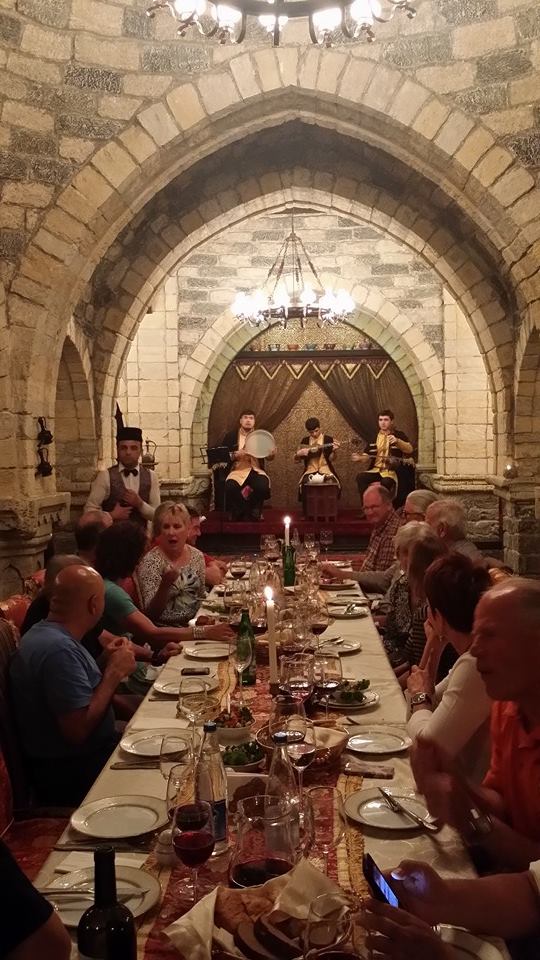
Above: 27 June 2014. Our group dines on Azeri food and listens to traditional Azeri music at Sivansah restarant, Baku, Azerbaijan.
Tour organizer, Skip Moscorro, MotoDiscovery Tours, invited a friend to join our group at dinner. He was head of the US Peace Corps in Azerbaijan.
My interpretation of our dinner discussion... he was seated across the table from me... was that there are three forces rushing in to fill a vacuum left by waning US influence in Azerbaijan. Whabbism, Iran (Shiite-ism [sic], and Russia.
The Peace Corps operation budget for Azerbaijan has been cut in half over the last two years. The budget for the entire Peace Corps is a half billion dollars, a rounding error for US government expenditure.
Accompanying the Peace Corps guy at dinner were two of his colleagues. One of them... lets call her Jenny... had just that day completed a three year tour teaching English in poor, rural villages.
The other was... lets call her Ruth...was the administrative head of Jenny and one hundred other Peace Corps volunteers in Azerbaijan. I think she was a paid Peace Corps employee, not a volunteer.
After dinner, Jenny and Ruth each addressed the group.
Jenny seemed spirited, committed.... there is no doubt in my mind that she likely made a positive impact on Azerbaijanis with whom she came in contact.
Ruth, after praising Jenny for her service, expounded on programs the Peace Corps was supporting in Azerbaijan. One was "sports for development." Our ROMEO group in Park City, La Societe Deux Magots, recently had a speaker who had done a comparative study on girls sports for development programs in Cambodia, Argentina, and Kenya.
The ROMEO group speaker talked about how cultural differences impact each program. Cambodian girls, for example, wanted to play outdoor sports with all of their skin covered and under wide brimmed hats. They were worried about their skin darkening. When the US sponsors urged the girls to use sun screen and play in more typical (western) sports garb, the girls turned against the sponsors claiming that the sponsors were plotting to eliminate a practice they considered culturally appropriate.
Given more time I would have liked to ask Ruth about the Azerbaijani girls sports development program, and how, if at all, cultural factors influenced how the program was run.
I was wistful as I listened to these eager, idealistic women, who, no doubt were, on an individual basis, accomplishing a lot.
The central energy source for the Peace Corps, however, once a bright burning flame ignited by John F. Kennedy in 1962, now flickers as the US has apparently decided - looking at budget numbers for one - that projecting its values abroad is no longer a priority.
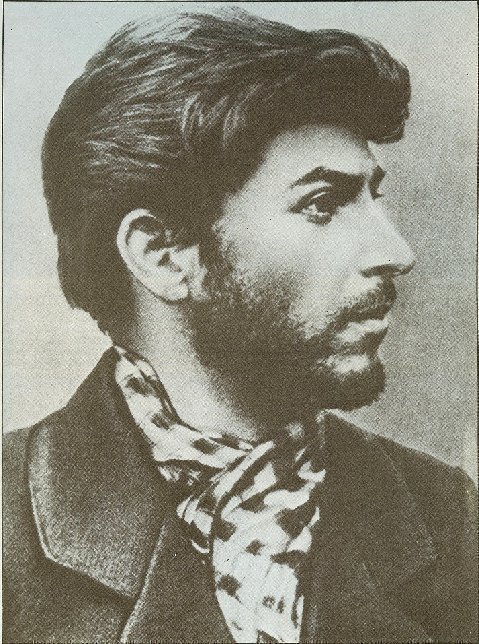
Above: Young Stalin. Baku days.
On 27 June 1907, Josef Djugashvili, aged twenty-nine, later known as Stalin gained, for the first time, the attention of the world, by engineering the Tiflis (now Tiblisi), Georgia, robbery of the Tsar's cash shipment to pay his Cossack soldiers. The robbery was carried out by Stalin and fifty of his followers as the cash shipment, guarded by Cossack horsemen, reached Tiflis' central Yerevan Square. 50 people, innocent bystanders and fome of the Tsar's Cossack police, were killed in what amounted to a terrorist action.
The Tsar's police never found the robbers or the money, $3.5 million in current dollars. Some of the stolen money was even laundered through Credit Lyonnais in Paris, before finally reaching V. I. Lenin who was then headquartered in Helsinki.
The next day, 28 June 1907, Djugashvili, Kato, his wife, and his newborn son, Yakov, left Tiflis to cross the southern Caucusus mountains for the oil-boom city of Baku. In 1900, the Caspian oil fields near Baku produced half the oil used in the world.
Our intrepid group of motorcyclists would reach Baku today, 27 June 2014, almost exactly 107 years after Stalin arrived. Stalin would find the Caspian oil and for the next seveal years do everything he could to disrupt the Tsar's access to it. We motorcyclists would see a beautiful city, on the rise, connected to the world, culturally and economically, fueled by profits from the same oil fields Stalin sought to interdict.
Stalin settled Kato and Laddie (Yacov), their baby, in the apartment of an oil worker and plunged himself into a life of banditry, espionage, extortion and agitation, the murkiest years of his entire career. Probably again on the Rothschild payroll, he soon moved his little family outside Baku city into a "Tartar house with a low ceiling on the Bailov Peninsula which he rented from its Turkish owner," right on the seaside.
Kato, a born homemaker, made the shack cozy, with a wooden bed, curtains and her little sewing-machine in the corner. Visitors noticed the contrast between the sordid exterior and the tidiness inside - but Soso was not often there.....
Always dressed in his trademark black fedora, Stalin gave a speech on 27 June 1907, the very day he arrived, and threw himself into his editing of the two Bolshevik newspapers, Bakinsky, Proletary and Gudok (Whistle); he immediately set about dominating the Party there with his brand of aggressive politics, terrorist intimidation and gangster fund-raising.
Everywhere in Russia, "The reaction had triumphed, all liberties destroyed and revolutionary parties smashed," recalls Tatiana Vulikh, but Baku, ruled as much by the oil companies and corrupt policemen as by the Tsar's governors, followed its own rules. Stalin was on the run in Tiflis but for a few months before Stolypin's next crackdown he could stroll the Baku streets. Tiflis, said Stalin contemptuously, had been a parochial "marsh" but Baku "was one of the revolutionary centres of Russia," its oil vital to the Tsar and the West, its workers a true proletariat, its streets violent and lawless.
Baku, wrote Stalin, "would be my second baptism of fire."
"Young Stalin," Simon Sebag Montefiore.
27 June 2014 Addendum part 1:
I love your daily reports and am reading & savoring every word! It is killing me that all of my friends are enjoying this adventure and I can only read & learn about it from you. I really appreciate the updates, history and factual content. I have been to many of the places the group have visited, but I never made it into Armenia. Got close:
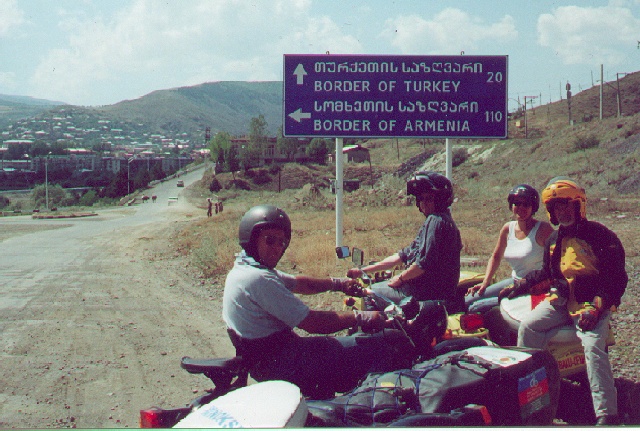
I have a very serious book that I am going to search out in my library and ship it to you in Park City all about the Caucuses. It is non-fiction.
You know, you might actually make the effort to publish a book as you have already written 11 chapters… seemingly without effort!
As I look back on that trip to Morocco when you said that you were interested in visiting obscure lands, I guess we have a similar perspective, eh?
Isetta, Chicago, IL
Thanks for the book... and for presiding at the marriage between my wanderlust and the motorcycle.
27 June 2014 Addendum part 2:
When I was a kid in Mesa, AZ there were two Armenian families that I knew and went to school with. This was in the late 30's and during the 40's. Their names were Saba and Basha. The Saba family had a department store and the Bashas had a grocery store which developed into a chain of stores in Mesa, Phoenix, Scottsdale and Chandler as well as Tempe and Glendale. They were very industrious families and all family members worked in the business. All were good citizens and well thought of. Thanks for the great history lessons of Armenia, Georgia and now I expect from Azerbaijan .
Aunt Joyce,
Ashland, OR
great stuff again. thanks. Cher is an Armenian American but claims she is Cherokee:) Kardashians are also Armenian American as is gallery owner Larry Gagoshian.
brand man,
venice, ca
Thanks. Fascinating stuff. I once met William Saroyan in Manila, Philippines who was attending a conference of some sort. Our landlady had recently written a book and her husband somehow gotten Saroyan to attend its book launching.
Spook,
Reston, VA
Steve,
Just wanted you to know how much I enjoy and learn from you trips. We love to travel and do so each chance we get.
Keep on enjoying life!
Havana,
Miami, FL
I am reminded of Steve Pinto’s definition of a Sindhi: Someone who can buy an item from a Jew, sell it to an Armenian, and still make a profit.
Tevye, Mawah, NJ
The Sindhi's have evolved even further now Bergersan.. with
global competition..
they buy from the Jews, do sequential transactions to
the Armenians, Scots, Dutch and still come out with a Profit !!
Pinto,
Dubai
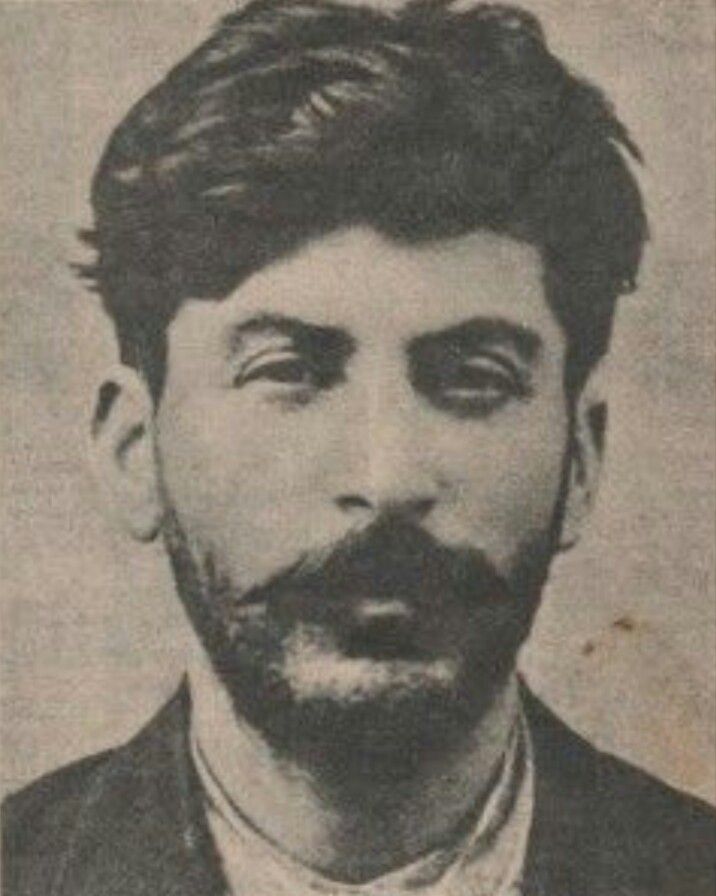
Above: Young Stalin. Early 1900's. Baku days.
On Sunday, 09 January [1905] when Stalin was in Baku again, the revolutionary-cum-police-agent-agent Father Gapon marched at the head of 150,000 hymn-singing workers to submit a Humble and Loyal Petition to the Tsar at the Winter Palace in Petersburg. Cossacks blocked the way. They fired two warning salvoes, but the workers continued to advance. The troops fired on the crowd, and then charged. Two hundred workers were killed, and hundreds more wounded. "There is no God any longer," murmured Father Gapon. "There is no Tsar."
Bloody Sunday shook the Empire, unleashing a tempest of demonstrations, ethnic massacres, killings and open revolution. Strikes mushroomed across the Empire. Peasants burned the palaces and libraries of their masters - 3000 manor houses were destroyed. The unrest spread to the army. "The Tsar's battalions," wrote Stalin in an article, "are dwindling, the Tsar's navy is perishing and now Port Arthur has shamefully surrendered - the senile decrepitude of the Autocracy is revealed again." But the Tsar still hoped for a miracle. In one of the most extraordinary navel ventures in history, he sent his leaky Baltic Fleet to almost circumnavigate the globe, via Africa, India, Singapore, to fight the Japanese. Had the gamble succeeded, Nicholas II's victory would have resounded down the ages.
"Young Stalin," pp 126.
Simon Sebag Montefiore
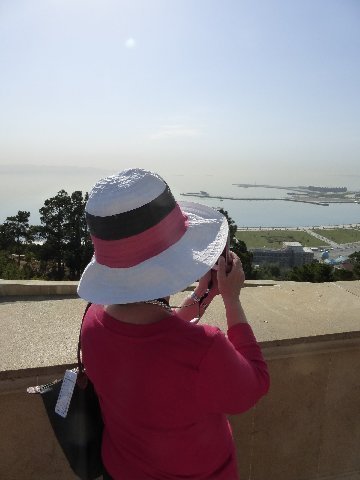
Above: 28 June 2014. TIMDT surveys the Caspian Sea from Martyrs Monument hill. Baku, Azerbaijan.
Caspian Sea. Largest enclosed inland body of water on earth by area. No outflows. Hundreds, if not thousands, of inflows. The mighty Volga River is the Caspian Sea's largest feeder. Loses water by evaporation. Bounded to the northeast by Kazakhstan, to the northwest by Russia, to the west by Azerbaijan, to the south by Iran, and to the southeast by Turkmenistan. Salinity of 1.2%, about a third the salinity of seawater.
TIMDT and I visited another lake with inflows and no outflows about 2 months ago. Crater Lake, in southwestern Oregon. Crater Lake loses water (outflow) via seepage through limestone rock which emerges as springs in lower elevations.... and evaporation.
It seems a bit strange to be standing here looking at the Caspian sea. Notwithstanding my racking up over 100 countries visited over my lifetime, the Caucusus (Georgia, Azerbaijan, Armenia, southern Russia) were off my radar screen. I could draw a map of North and South America, the Far East,... Europe, and, broadly, Africa. The Caucusus, and the "stans" to the east, on the other hand, are difficult to fix. I'm really happy to be here to see this area for myself... to have it register as "real" and more understandable.
Its not our first trip to central Asia, however. In the mid-80's TIMDT and Mwah (sic) visited Bukhara, Samirkand, and Tashkent (dash-KENT) in Uzbekistan, then part of the Soviet Union. Uzbekestan is 1000 miles to the east.. it does not border on the Caspian.
The best caviar comes from sturgeon who inhabit the Caspian. Iran is the best known producer of caviar... but, Azerbaijan also "farms" sturgeon for caviar production.
Having TIMDT join this trip is also great. She has been a good trooper riding the motorcycle with me from Trabzon, Turkey, to Baku... a big deal... especially considering the rough construction project she rode through yesterday. Yesterday, also, was the first heat... 95 or so degrees. Obviously, the heat dissipates when the bike is moving quickly... but, coming into Baku, traffic increased, the bikes slowed.. and the heat intensified. Kudos to TIMDT.
I love riding a motorcycle over distance... seeing new places... different places... new faces.... new landscapes.... new stories.... hot or cold. Snow and ice stops it... but, not much else. Burt made it exponential.
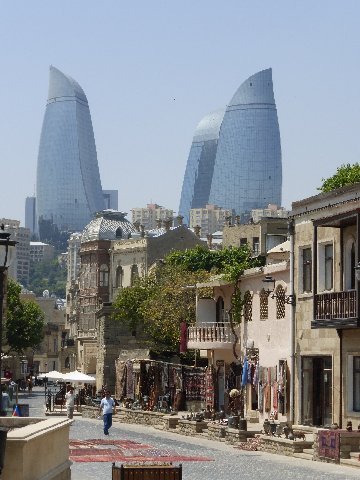
Above: 28 June 2014. Flame Towers. Baku, Azerbaijan.
Flame Towers is the tallest skyscraper in Baku, Azerbaijan. The buildings consist of apartments, a hotel, and office blocks. The buildings were completed in 2012. In the evening the facades of the Flame Towers are turned into giant display screens with the use of more than 10,000, high power, LED luminaries.
According to a poll of skyscrapercity.com, an influential urbanistic forum, the Illumination of Flame Towers designed by HOK was acknowledged as the best in the world. The Flame Towers are completely covered with the LED screens that display the movement of a fire visible from the farthest points of the city. This illumination creates the effect of giants torches emphasizing the main idea of Flame Towers incorporated in their name (Wikepedia).
My image, above, shows the towers co-existing with old Baku. The transformation of Baku, from just another stop on the Silk Road to a vibrant, seemingly progressive city, seems incredible. Baku. Oil. Enabled by the Nobel brothers and the Rothschilds. A breeding ground for anti Tsar terrorists and Bolsheviks. Coveted by Hitler for its oil. Now home to one of the signature architectural statements in the world. Joins such city signatures as the Eiffel Tower, the Sydney Opera House, and the Statue of Liberty, Flame Towers.
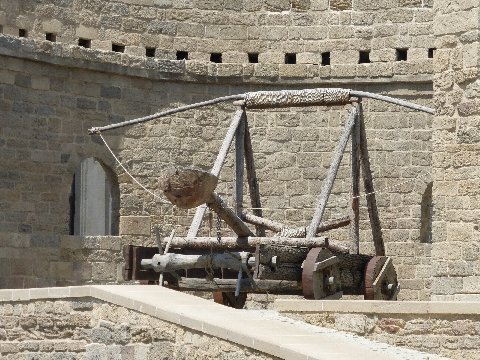
Above: 28 June 2014. Catapult in Azerbaijan "Old City."
Our MotoDiscovery/Kazoom MotoAdventures group toured the Palace of the Shirvanshas in the "Old City." The palace was the seat of northeastern Azerbaijan's ruling dynasty during the Middle Ages. Mostly 15th century in essence, the old city was restored in 2003.
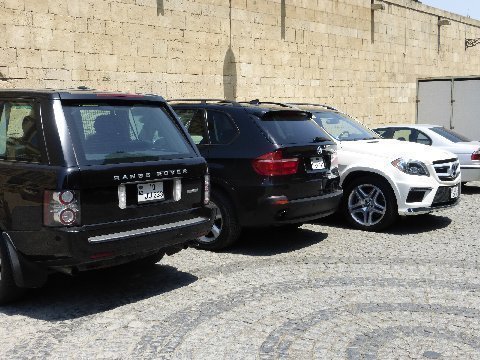
Above: 28 June 2014. Land Rover, Beemer, and Merc SIV's. These cars were common in Baku.
Georgia, Armineia, and Azerbaijan have made big economic strides since the 1990's, especially Azerbaijan which is riding a boom based on exporting its Caspian Sea oil to the West.
Throughout the region there is a gulf between those who gain from the new economies, typically the well-educated, well-connected urbanites working in the private sector, along with powerful bureaucrats and politicians, and those who have been left behind (the older, the unqualified, government employees and those in the country side).
Many older people look back nostalgically to the late Soviet era when there was a job and security for everyone.
I recall the words, three or four days back, of our Armenian guide, Vilena, about Armenian economic conditions today: "When we were part of the Soviet Union, we had jobs...there was lots of money, but nothing to buy. Today, you can buy anything... but, there are no jobs and no money." It appears to be the same in Azerbaijan. Though, because of The Caspian Oil, Azerbaijan's economy is growing faster and unemployment lower than in its sister Caucusus countries, Armenia and Georgia.
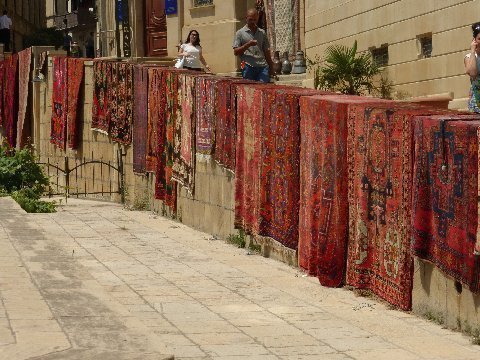
Above: Azeri carpets on display, Baku, Azerbaijan. 28 June 2014.
In November 2010 the Azerbaijani carpet was proclaimed a Masterpiece of Intangible Heritage by UNESCO.
TIMDT and Mwah (sic) own two or three putative Azeri rugs.
TIMDT suggested that the carpets on display in the image were new, poorly made carpets placed in the sunlight to make them look aged. And, there's the rub... its really hard to tell what is a true antique carpet and one that has been "antiqued."
Our carpets are Kilims, the most widespread of Azeri flat weave carpets.

Above: 28 June 2014. The Bishop stands in contemplative pose aside the bust of Aliaga Mammadgulu Iskanderov (Vahid).
Sculptors: Rahib Hassanov, Natig Aliyev, Sanam Salamzadeh
Aliaga was a famous Ajeri poet. "Hints of Greed" published in 1916. He is Azerbaijan's master of satyric poetry.
Zoom in on Vahid's head. Note that the "hair" is comprised of mini sculptures of humans living life. One one side of the head... the humans are sad and struggling. On the other side of the head, the humans are elated... moving forward.
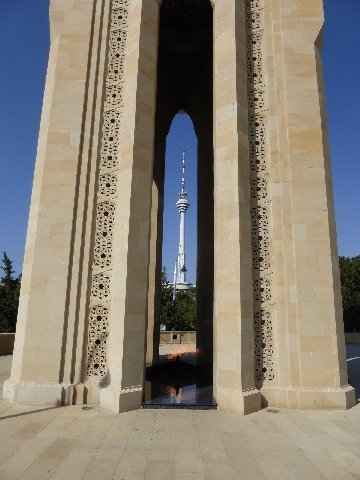
Above: 28 June 2014. Eternal Flame monument - Sahidler Xlyabani (Martyr's Land). Through the niche, Baku's highest point, a communication tower.
Nearby is a somber row of grave-memorials for Bakuvian victims of the Red Army's 1990 attack and early martyrs of the Karabakh conflict. There is also a memorial to Turkish WWI soldiers, and to British and Commonwealth troops killed fighting them.
The monument area is elevated above the city and offers spectacular views of Bayfront Park and the Caspian Sea.
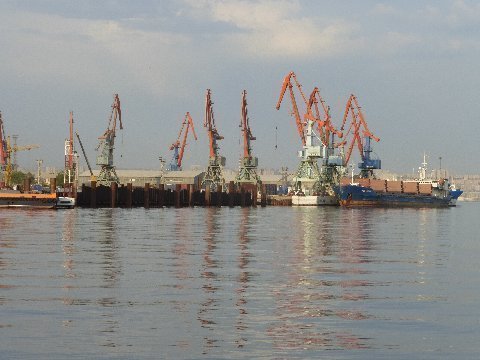
Above: 28 June 2014. Cranes, Baku harbor.
There is shipping on the Caspian sea. In 1954 a canal was built between the Volga and Don Rivers, in Russia, which enabled goods from countries on the Caspian, mainly Iran, to reach, via water, Black Sea and Mediterranean ports.
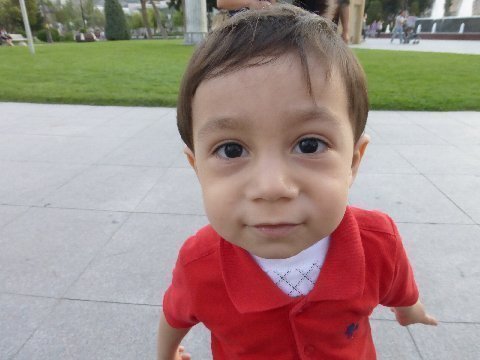
Above: 28 June 2014 Azerbaijani boy, Seafront Park.
TIMDT and Mwah (sic) were seated on a bench in Sea Front Park waiting and watching for the illumination of Flame Towers to begin.
The boy pictured here walked up to me and handed me a tiny grass flower from the nearby lawn. I looked across the walk and saw his mother and grandmother smiling in our direction.
Seafront Park was packed with families walking, kids on roller blades and vendors.
I wonder about the little boy's future. Will he know conflict and strife, which has been the lot of many of his ancestors... or will Azerbaijan remain a peaceful part of the world?
Azerbaijan is a Muslim country, but, it seems the most secular of the Muslim countries I have visited.. at least here in the city, that is. Even more so than Turkey. A few women cover their hair and wear long skirts... most do not. None, unlike the Saudi women we saw a couple of weeks ago at Trabzon airport, are fully covered in a hijab. I have not seen close-up the villages of Azerbaijan, where, I suspect, practice of Islam is stronger.
The Soviets for 80 years worked hard to suppress religion and it looks like they did a pretty good job in Azerbaijan. Conversely, in neighboring Armenia, the Armenian Apolstolic Church seems to have fared better under Communism than Islam has done in Azerbaijan.
As we learned in our discussions last night, however, Wahabbism, from Saudi Arabia, and Shiitism from Iran, along with growing Russian moves for hegemony in the region, are all rushing to fill the vacuum left by a diminishing United States influence in Azerbaijan. So... I would expect more outward Islamic affiliation to reassert itself over the coming decades in Azerbaijan.
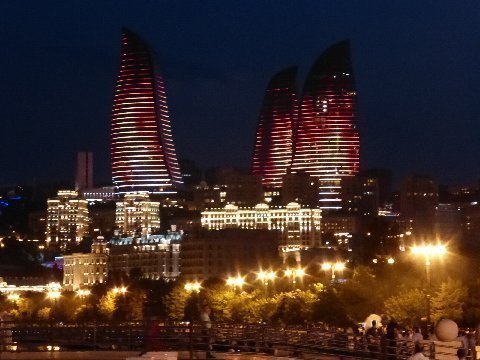
Above: Flame Towers at night. As seen by Mwah (sic) and TIMDT, from Seafront Park. Baku, Azerbaijan. 28 June 2014.
28 June 2014 Addendum:

Above: Looks like Kathy made it to the top of Africa early this morning (red jacket, front row). Uhuru Peak on Mt. Kilimanjaro. 19341 feet.
Guzzi,
Park City, UT
Way to go Kathy!
Steve,
I have just returned from a not-quite 200 mile bicycle trip along Ireland's southwest coast. I am now catching up on your wonderful narrative and, as with so many of your fans, am delighted to read your historical & anecdote-filled accounts. It looks as though you may be beyond sheep grazing country at this point, but I want to share with you some driving instructions we encountered in Ireland. Beware the Sheep Assassins!! Read on....
Mrs. Driggs,
Salt Lake City, UT
Interesting response from Jenni.
---------- Forwarded message ----------
From: "Smith, Jenni" <[email protected]>
Date: Tue, 1 Jul 2014 15:56:24 +0000
Subject: RE: Possible Closing???
To:
Hi Tom,
I absolutely appreciate and understand your concern. I hope that you
will hang in there with us, I feel strongly that we will be open for
the coming season. We still have some road to travel before it's
over. We will see if some sort of resolution will come out of the
mediation, positive thinking!!
IF the unthinkable happens we will refund season passes and lockers
through an online process, which we are working through right now as
part of a contingency plan.
Best,
Jenni
Jenni Smith
President and GM
Park City Mountain Resort
(435)647-5405
________________________________________
From:
Sent: Thursday, June 26, 2014 8:53 AM
To: Smith, Jenni
Subject: Possible Closing???
Many of us renewed our season passes, as well as locker renewals for
the 2014-2015 season this past April. But with all the press and
rhetoric about a possible closing, we are getting very concerned.
In the event that the unthinkable happens, PCMR doesn't open, How and
when will refunds for season passes and locker renewals be handled?
TWO3
Park City, UT
The deterioration of the Park City brand continues apace.
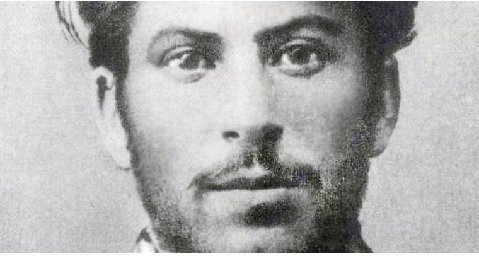
Above: Young Stalin
As early as the middle of the 19th century, oil was extracted to the surface through wells on the territory of Dagestan. With the participation of Swedish oil industrialist Ludvig Nobel, several relatively shallow oil wells were operating in Dagestan by the end of that century. Yet it was only in the 1920's that systematic studies of the geology of the foothill areas began in earnest, and in 1924 the drilling of deep exploratory wells commenced. In 1936 the first trainload of oil left the Izberbash railway station. In January 1937, in accordance with the order issued by the People's Commissar of Heavy Industry Sergo Ordzhonikidze, the Dagneft Trust was established. The same year marked the introduction of well drilling under the sea shelf. Dagestan's oil played an important role in supplying the frontline with petroleum during World War Two, and especially during the period when oil wells near Grozny stood idle.
According to specialists, the first veto on Dagestani oil reserves was imposed by Stalin. Stalin's government intentionally kept the volume of oil extraction low in Dagestan, The last time oil was extracted to the maximum possible volume was in 1942 when Nazi forces strove to make it to the Volga River. Stalin again halted oil extraction by the war's end, although later geological prospecting works were carried out and new oil rigs were erected.
From Prospects for Dagestan's Oil and Gas Industry
by Mikhail Roshchin
Global Research - The Jamestown Foundation
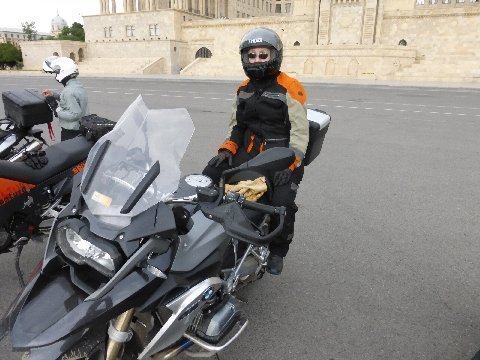
Above: 29 June 2014. TIMDT, ready to ride pillion from Baku, Azerbaijan to Derbent, Dagastan, Russia. Azadlik Square. Baku, Azerbaijan. Destination, Derbent, Dagastan, Russia.
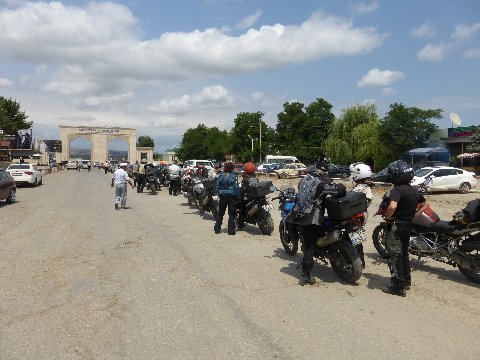
Above: 29 June 2014. MotoDiscovery riders wait on Azerbaijan side at border crossing with Russia (Dagastan).
After arriving at the border at 11:00 AM, we did not make it to the gate, opening into the Azerbaijani border control area, (see image) until 1:00 PM. In the two hours of down time, group members changed money to get some rubles, drank tea at nearby cafes and otherwise found ways to kill time. I played a couple of rounds of candy crush... level 185.
Then Mwah (sic) about stymied the whole trip for everybody.
When we motorcyclists were ready to go through the gate into the customs area, a uniformed Azerbaijani border control agent went from motorcycle to motorcycle to pre-check our paperwork. I searched the plastic bag where I carried my papers, but, could not find my Azerbaijani visa (scroll for image of my Azerbaijani visa).
Azerbaijan, Turkey, and Armenia no longer require visas to be entered into one's passport. Rather, you can apply electronically, at home, before traveling, make a payment by credit card of ten or twenty dollars, print off a hard copy of the visa once it is issued, and include it with your travel documents.
I went through my stuff fully three times... the visa wasn't there. Of course, I had the visa coming in to Azerbaijan. I'm generally pretty assiduous in keeping my travel documents in order. I must have let the visa inadvertently drop out of the bag, or not picked it up off my desk when I left the oil bath spa in Naftalan.
One would think that once I was in the country, and now wanted to get out, that the visa would be superfluous. But no... on the visa is a bar code that the officials need to swipe with a scanner to cancel out the entry swipe of the same visa used days earlier to get into the country.
After delaying our group's entry into the border processing area beyond the gate for about 10 minutes, the Azeri border control guys were instructed, via radio communications with their superiors, to let me proceed with my fellow group members into the border control area beyond the gate.
After parking my bike at the border control point, under a canopy, with offices to the side, Kaz, our Turkish tour leader, and head of Kazoom MotoAdventures, Istanbul, beckoned me over to see the "in charge." "In charge" was dressed in green/black, camo. His sleeves were rolled up and held secure by a buttoned flap. "In Charge" was a balding, early 50's, stocky fellow with black, bushy eyebrows. He reminded me of the French comic in the 60's and 70's Louis de Funes. Underneath his authoritative demeanor there was a sense of humor. Of course, I could not speak Azerbaijani, which overlaps with Turkish about 80%. But, I observed, as he spoke to Kaz, and those of his employees standing around that he had a sense of theater with his arms gesticulating with an occasional smile escaping his otherwise stern facade.
As I stood listening to the incomprehensible Azerbaijani/Turkish exchange, sensing his attitude as one who is truly in charge and confident of his position, I decided to try some obsequiousness. I walked up to "In Charge, looked at him, bowed my head a bit, and said. "I'm sorry... I'm very, very sorry."
"In charge," replied, in English, looking first at me, then at my passport, then back at me, then back to my passport, "problem... this is problem.... problem.... problem."
"In Charge" opened my passport. "Utah!" he said, "Utah Jazz!"
I thought to myself that this man may, in fact, have a problem... but, he's also putting on a bit of a performance... he was on stage and enjoying his role. Because of his seeming insouciant demeanor I began to have a bit of hope we could get out of this.
Kaz would come up with the solution to "the problem," though.
Standing right there at the Azerbaijani/Russian border, under the Azerbaijani border control canopy, Kaz, on his Samsung Galaxy Note III smart phone, placed a call to the hotel where we stayed in Naftalan (the oil bath place) two nights ago. There we were required to submit our Azerbaijan visas which had been photocopied by the hotel.
The hotel scanned its copy of my visa and emailed it to Kaz... right then and there... as we were talking. Kaz showed the copy of my visa, clearly visible on the large screen of his phone, to "In Charge." "In Charge" lit up. He used his I-Phone to capture an image of my visa directly from the screen of Kaz's phone. Actually, you had to see it to believe it... these two men holding their phones together, an inch or so apart and transferring the image of my visa from one phone to the other!
"In Charge" went to the office, picked up the scanning wand that would have actually scanned my visa bar code off of my original visa copy. He enlarged the bar code on the visa image on his phone, and scanned the bar code right off of his smart phone screen. He looked up... smiled... it had worked, calling up the record of my entry into Azerbaijan three days previously.
He told Kaz that he thought he could get me through as his test scan had worked. As "In Charge" came out of his office he was smiling. I walked up to him, bowed a bit, and said "thank-you very much."
But, without Kaz legerdemain solving the problem, electronically, in this way, I would have been in "no man's land" for some time and, because, Kaz and Skip (MotoDiscovery Head) would not break up the group, my inattentiveness to keeping my travel documents in order could have stymied the trip for everyone.
Kaz suggested that if I had something from Utah, I might want to present him with a gift. I immediately thought of my Deer Valley cap and asked Kaz to check with "In Charge" about the appropriateness of making the gift.
Kaz asked "In Charge." Standing at a distance, I could see "In Charge" smile, so I went to retrieve the cap out of the luggage case of my motorcycle.
I made the presentation of the cap to "In Charge," who received the cap with a bright smile on his face. I said, "Deer Valley is a very famous US ski resort in Utah. Google it, and you will see."
"In Charge," looked back at me and said, "Google... OK... google."
"In Charge" put the cap on and smiled to his colleagues and underlings.
Now we could move forward through the Azerbaijani exit process. My friends all lined up at the window where the officer was processing our papers.
Then, "In Charge" asked me for my passport again. Kaz said he needed to run the solution for my exit from Azerbaijan by his superior, a similarly dressed guy, thinner, with a mustache, who had just showed up. Ummm, I thought. Maybe we're not home free after all.
Then our group was all asked to line up at the window to have our exits processed. We would need passports, Azerbaijani visas, and for those with motorcycles, "moto passports"... the carnet having registration papers and border cross transfer authorities for the motorcycle.
When I arrived, last, at the processing window, the processing officer had my passport. He called out for "In Charge" to join him. "In Charge," picked up the visa bar code scanning wand in one hand, had his I-phone in his other hand and held them both head high. He made sure that I was looking at this "performance." Then he saw that Kaz was not there. He said, "Turkish... Turkish...." Ahah... he wanted Kaz to see this performance. I called Kaz over and together we watch "In Charge" theatrically align the wand against the bar code from my Azerbaijan visa on his I-phone. Voila! It worked. "In Charge," smiled, and nodded his head with self satisfaction.
There was another step to this electronic process. "In Charge's" supervisor had said they should get a hard copy of the visa. Kaz got out a USB cable from his motorcycle tank bag which he used to link up his I-phone with the printer in the printer in "In Charge's" office. And, again "voila," a hard copy of the visa was produced..
All processed... we made it through Azerbaijan border control... the process took about two hours... My faux pas added thirty minutes or so to the ordeal. Four hours, including the two hour wait outside of the gate, to get out of Azerbaijan.
We cross no mans land. Then another five hour wait at Russian border control. Nine hours total to get across the Azerbaijan/Russian border. Book it your next tour. Border crossing! The principle event of the day! A nine hour culture appreciation delight!
PS. I am indebted to Kaz for his highly skillful handling of this incident caused by me, which could have left the group in "dire straits," without the skillful solution he engineered together with "In Charge."

Above: 29 June 2014. My Azerbijani visa. Scanned copy of my visa sent by Chinar Hotel and Spa, Naftalan, Azerbaijan, sent by hotel, via email, at the border crossing between Azerbaijan and Russia... on the road from Baku... to Derbent, Dagastan, Russia.
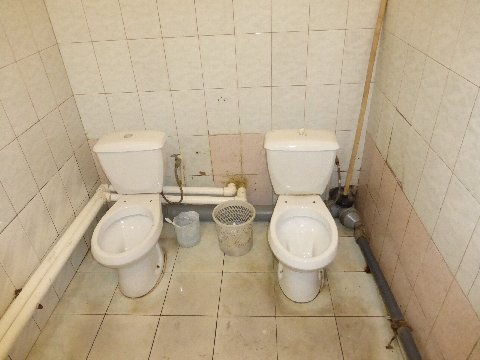
Above: 29 June 2014. Twin toilets in men's room of Russian border control building. On the road from Baku to Derbent on the Russian/Azerbaijani frontier. Two for the price of one.
Five hours at Russian border control.
1. Unload baggage from van... take through luggage scanners
2. Fill out entry and exit cards (exit cards to be used on departure from Russia).
3. Register motorcycle documentation.
4. Go through passport control.
5. Sit, one by one, for 15 to 20 minutes each, with one hardworking guy who was data entering, by computer keyboard, everything from our home towns, motorcycle VIN numbers, and passport information.
I would characterize Russian border control on the Azerbaijani frontier thus: Bureaucratic, terribly inefficient, but not unfriendly. All of the people we saw in the above process smiled and seemed to work hard. It was the process they were following that was incomprehensible.
Tour organizers, with our assent, had decided to get a car and a Russian guidguide at the border to join the Peugeot, luggage, spare parts carrying van following behind for the entire tour, driven by Kaz's brother Ihan.
TIMDT rode the 40 miles to Derbent in the hired car with other erstwhile pillion riders, Esther, Girl Scout, Nancy. The car left an hour and a half before Kaz, Mwah, Shock, and Skip rode, starting about 9:00 PM, in the dark, towards Derbent, Dagastan.
Derbent Deluge
Riding towards the city, we could see lightning indicating a thunderstorm ahead. By the time we reached Derbent, we four motorcyclists were riding in a deluge. Derbent is built on seaside land that angles down from heights to the west, to the Caspian Sea, to the east. The Durbent streets running west to east were turned into virtual rivers. No city drains in Derbent. Its not particularly difficult riding on hard surface with running water... but, you never know where there is a pot hole or a speed bump. Add to the difficulty of running water in the streets, the fact that its dark... and raining... and that you are relying on Kaz and his GPS to get you to the hotel in an unknown city... and, you've got your own little mini--adventure going on, all after a 9 hour stop at border control. Been there done that once before. Abancay, Peru, 2000.
The hotel itself, notwithstanding accurate GPS coordinates, was a bit difficult to find in the rain, in the dark. But, Taos and Petrolia, who had left ahead of us, had their motorcycles positioned, lights shining in the direction from which we would be riding, to mark the spot of the hotel driveway. We were very grateful for the effort they made helping us locate the hotel.
29 June 2014 Addendum:
The man who first dragged me to Baku in 2000 was writer Thomas Goltz who has been living and working in the Baku and Yerevan. He has written several books that included interview with the various political leaders of Azerbaijan, Armenia, Chechnya, Dagestan & Georgia. I have read several of them and found them to be enlightening. Hey, his last listing suggests that it covers our 2000 Oil Odyssey!
Spelling corrections always wellkum.
As Tom Lehrer said:
‘Old times there are not forgotten,
Whuppin’ slaves and sellin’ cotton,….
Tevye, Mahwah, NJ
Isetta, Chicago, IL
I'm gonna look for the books. Thanks for the tip.
Dear Steve,
Your photo-tour of Baku reminded me of my stay there, in 2002, when we, having time to kill, went out to the northeastern part of the Baku area to visit a natural gas flame that has been burning since time immemorial as a result of a natural gas seepage from the interior of the earth. As this flame can’t be extinguished, the Nazis used it as a bombing beacon to guide their bombers onto their Baku oil field bombing runs during WW II.
From your photos, the city sure has changed in 12 years.
I am enjoying your photo journey.
Thanks,
AhnRhee, Larkspur, CA
"In one of the most extraordinary navel ventures in history . . . "
No doubt.
With a smile,
Feenix, Phoenix, AZ
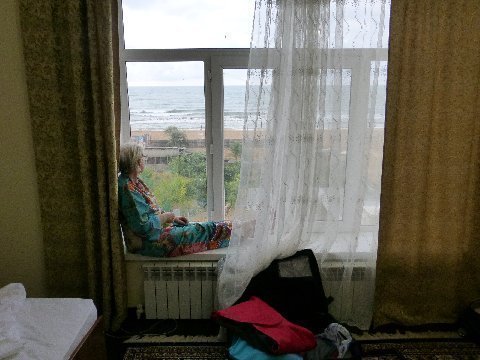
Above: 30 June 2014. TIMDT contemplates the Caspian Sea from our Derbent, Dagestan, Russia, hotel room. Dvor Hotel. Kazakhstan, 400 kilometers, that way!
No deluge this AM... but, still, the skies seem to portend more weather.
Dagestan population 2.9 million, is a republic of Russia, a federal subject, located in the north Caucasus. Dagestan is ethnically diverse... it is Russia's most heterogeneous republic, where no ethnic group forms a majority. There are several dozen ethnic groups living in Dagestan, but, most speak Caucasian and Turkic languages. Most Dagestanis speak Russian, which is the lingua franca among the ethnic groups.
Dagestan has been a scene of low-level Islamic insurgency, occasional outbreaks of separatism, ethnic tensions and terrorism since the 1990s: According to International Crisis Group, the militant Islamist organization Shariat Jamaat is responsible for much of the violence. Much of the tension is rooted in an internal Islamic conflict between traditional Sufi groups advocating secular government and more recently introduced Salafist teachers preaching the implementation of Sharia law in Dagestan.
(source Wikepedia)
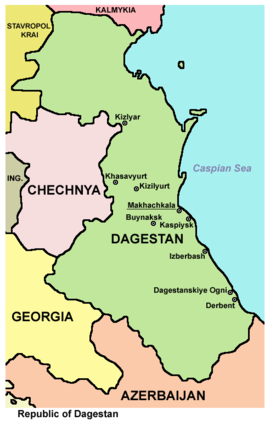
Above: 30 June 2014. Regional map showing location of Dagestan.
Derbent is the southernmost city in Russia.
Population 120,000.
Derbent occupies the narrow gateway between the Caspian Sea and the Caucasus Mountains connecting The Eurasian steppes to the north and Middle east to the south. Often identitied with the legendary gates of Alexander, Derbent claims to be the oldest city in Russia (8th century BCE).
Since antiquity, the value of the area as the gate to the Caucasus has been understood, and Derbent has archaeological structures over 5,000 years old. As a result of this geographic particularity, the city developed between two walls stretching from the mountains to the sea. These fortifications were continuously employed for a millennium and a half, longer than any other extant fortress in the world...
In 654, Derbent was captured by the Arabs, who transformed it into an important administrative center and introduced Islam to the area. Because of its strategic position on the northern branch of the Silk Route, the fortress was contested by the Khazars in the course of the Khazar-Arab Wars. The Sassanids had also brought Armenians from Syunik to help protect the pass from invaders; as Arab rule weakened in the region at the end of the ninth centure, the Armenians living there were able to establish a kingdom of their own, which lasted until the early years of the thirteenth century...
In the 14th century, Derbent was occupied by Timur's (Tamerlaine) armies. In 1437, it fell under the control of the Shirivanshas of Azerbaijan. Conquered by Shaw Ismail of Iran during the 16th century, and while occasionally briefly taken by the Ottoman Turks such as in 1583 after the Battle of Tourches and the Treaty of Istanbul, Derbent stayed under intermittent Persian suzerainty until the early 19th century.
During the Persian Expedition of 1796, Derbent was stormed by Russian forces under Valerian Zubov. As a consequence of the Treaty of Gulistan of 1813 - between Russia and Persia - Derbent became part of the Russian Empire...
In 2002, there were 2,000 Jews living in Derbent along with an active synagogue and community center. The chief rabbi in Derbent is Obadiah Isakov, who became a rabbi in 2004. On July 25, 2013, an assassination attempt on Isakov's life was made by an unknown person near his home, badly injuring him. The incident sparked concerns among the local Jews of further acts against the Jewish community.
(source Wikepedia)
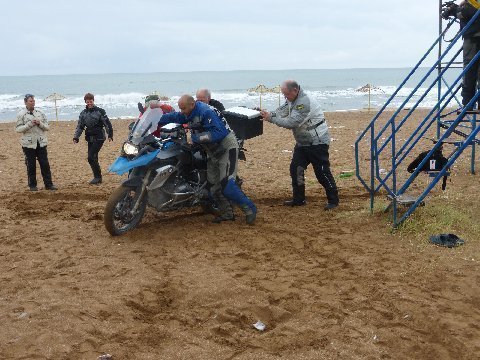
Above: 30 June 2014. Kaz, Shock, and Plane push bike in the Caspian sand after a photo shoot. Chicago and Annie Oakley look on.
Earlier I walked onto the beach. I stood looking out over the Caspian Sea and occasionally shook my head in wonderment realizing that I was standing at the point where Russia opened to the middle east in ancient times. Until modern times, the Caucasus mountains could only be bridged here... in Derbent... along the coast line.
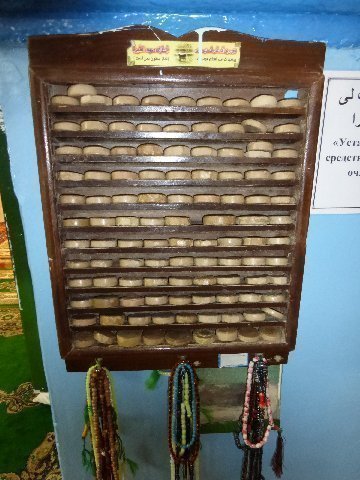
Above: 30 June 2014. "Cakes" made from earth in Mecca, in the Juma Mosque, Derbent, Russia.
At time of prayer, "cakes" are place on the carpet in front of the supplicant. When the supplicant bows to pray, he touches his head to the cake. The practice is limited to Shiite worshipers, ie not employed in Sunni worship.
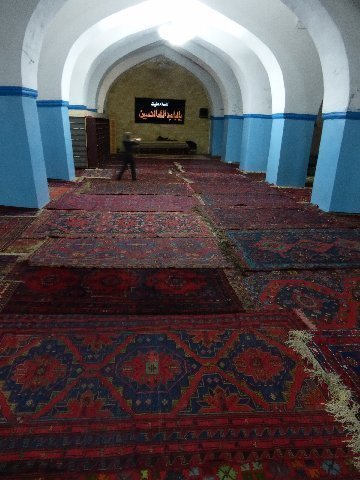
Above: 30 June 2014. Interior, Juma Mosque. Derbent, Russia. The Juma Mosque, dating to the 6th century, is the oldest mosque in Russia.
Mosque rugs are Dagestani rugs. Rug weaving, once prolific in Dagestan, is now limited to four or five remote villages.
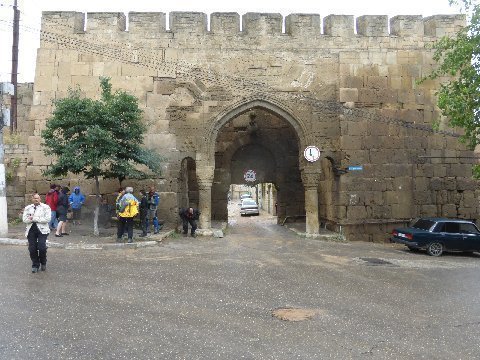
Above: 30 June 2014. Part of ancient city wall (south wall), Derbent, Russia. TIMDT is in blue amongst our group of MotoDiscovery/Kazoom MotoAdventures motorcycle tour goers. The image shows us waiting for a taxi to take us to the Derbent citadel overlooking the city.
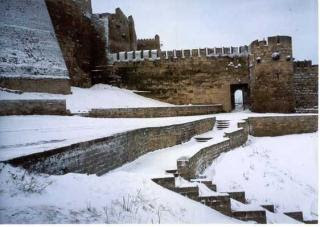
The Citadel, Ancient City and Fortress Buildings of Derbent are part of a strategic Sasanian defence system from the 5th century. Derbent is situated on the western shores of the Caspian Sea, in present-day Dagestan. It was in the position to control the traffic between Europe and the Middle East, and shield the prospering agricultural peoples of the Middle East from devastating raids of nomadic tribes from the steppes of South-Eastern Europe.
The defence structures that were built by the Sasanians were in continuous use by the succeeding Persian, Arabic, Mongol, and Timurid governments. Its militairy function lasted til the 19th century. Its name is a Persian word: “Darband”, meaning "closed gates".
The fortifications consist of:
• Two parallel defence walls, 3.6km long, stretching from the sea up to the mountains. They were built from stone and had 73 defence towers. 9 out of the 14 original gates remain.
• Naryn-Kala Citadel: most of the old buildings, including a palace and a church, are now in ruins. It also holds baths and one of the oldest mosques in the former USSR.
• the ancient City, between the two walls, holds interesting courtyard houses, mosques, baths, madrasahs, and the remains of a caravanserai.
Source: Wikepedia
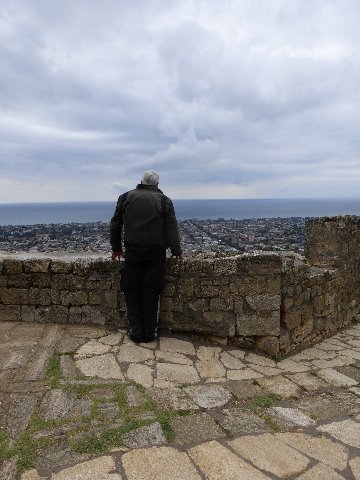
Above: 30 June 2014. The Bishop, in a contemplative state, looks east over the city of Derbent, Russia, to the Caspian Sea. Beyond the sea... Kazakhstan. The Bishop stands on the parapet of fortress Naryn-Kala, VII century B.C. to VI century A.D. The fortress has been included in the list of World Heritage sites by UNESCO. It is protected by the state.
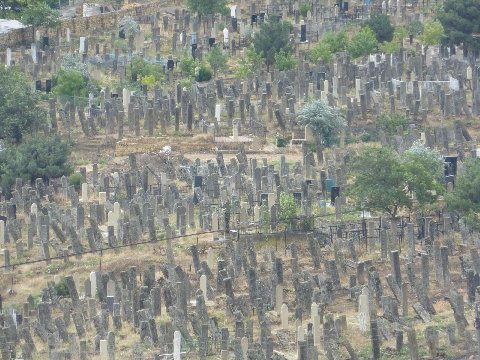
Above: 30 June 2014. Cemetery, Derbent, Russia.

Above: 30 June 2014. Power to the people. Derbent, Dagestan, Russia.
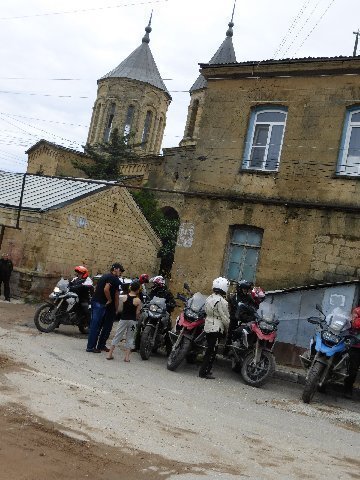
Above: 30 June 2014. Motorcycle tour goers stand near their motorcycles after having visited the Saint Sargis Armenian Church, rear in image, the oldest Armenian church in Russia, dating to the 6th century AD.
30 June 2014 Addendum part 1:
Steve, you need to do a story of your trip for Rider magazine, let’s talk when you get back. the iPhone visa story is remarkable. Don’t change a word of it!
Isetta, Chicago, IL
Do you understand all Steve's vocabulary words Margaret! He is a fabulous writer and photographer, unbelievable shots and angles...I have never seen that way through a camera lens...thank you so much for sharing with us...and I needed a dictionary...
Where are you saving your money for...I'm also not good with initials...and I can figure out some of TIMDT...
It's a rainy 4th in NY...I'm happily home preparing dinner for my friend Charlie and I...swam my laps and did an hour water aerobics class this morning before the rains came...
Keep writing and sending...I love it!
Love,
Carol,
New York City, NY
boy, steve’s journaling sure is interesting......like having a private history lesson from eyes that have viewed the surroundings on a personal level. you should consider going to universities and travel agencies lecturing about your travels. I didn’t realize that the economy of armenia was so desperate and sad. they still despise the turks. in trabazon they make a special kind of woven gold jewelry, did you notice the handicrafts? . I was indecisive and now am kicking myself for not buying any. you are too wise noting that the carpets were “worn” to look antique. you had an eye for the antique fabric in india as I well remember.
the 4th of July is almost over and the torrential rain stopped so ny could display the fabulolus fireworks caught on tv.
more whenever possible.
xox,nancy,
Greenwich, CT
Thanks Steve!
Claudia,
Sao Paulo, Brazil
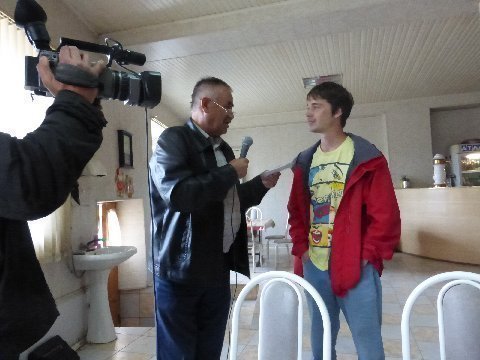
Above: 30 June 2014. Dmitri, our Russian guide, being interviewed by a local television station, at in a restaurant at our lunch stop, in the village of Khiv, Dagestan, Russia.
After a morning of sightseeing in Derbent, Dagestan, Russia, ten motorcycles and riders, a hired car with driver carrying three erstwhile pillion riders, and our luggage van, driven by Kaz' brother Ihan, carrying Nancy, MotoDiscovery partner and spouse to Skip, also erstwhile pillion rider, and Dmitri, headed for the higher reaches of the northern, Greater Caucasus.
The 200 km ride from Derbent, east, to the high (8000 feet) Dagestani village of Haihi would include 70 kilometers of dirt road. A side trip to the village of Tsovkra would add another 10 kilometers, round trip, of pretty rough dirt road to the trip. Because, the dirt riding would mean a greater degree of difficulty for riders, it was decided to hire a car for the pillion riders for the four day stay in Russia.
Our expedition attracted enough attention in the village of Khiv that representatives of the local TV station joined at our lunch break to get a story.
Dmitri would prove to be a friendly, cheerful, and knowledgeable necessity throughout our four day stay in Russia.
Tour organizers. MotoDiscovery and Kazoom Motorcycle Adventures.
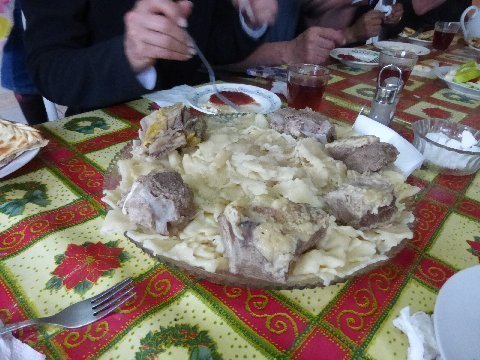
Above: 30 June 2014. Lunch in Khiv.
Hinkal. Home made pasta and beef. Supplemented (not pictured) by chudu, a cheese pie which we would see at most meals throughout our Russian stay.
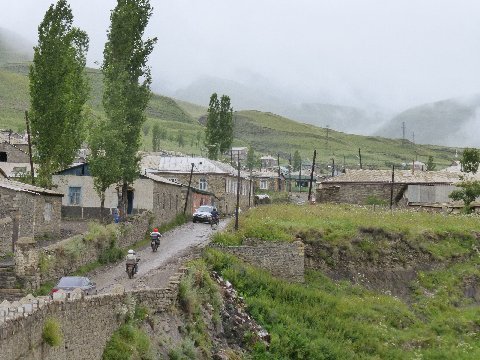
Above: 30 June 2014. Riders pass through a village as they climb the high, mountain, dirt road.
As I noted in my 28 June 2014 Picto Diary, it had rained hard yesterday evening. Today, as we rode, the sky was overcast and there was an occasional sprinkle as we climbed. Most of the 70 kilometers of dirt stretch was packed gravel and dirt mix, with intermittent stretches of packed dirt only. When wet, such road conditions make for careful throttle use to make sure the rear motorcycle tire doesn't spin out and upend the bike. Riding at a low RPM lug in 2nd gear seemed to be the best method of moving uphill on the wet, slick surface.
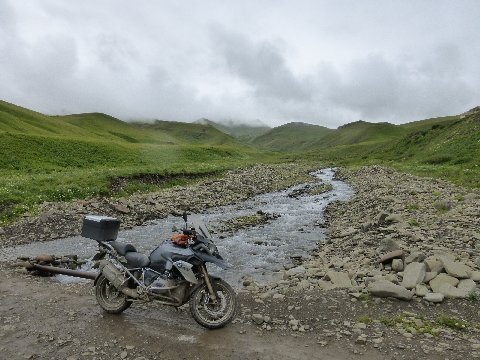
Above: 30 June 2014. My BMW R1200 GS motorcycle parked on a bridge.
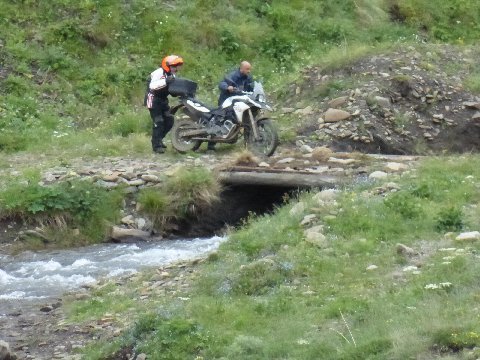
Above: 30 June 2014. Taos and Kaz push Taos' bike across a makeshift bridge.
When we arrived at this stream, the principle crossing was through the stream itself. However, at the point of the crossing, the stream angled and became part of the road for about 100 feet... a very long water crossing for one of these big motorcycles.
Fortunately, we saw the bridge pictured above upstream. It had been little used, had an earthen and rock surface over latticing that looked shaky. We thought twice about riding the bikes over the bridge... but, we were successful in pushing them across.
The car and the van were able to negotiate the long water crossing that the bikes bypassed using the bridge.
Shortly after arriving at the bridge pictured above, we came to a water crossing with no bridge. The rains had contributed to swelling the size of the stream... and, here, there was no bridge. The water was occluded with eroded earth it had picked up in its swollen state.
At the point of the road, the crossing was quite wide... say 30 feet. We walked up stream and found a section of the stream that was about 15 feet wide. The water was rushing fast and was about 9 inches deep at that point.
Dirt Bike, a tour participant from Newport, CA, decided he would be first to try the upstream crossing. On the other side was a grassy field, which Plane had determined, after walking across the stream, was fairly solid.
Dirt Bike chose the "all or nothing" method of crossing. Idling his bike some 100 feet away from the rushing stream, he let loose and powered over the stream at some speed. After making it across, he was going so fast in the grass that the bike fish tailed a couple of times before going down. The grass was soft... the bike and its rider were undamaged... and we had some certitude that the crossing was possible.
Kaz took his bike over the stream next, albeit at a more modest pace.
Peer pressure is a wonderful motivator. And the fact that at that time, we only had one option... and, that was to continue up the mountain... it was 60 km back to pavement in the other direction. I was next. I had to do it. In first gear I slowly, but, assertively, descended into the stream. I had my feet down in the rushing water on either side of the bike, reached the other side, and with some assistance from friends on the other side, powered up to the grass.
We got all of the bikes successfully over the stream and continued on our way. I'm sorry I didn't get any images of this water crossing event, but focus was intent by all parties present to ensure that everyone got across the stream. No time to think about images.
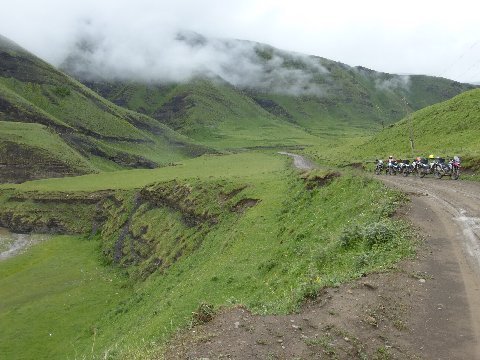
Above: 30 June 2014. Parked motorcycles in high Caucasus landscape.
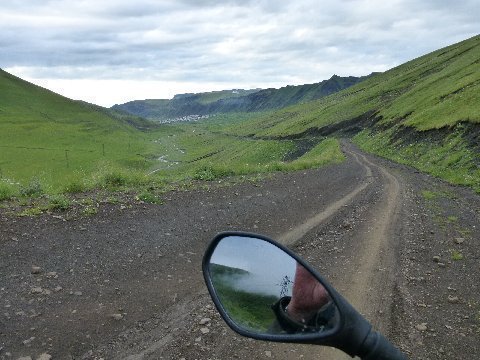
Above: 30 June 2014. Headed down. A village can be seen in the distance.
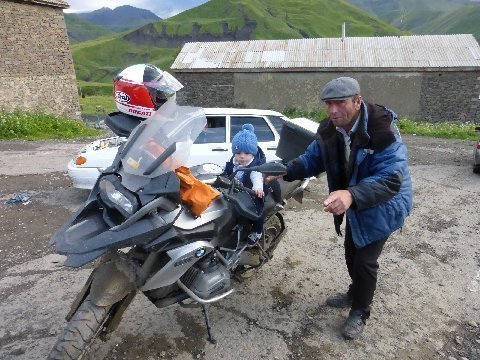
Above: 30 June 2014. Grandpa and grandson pose with my bike in a mountain village, Dagestan, Russia.
The village people we saw all along this route were extremely friendly.
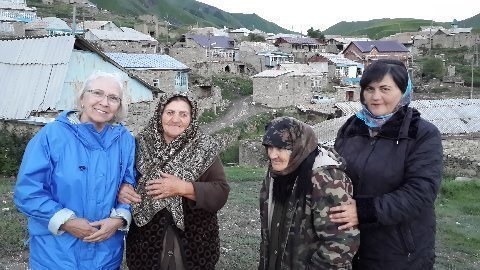
Above: 30 June 2014. TIMDT and friends in the village of Tsovkra, Dagestan, Russia. (Image by Kaz).
Tsovkra, a Lak village, is famous for its rope walkers.
It was one hour before dusk when the group took the detour to ride up to this village for a rope walking demonstration and village hospitality.
Four of us riders, who were bringing up the rear, sensing that if we went to the village, and stayed thirty minutes or so, we would have to ride in the dark to cover the 5 killometer detour return and 10 kilometers of further travel, to get to our hotel.
So, Dirt Bike, with GPS coordinates for the hotel, Newport (Dirt Bike's SO), Plane, and Mwah (sic) turned back with only one kilometer to go to get to Tsovkra.
Back on the main road, we four riders were seemingly "home free" to reach the hotel by dusk. But, then... mud.... major mud. We ran into several mud sections in the road, one of the sections at least 200 feet long. To get a big motorcycle through the mud requires a combination of strength, long legs (where I am blessed) used as "outriggers," and careful throttle work to keep the tire from spinning. We were riding on dual sport tires, harder to keep the bike stable, than using knobby tires, for mud patches like this.
Three of us went down (including Mwah [sic]) at least once in the mud, to be helped up by a fellow rider. Because of the delays due to riding in the mud, we four riders didn't reach the hotel in the village of Haihi until dark.
We were worried about our friends who had stayed behind in Tsovkra. How would they get through those mud patches in the dark? I called TIMDT, who I knew would have access to her cell phone while riding in the car, and after three tries was able to get a signal. TIMDT reported that because of the night riding conditions, the group had decided to leave the bikes in Tsovkra, come to Haihi by car, and go back to pick them up the bikes the next day. A village elder used his own car to help ferry the bike-less riders to Haihi.
I warned TIMDT (but what could she do about it?) about some serious mud they would be encountering on the way down. She reported later that the van fishtailed a bit through the mud as it descended the mountain road. Ihan, Kaz's brother, who drove the van throughout the entire trip, did an excellent job driving and otherwise assisting riders.
By ten thirty PM, everyone had arrived at the Haihi hotel safe and sound. Fortunately, by that time, the hotel employees were able to get the lights working in the remote mountain hotel with no name. There was no water in the rooms. In the dining room of the hotel, hotel employees, prepared hinkal, salad, tea and chudu for dinner.
Today. A true adventure. In the Caucasus mountains, Dagestan, Russia.
30 June 2014 Addendum part 2:
Good stuff. The wonders of the technological age on display.....
Torquemada,
Sandy, UT
Check your date on the Juma mosque. It couldn't date from "the Sixth Century". Mohammad himself was born near the end of the 6th Century in 570 A.D., and didn't get rolling until sometime later. Islam was probably not building mosques in Russia in the 6th Century. 7th maybe, but not likely the 6th.
Torquemada,
Sandy, UT
Sorry. 8th Century. Rebuilt in 14th and 17th centuries.
"Many older people look back nostalgically to the late Soviet era when there was a job and security for everyone."
Similar type people in America look back to the America before there was a black man in the White House. Let's check the race and gender math in the peoples' house shall we: the US House of Representatives 113th Congress.
233 Total Republicans
African American -0-
Asians -0-
Mexican -7-
Native American -2-
Women -19-
Do I need to add %s? The only place that has less minorities and women is a KKK convention. All per the Congressional Research Service.
Vegas,
Park City, UT
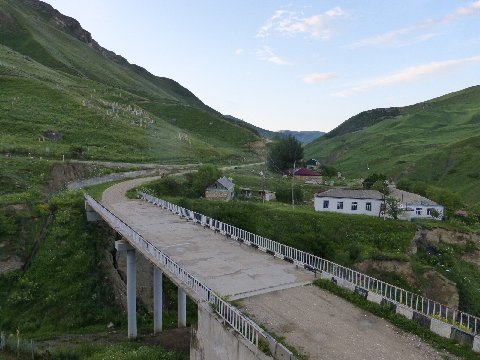
Above: Bridge in Haihi, Dagestan, Russia. 01 July 2014.
Early AM image (I didn't sleep a lot) taken from our no name, no water, hotel room window, looks back up the (little traveled by tourists) road we traveled yesterday.
I've been in some remote places on my motorcycle travels... the Gobi desert comes to mind... but, Haihi is right up there! Thank's Burt.
Only four of us rode our motorcycles here yesterday, encountering some serious mud patches not far up the road as seen in this image.
At 7:30 AM, the six riders who last night left their bikes in the rope walker village of Tsovkra, about 15 kilometers back, left by car, again with the help of a Tsovkra village elder, to return to Tsovkra to retrieve the motorcycles.
After breakfast... black tea, bread, hard boiled eggs, and chudu (cheese pie). The four riders who had ridden to Haihi, the van, and the car riders, rode/drove about 20 kilometers to a rendezvous spot on a paved road. There we would wait for the six riders who went back to Tsovkra to retrieve their bikes. The six Tsovkra riders would take another route to reach us... supposedly a route that would avoid the serious mud we encountered yesterday.
Since the bike retrieving riders left so early, they didn't avail of the breakfast prepared with great care by the no name hotel staff. They would dine on barbecued lamb, provided by Tsovkra villagers.
Consequently, our hotel staff, was a bit flummoxed that there was so much left-over food. They had made the chudu from scratch with pain staking effort. Erstwhile pillion rider, now car rider in Russia, Nancy (spouse of Skip and co-owner of MotoDiscovery) suggested we take the food along with us and picnic somewhere along the way for lunch. Good idea.
Notwithstanding the evening's Spartan accommodations, tour participants were in good spirits as we four bikes, a van and a car, driven by Roma, of erstwhile pillion riders set out to ride to meet our friends down the road. The hotel staff had worked hard with what they had to make our stay enjoyable, and we tour participants realized we were having a very special experience shared by few, if any, of our countrymen.
On to Grozny, Chechnya.
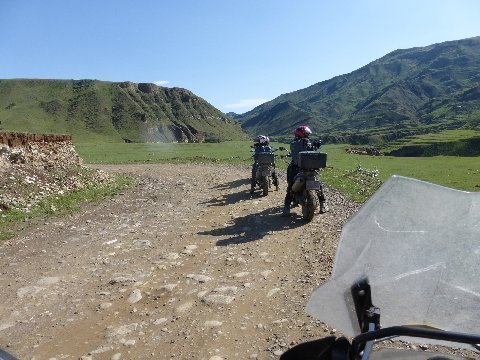
Above: 01 July 2014. Ahead, Dirt Bike, Newport, and Plane, stopped to capture an image of the terrain after leaving Haihi and prior to reaching the rendezvous point on the main road.
Five kilometers west of Haihi. Dagestan, Russia.
The road, still damp, is drying out somewhat on a beautiful, rapidly warming, clear morning, following yesterday's misty, wet day in the high Caucasus.
But, the mud was still there.
On this AM's ride we encountered four more mud patches in the ten kilometers we rode between Haihi and the main road.
The mud patches would generally be found at the apex of switch backed curves running by small, north facing canyons. The canyons seeped water to the road, and received less sunlight, thus giving rise to the muddy conditions.
Today marked the fourth day where we have had challenging dirt riding conditions.
1. The Goderdzi summit ride in Georgia, 21 June. 2. The long construction segment between Naftalan, Azerbaijan and Baku, 27 June 2014 (TIMDT rode pillion with me on that challenging segment). 3. The 70 km section, yesterday, 30 June, between Derbent, and Haihi, and, 4. Today's 10 km periodic mud patch segment to the main highway.
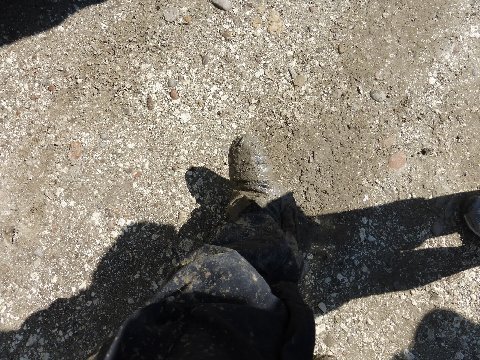
Above: 01 July 2014. Muddy riding pants and boot... of Mwah (sic). Image taken at our rendezvous point on the main road while waiting for our fellow tour goers.
Had I been thinking more clearly, I would have stopped to get an image of one of my fellow motorcyclists fish tailing, outrigger legs flailing, through the mud. But, the mud riding required 100% concentration. I was huffing and puffing after completing each mud patch on the BMW R1200 GS motorcycle. Image taking of mud riding was far from my mind in my adrenalin suffused, intensely focused state.
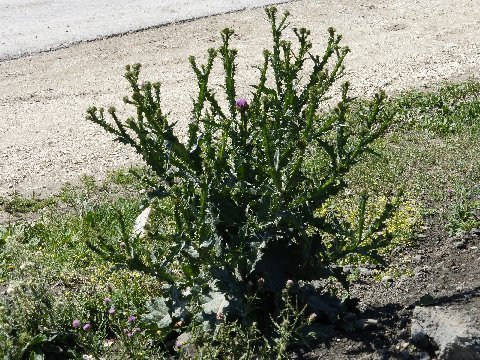
Above: 01 July 2014. Russian Thistle.... in Russia!
We see a lot of this plant in the Wasatch.
I recognize other plants and weeds as we ride. There is a lot of milkweed around.
Wild rose bushes abound, and are now blooming, across the Dagestan landscape. The bushes that I see are very similar to the "wild" rose bushes that grow on our home property in Park City, UT.

Above: 01 July 2014. Plane, Kaz, and Skip pose with some Russian motorcycle enthusiasts. The group wasn't riding bikes. They rode up to our rendezvous spot in a car. But, they wanted to see our bikes and to let us to know they were riders.
The image was captured shortly after Kaz and the five other Tsovkra riders reached the rendezvous point.
The Tsovkra riders, coming via another route, to avoid the long mud patch we four riders experienced yesterday evening, reported finding their own mud patch, notwithstanding, on their detour. Poetic justice?
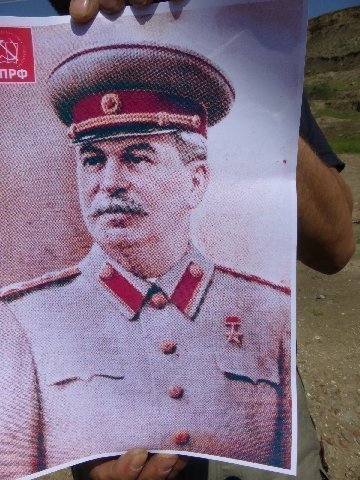
Above: 30 July 2014. "Image of image" of Josef Stalin.
Kaz noted the image on the wall of the Tsovkra school master's office this morning and the school master made a gift of the image to him. I captured my own image of the image, above, at the rendezvous point when Kaz, aware of my fixation with learning more about Stalin on this trip, showed his prize to me.
I sense that the feeling about Stalin in Russia is ambiguous. Whether you love Stalin or hate him depends on who you are... or where you live..
Dimitri, our Russian guide, said that many older people in Russia still revere Josef Stalin... but, that young people are indifferent to negative about Stalin's role in Russian history.
We'll find out more, I hope, about Stalin when we stop at his home town, Gori, Georgia, on 05 July 2014.

Above: 01 July 2014. Annie Oakley feeds a friendly, wandering donkey at our picnic spot en route to Grozny, Chechnya.
"Don't get nipped!" Shock warned.
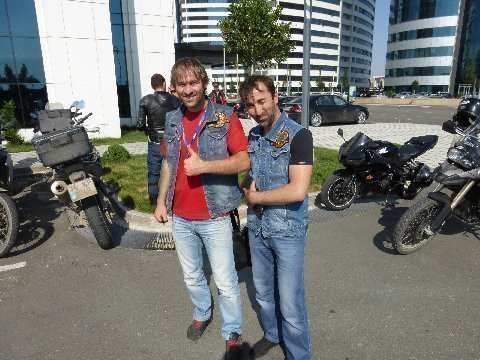
Above: 01 July 2014. Grozny motorcycle riders.
As we rode into Grozny, Chechnya, the rider at right, riding the sport bike seen in the rear of the image, started tailing our group. He rode with us to the hotel. Immediately after getting off his bike, and quickly shaking my hand, he placed a call with his cell phone A few minutes later, his friend on the left appeared, also riding a motorcycle.
The men asked me if our group wanted to go on a ride with them this afternoon. I told him we would love to, but, we had already ridden for a long distance today and we wanted to rest.
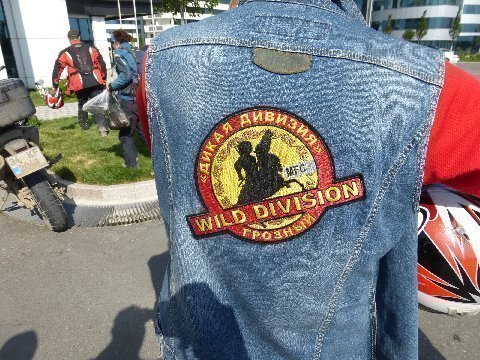
Above: 01 July 2014. Logo on back of Grozny motorcyclist jackets.
Riding through the Caucusus (Armenia, Georgia, Azerbaijan, and Russia) we have seen very few motorcycles. Those motorcyclists that we do encounter are not shy about coming up to say hello. Two such encounters today.
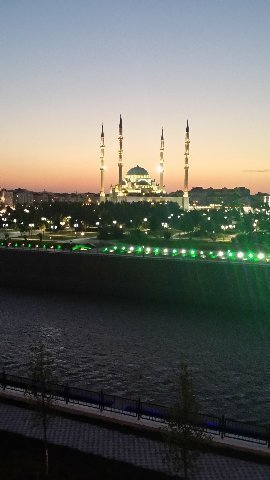
Above: 01 July 2014. Akhmad Kadyrov Mosque, Grozny, Chechnya. Foreground, Sunzha River.
Image taken, post dusk, from patio of our hotel, Hotel Grozny City.
The mosque is the largest mosque in Russia and is officially known as the "The Heart of Cechnya."
The mosque is named after Akhmad Kadvrov who commissioned its construction from the mayor of Konya. The mosque design with a set of 203 feet tall minarets is based on the Blue Mosque in Instanbul.
On October 16, 2009, the mosque was officially opened in a ceremony in which Chechen leader Ramzan Kadyrov spoke. A;so present at the official mosque opening was Russian Prime Minister, Vladimir Putin.
In this mosque ten thousand Muslims can pray at a time. The mosque contains one of Muhammad's relics, a 1400-year-old bowl used by Muhammad which after his death was allegedly kept by his daughter Fatimah and her husband Ali.
01 July 2014 Addendum:
great adventure and well told in words and pics, thanks .
brand man,
venice, ca
Steve,
Fantastic adventure. A story that will stay with you for life. Thank you for bringing us along with you.
Basketball,
Pelham, NY
Steve, Margaret... your tales are incredible and they are true. What an adventure.
All the best for the remainder, your envious,
Espresso,
Washington, D.C.
I am so envious of everyone having such a fantastic adventure, complete with mud and lots of water crossings. Seriously, this is all worthy of a story in the magazines!
Isetta, Chicago, IL
You, of course, are very much here in spirit... your named dropped frequently along the course of the trip.
Wonderful adventure glad the two of you were able to share together, very, very special-
MR Z3, Ojai, CA
I can imagine, vividly, every aspect of your adventure yesterday! And your Visa adventure last week!!!
Teeny Tiny, Chicago, IL
With respect, I think Vegas overlooks some facts.
For instance, Tim Scott is an African American male senator (the Democrats do not have an African American male senator). Also, Susana Martinez is an Hispanic female governor (the Democrats do not have an Hispanic female governor). Brian Sandoval is an Hispanic American governor of Nevada (unless I'm mistaken, the Democrats don't have an Hispanic male governor). In addition, Bobby Jindal and Nikki Hailey are Republican governors of Indian descent (the Democrats do not have any governors of Indian descent).
Don't forget Ted Cruz and Marco Rubio, both Republican Hispanic senators. In addition to Susana Martinez and Nikki Hailey, there are numerous other women serving in the Republican Party: New Hampshire senator Kelly Ayotte, Maine senator Susan Collins, Arizona governor Jan Brewer, etc.
This fall Utah voters will probably elect Mia Love, an Haitian-American woman, to Congress.
I could go on - Raul Labrador is a Puerto-Rican American who represents Idaho in Congress.
Although the Republican Party has its flaws, it is more diverse than people realize.
Rudy Jr.
Salt Lake City, UT
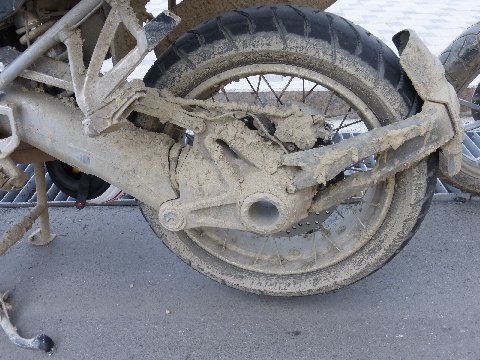
Above: BEFORE. Rear wheel and swing arm, my rented BMW R1200 GS motorcycle, after two mud riding days in the Greater Caucasus.
My riding pants were so caked with dried mud that I left my motorcycle clothing in the van last night...not wanting to dust up our hotel room.
Grozny, Chechnya, 02 July 2014.
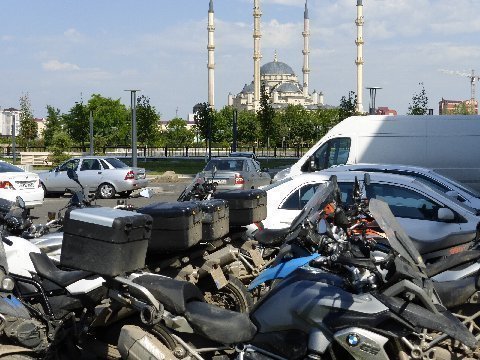
Above: 02 July 2014. Motorcycles of MotoDiscovery Caucasus motorcycle tour, foreground. Akhmad Kadyrov Mosque, Grozny, Chechnya, background. Image taken from parking lot, Grozny City Hotel.
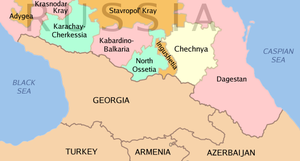
Above: 02 July 2014. Chechnya and Caucusus map.
Refresher... we rode from Baku, Azerbaijan, on the Caspian Sea coast, to Derbent, Dagastan, also on the coastline of the Caspian Sea, to Haihi village, mountainous, central Dagestan, to Grozny, Chechnya... where we are today... 02 July 2014.
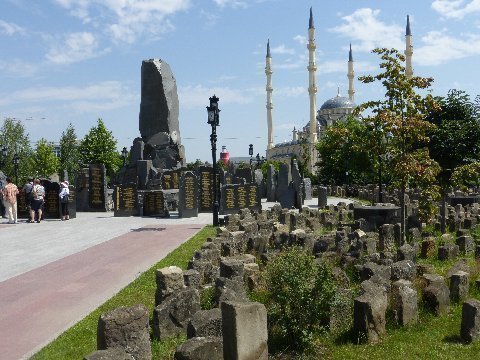
Above: 02 July 2014. Martyrs' Monument, Grozny, Chechnya, Russia. Akhmad Kadyrov Mosque is seen in image background at right.
The monument honors those Chechens, some 140K, military and civilians, who were killed in the two Chechen wars.
The Martyr's Monument also honors those killed in WWII when Chechens, believed by Josef Stalin to be supporters of Hitler, were forced marched to Khazakstan. Exiled Chechens were allowed to return to Chechnya ten years later in 1954.
In 1944, Grozny was emptied of all Chechens and Russian occupiers of the city desecrated cemeteries using the head stones for building projects and sundry. Some of these old head stones are used to great effect in the Martyr's Monument today. Note in image, above.
The Chechen Republic is a federal subject of Russia. The republic has a population of 1.3 million people.
After the dissolution of the Soviet Union in 1991, Chechnya was split in two: the Republic of Ingushetaland and the Chechen Republic. Spurred by an underground Chechen separatist movement, the Chechen Republic sought independence from Russia.
Following the first Chechen war with Russia, in 1994/1995, Chechnya gained defacto independence as the Chechen Republic of Ichkeria. Chechnyan fighters were outnumbered two to one. For three months, Russia lost more tanks (1,997 tanks) in Grozny than during the Battle of Berlin in 1945. Thousands of combatants on both sides died in the fighting, alongside civilians, many of which were reportedly ethnic Russians; unclaimed bodies were later collected and buried in mass graves on the city outskirts
Russian federal control was restored during the Second Chechen War, 1999/2000. Grozny, Chechnya's capital city, was leveled by the Russian military. During the early phase of the Russian siege on Grozny on October 25, 1999, Russian forces launched five SS-21 ballistic missiles at the crowded central bazaar and a maternity ward, killing more than 140 people and injuring hundreds.
Since the end of fighting in 2000, there has been a systematic reconstruction and rebuilding process, though sporadic fighting continues in the mountains and southern regions of the republic. The reconstruction has been financed by Chechya oil and Russia federal government.
Everything we see here in Grozny is new. There is little evidence of any building that pre-dates the 2nd Chechen War, 1999/2000.
Historical Notes (Source Wikepedia)
Chechens descend from the Vainakhs. The Vainakhs are the ancient natives of the Caucasus. It is noteworthy, that according to the genealogical table drawn up by Leonti Mroveli, the legendary forefather of the Vainakhs was "Kavkas", hence the name Kavkasians, one of the ethnicons met in the ancient Georgian written sources, signifying the ancestors of the Chechens and Ingush. As appears from the above, the Vainakhs, at least by name, are presented as the most "Caucasian" people of all the Caucasians (Caucasus – Kavkas – Kavkasians) in the Georgian historical tradition.
American linguist Dr. Johanna Nichols " has used language to connect the modern people of the Caucasus region to the ancient farmers of the Fertile Crescent" and her research suggests that "farmers of the region were proto-Nakh-Daghestanians." Nichols stated: "The Nakh–Dagestanian languages are the closest thing we have to a direct continuation of the cultural and linguistic community that gave rise to Western civilization."
Russian conquest of the Caucasus. 1558 Temryuk of Kabarda sends his emissaries to Moscow requesting help against Vainakhtribes from Ivan the Terrible. Ivan the terrible marries Temryuk's daughter Maria Temryukovna the Circassian (Kabardin) tsaritsa. Alliance formed to gain the ground in the central Caucasus for the expanding Tsardom of Russia against stubborn Vainakhdefenders.
Chechnya was a nation in the Northern Caucasus that fought against foreign rule continually since the 15th century. The Chechens converted over the next few centuries to Sunni Islam, as Islam was associated with resistance to Russian encroachment.
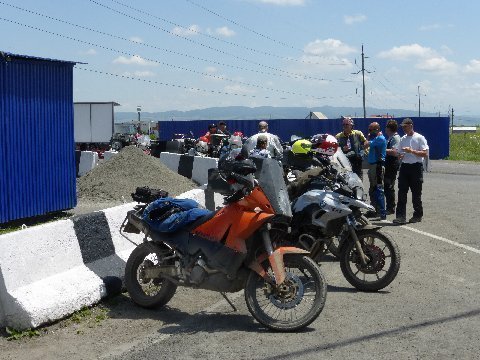
Above: 02 July 2014. Check point. Coming into North Ossetia from Ingusetia.
We had to register our passports with Russian authorities at this border. The chief, Russian border guard, dressed in a dark blue uniform with a matching baseball cap, was friendly, if not jovial. Our group interacted, taking photos, and exchanging snacks, with a busload of Dagestani young people who were on tour in the area. The curiosity and friendliness of the people everywhere we go is noteworthy.
To get to this point, North Ossetia, we rode, without stopping, through the small Russian federal republic of Ingusetia. Scroll up. Check map.
Here from Wikepedia....
The Republic of Ingushetia (Russian: Респу́блика Ингуше́тия, Respublika Ingushetiya; Ingush: ГӀалгӀай Мохк Ğalğaj Moxk), commonly referred to as Ingushetia, is a federal subject of Russia (a republic), located in the North Caucasus region with its capital at Magas.
In terms of area, the republic is the smallest of Russia's federal subjects except for the two federal cities, Moscow and Saint Petersburg. It was established on June 4, 1992 after the Chechen-Ingush Autonomous Soviet Socialist Republic was split in two.
The republic is home to the indigenous Ingush, a people of Vainakh ancestry. Population: 412,529 (2010 Census).The name "Ingushetia" is derived from an ancient village of Ongusht (renamed in 1859 to Tarskaya and in 1944 transferred to North Ossetia) and the Georgian ending -eti, all together meaning "(land) where the Ingush live".Ingushetia is one of Russia's poorest and most restive regions.
The ongoing military conflict in neighboring Chechnya has occasionally spilled into Ingushetia, and the republic has been destabilized by corruption, a number of high-profile crimes (including kidnapping and murder of civilians by government security forces), anti-government protests, attacks on soldiers and officers, Russian military excesses and a deteriorating human rights situation.
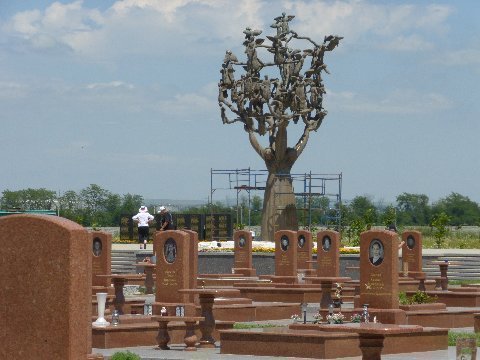
Above: Town of Angels Monument, Beslan, North Ossetia, Russia.
TIMDT is seen in white top, beyond the red granite grave stones, in white hat looking upward at the monument.
Beslan School Hostage Crisis (source Wikepedia)
The Beslan school hostage crisis (also referred to as the Beslan school siege or Beslan massacre) started the first of September 2004, lasted three days and involved the capture of over 1,100 people as hostages (including 777 children), ending with the death of 334 people.
The crisis began when a group of armed Islamic separatist militants, mostly Ingush and Chechen, occupied School Number One (SNO) in the town of Beslan, North Ossetia (an autonomous republic in the North Caucasus region of the Russian Federation) on 1 September 2004.
The hostage-takers were the Riyadus-Salikhin Battalion, sent by the Chechen separatist warlord Shamil Basayev, who demanded recognition of the independence of Chechnya at the UN and Russian withdrawal from Chechnya. On the third day of the standoff, Russian security forces entered the building after several explosions, using other heavy weapons.
At least 334 hostages were killed as a result of the crisis, including 186 children, with a significant number of people injured and reported missing.
The event led to security and political repercussions in Russia; most notably it contributed to a series of federal government reforms consolidating power in the Kremlin and strengthening of the powers of the President of Russia.
As of 2011, aspects of the crisis in relation to the militants remain contentious: Questions remain regarding how many militants were involved, the nature of their preparations and whether a section of the group had escaped.
Questions about the Russian government's management of the crisis have also persisted, including allegations of disinformation and censorship in news media, whether the journalists who were present at Beslan were allowed to freely report on the crisis, the nature and content of negotiations with the militants, allocation of responsibility for the eventual outcome, and perceptions that excessive force was used.
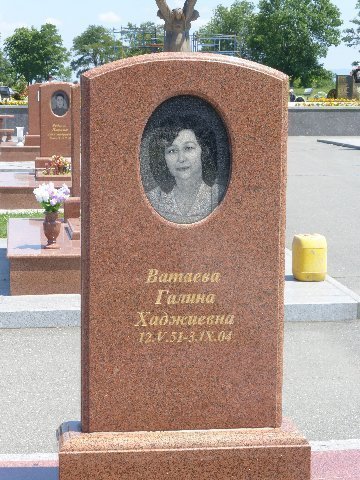
Above: 02 July 2014. Monument for one of the school children killed in the Beslan school hostage crisis of September 2004.
There is a rise of tribal nationalism throughout the world. The Russians use a heavy hand to keep nationalistic movements under control. The leveling of Grozny, and the presence of assertive Russian troops in the Beslan crisis, sends a strong signal to nationalistic movements within Russia.
Outside of Russia, there is a growing vacuum in areas of historical tribal conflict, created in the wake, recently, of a less assertive US foreign policy. Where Islamic militancy appears contained in Russia, there now seem to be fewer restraints on its expansion elsewhere... voire ISIS, Syria, Iraq, Yemen, Africa.... and beyond.
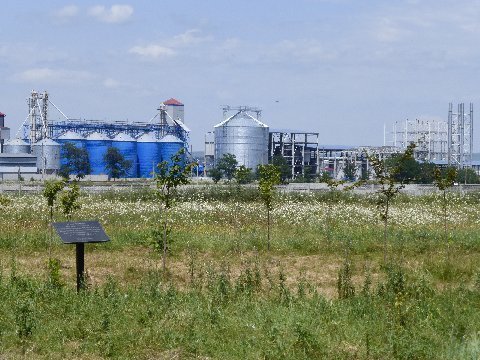
Above: 02 July 2014. Grain elevator. North Ossetia, Russia.
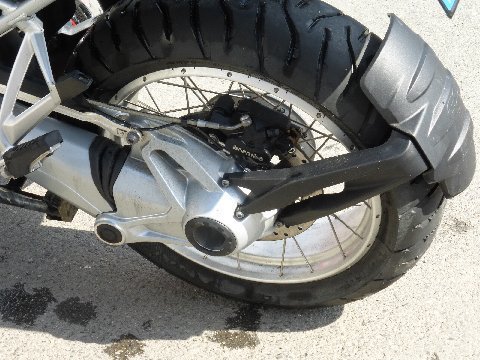
Above: 02 July 2014. AFTER. BMW R1200 GS wheel. After going to a wash in Vladikazdkav, North Ossetia, Russia.
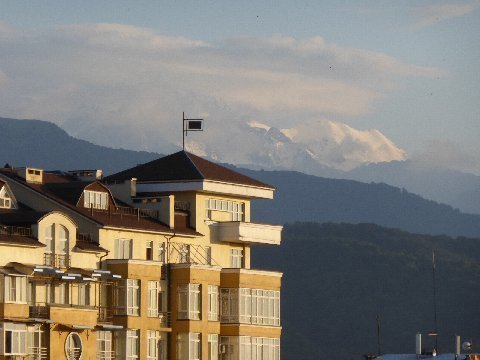
Above: 02 July 2014. Greater Caucasus mountains, looking out from our hotel room at Hotel Vladikavkaz, Vladikavkaz, North Ossetia, Russia.
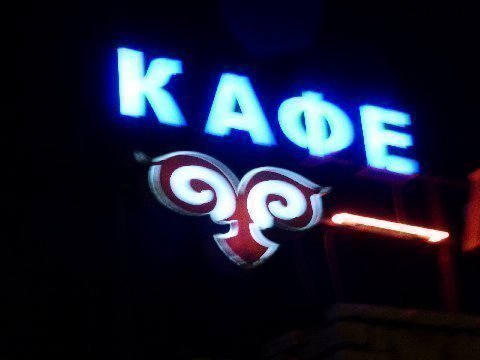
Above: 02 July 2014. Sign, in Cyrillic, for our restaurant in Vladikazkav.
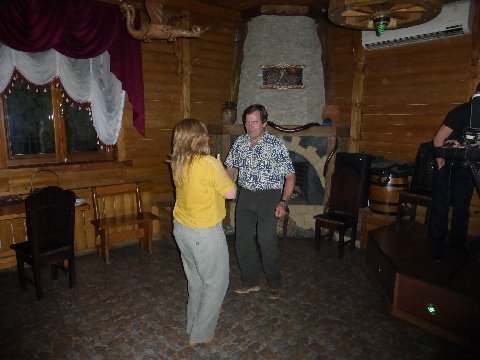
Above: 02 July 2014. Taos, dancing after dinner to North Ossetian folk music disco, with North Ossetian lady. Pulsating beat, chilled vodka, and Georgian wine made for a toxic entertainment brew. A night of fun in one of the more unlikely locations for a night on the town that one could imagine. Vladikazcav, North Ossetia, Russia.
02 July 2014 Addendum:
Thanks for sharing . . very exciting adventures !
Hand,
San Jose, CA
Your daily reports are pulling at my heart strings. It is killing me to be strapped to my desk and not enjoying the riding challenges, places & people you are meeting in your travels. Of all the places we have all ridden together and the adventures that we have shared, what you are all doing is off the charts as exciting to me as my little Peking to Paris road rally! Perhaps Ken can help you produce a photo book to memorialize the journey. May I offer to help compose & edit it with you?
Isetta, Chicago, IL
As I said before, you are missed and referred to often. Happy to collaborate.
this is like a trip taken by marco polo. you’ve got to send your travelogue to Departures (if you have used you amex card!) or some wonderful travel magazine so everyone can share these adventures and bumps in the road.I was really fascinated by your strength and energy. so much history and people experiences, and biking. I feel like a wimp! wow is all I can conclude.....
nancy,
Greenwich, CT
So, I started out giving you encouragement in this trip, now I find myself saying "wow" what a grand adventure to places in the world, the people & history, most of us will never have the privilege of seeing. So, right, the no water, no sheets would be a challenge (probably couldn't alter my meals let alone put it
"All on the side") but...I thank you for sharing this genuinely fascinating road trip. The words & the pix gave me a feeling of sharing the experience. many wonderful stories & memories.
Happy & safe journey as you make your way back.
See you soon
Sending love to you both
"SpaGo"
Marina del Rey, CA
Thanks Steve
I am enjoying read Your diary. It has been fantastic
To follow you.
Sandra
Savi Imoveis, Brazil
Enjoying your tales of adventure. 50 years ago I would have been up for this. Impressed by your spirit and Margaret's willingness. The cruise will be at the other end of the spectrum. Looking forward to your return.
Comic Mom, Park City, UT
Steve, I am just in awe of this spectacular, once in a lifetime adventure that you and Margaret are taking, and look forward each day to getting your detailed and thoughtful reports on the trip. We are thinking what a trooper Margaret has been to accompany you on the bike, and for working through several difficult travel situations with you. Looking forward to hearing more.
Mezzanine, Miami, FL
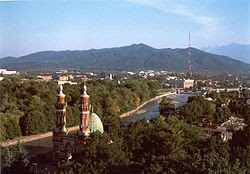
Above: 03 July 2014. Wikepedia image of Vladikavkaz, North Ossetia, Russia.
The city was founded in 1784 as a fortress during the Russian conquest of the Caucasus and was for many years the main Russian military base in the region. The Georgian Military Highway, crossing the mountains, was constructed in 1799 to link the city with Georgia to the south, and in 1875 a railway was built to connect it to Rostov-on-Don and Baku in Azerbaijan. Vladikavkaz has become an important industrial center for the region, with smelting, refining, chemicals and manufacturing industries.
Vladikavkaz was fought over in both the Russian Civil War and World War II. In February 1919, the anti-Communist Volunteer Army under General Anton Denikin seized the city, before being expelled by the Red Army in March 1920. In November 1942, the forces of Nazi Germany tried unsuccessfully to seize the city but were repelled. (Source Wikepedia)
We stayed at Hotel Vladikavkaz, a refurbished Intourist Soviet hotel. The rooms were small, but, the refurbishing was pretty good. The A/C worked well, the bar was open and well stocked, but, most important, the shower, with new Grohe fixtures, put out big time pressure. No water saving going on in the Caucasus.
Old Soviet practices are hard to cast off. The hotel had the traditional, Intourist hotel, floor lady. In the old days,the floor lady was a contractor to keep the KBG informed of goings on of hotel guests.
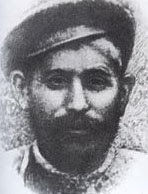
Above: 03 July 2014. Crazy Beso. Stalin's father. A once prosperous owner of a shoe making factory... a real catch for Keke... but brought low by the sauce after Stalin was born.
On Stalin's Ossetian origins:
The parents of both bride and groom (Stalin's parents, Beso and Keke) had been serfs of local princes, freed in the 1860's by the Tsar-Liberator, Alexander II. Beso's grandfather Zaza was an Ossetian from the village of Geri, north of Gory. Zaza, like Stalin, his great grandson, became a Georgian rebel: in 1804 he joined the uprising of Prince Elizbar Eristavi against Russia.
The Ossetians were a semi-pagan mountain people who lived on the northern borders of Georgia proper, some becoming assimilated Georgians through most remain proudly separate: in 1991-1993, South Ossetians [with Russian assistance] fought the Georgians and are now autonomous. When Stalin's dying father was admitted to hospital, significantly he was still registered as Ossetian. Stalin's enemies, from Trotsky to the poet Mandelstam in his famous poem, relished calling him and "Ossete" because Georgians regarded Ossetians as barbarous, crude and, in the early nineteenth century, non Christian. Djugashvili certainly sounds as if it has an Ossetian root: it means "son of Djuga" in Georgian. Stalin's mother says Beso told her the name was based on the Georgian djogi, or "herd," root because they were herdsmen and were driven out of Geri by marauding Ossetians. The real relevance is lost because, by the time of Stalin's birth, the Djugashvilis were totally Georgianized. Stalin himself wrote about this: "What is to be done with the Ossetians... becoming assimilated by the Georgians?"
"Young Stalin," Simon Sebag Montifiore p. 21
Weighing up all these stories, it is most likely that Stalin was the son of Beso despite the drunkard's rantings about Soso (Stalin) as a "bastard." A married woman was always expected to be respectable, but it is hardly outrageous if the pretty young Keke, a semi-widow, did become the mistress of Egnatashvili when her marriage disintegrated. In her memoirs, Egnatashvili appears as often as her husband, and is remembered much more fondly. She does say that he was so kind and helpful to her that it caused a certain "awkwardness." Some of the Egnatashvili family claim there was a "genetic" connection with Stalin. However, Egnatashvili's grandson, Guram Ratishvili, puts it best: "We simply do not know if he was Stalin's father, but we do know that the merchant became the boy's substitute father."
Rumors of bastardy, like those of Ossetian origins, were another way of diminishing the tyrant Stalin, widely hated in Georgia, which he conquered and repressed in the 1920's. It is true that great men of humble origin are often said to be the sons of other men. Yet sometimes they really are the offspring of their official fathers.
"Young Stalin," Simon Sebag Monefiore p. 28
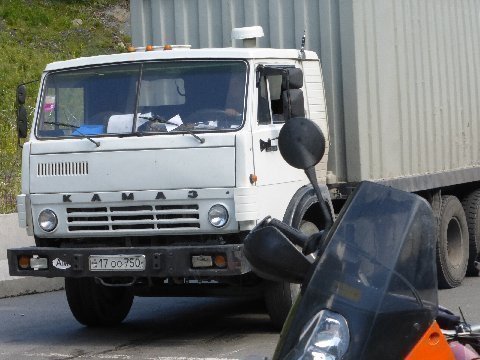
Above: 03 July 2014. For Burt.
Kamaz truck at Russian side of Russia (North Ossetia) and Georgia frontier... at the start of the Georgian Military Highway, from Vladikavkaz, Russia, to Tiblisi, Georgia, our destination for the day. 200km, from Vladikavkaz to Tiblisi doesn't sound like a long ride. But, add a border crossing from Russia to Georgia, and riding into a big city and you've got yourself a challenging day.
The Georgian/Russian frontier was closed for three years aftere 2008, when Georgia attempted to claim its former province, the then, semi autonomous, Russian leaning, South Ossetia. Russian troops were brought in to support the South Ossetians who wanted to remain semi-autonomous and loosely part of Russia... the state that they are in today, although South Ossetia has today more autonoy than Ingushitia, North Ossetia, Chechnya, and Dagestan.
The border between North Ossetia, Russia, and Georgia, along the Georgian Military Highway was closed from 2008 to 20011 due to tension between the two countries about the South Ossetia affair.
Today, the border is open and trade goes between Iran, Armenia, Georgia and Russia on via the Georgian Military Highway. While waiting on the Russian side of the border, we talked to a couple of Irani truck drivers driving tanker trucks from Iran to Georgia.
It seems strange to be talking to Irani citizens in normal, friendly discourse when our two countries are antagonists.
In such conversations with curious locals or travelers along the route, people generally light up in smiles when they hear we are Americans. My long held belief, after having lived 20 yeas outside of the United States, and having traveled extensively abroad after that, that Americans are generally liked around the world, is once again confirmed in my conversations with the Irani truck drivers.
Fuadh Ajamii, noted Hoover Institution Arabist, says, "don't be misled by the mobs in the Arab Street chanting 'go home Yankee.' Under their breath each chanter is saying, "and take me with you."
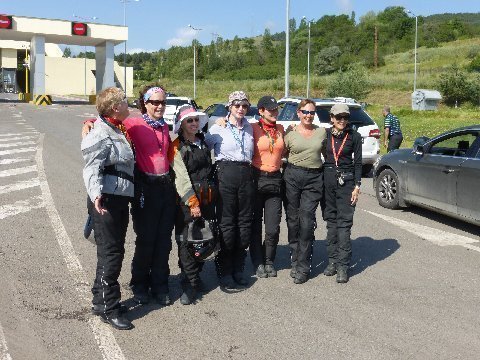
Above: 03 July 2014. Lady Riders MotoDiscovery, Tour, "From the Black Sea to the Caspian." Chicago, Newport, TIMDT, Carol, Annie Oakley, Nancy, Claudia. Russia / Georgia border, Russian side. Commencement of Georgia Military Highway across the northern Caucasus mountains, south to Tiblisi, Georgia.
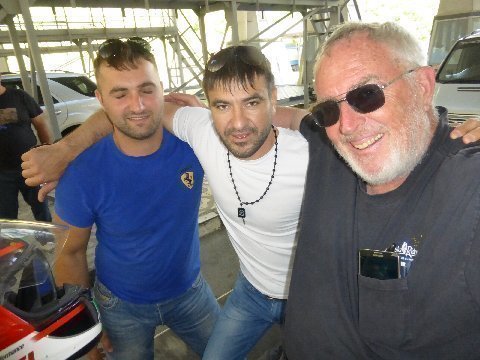
Above: 03 July 2014. Selfie. Two Chechen guys at Russian/Georgian (Russian side) border control who came over to look at our bikes and chat.
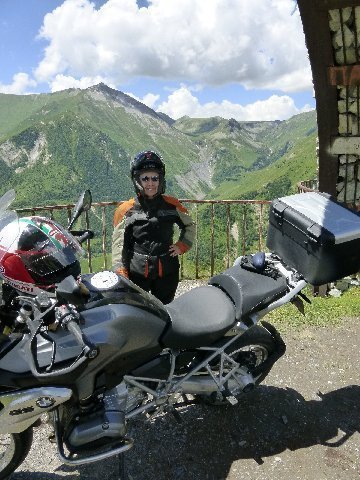
Above: 03 July 2014. TIMDT at rest overlook on Georgia Military Highway.
The last time Kaz had ridden this road two years ago there was a 20 km dirt section with the road under construction. We were pleasantly surprised to find most of the road, apart from 2 or 3 kilometers, nicely paved. Lots of switch backs and vistas. Nice riding. We exchanged waves with eight or ten touring motorcycles and riders, often pillion, riding up the road in the opposite direction. I wondered if they were riding into Russia, or just to Jvari Pass (road summit) and back to Tiblisi.
TIMDT is a trooper. She's ridden on the motorcycle all the way on the Caucasus trip but for most the Russian segment and the 2nd day's dirt ride over Godherzi pass, southern, lesser Caucasus, in Georgia. On her motorcycle off days she was riding either in the van or the hired vehicle, driven in Russia, by driver Roma. And, though she likely doesn't consider this as big a deal as I do, she got to ride in Russia,nonetheless,riding the 20 km segment today from Vladikavkaz to the Russian/Georgian frontier. So... TIMDT has motorcycled pillion with me on this trip through five countries. Turkey, Georgia, Armenia, Azerbaijan, and Russia. The entire trip is 2100 miles... so, I estimate that TIMDT will have ridden pillion for at least 1700 miles. I've really enjoyed having TIMDT along on this adventure ride!
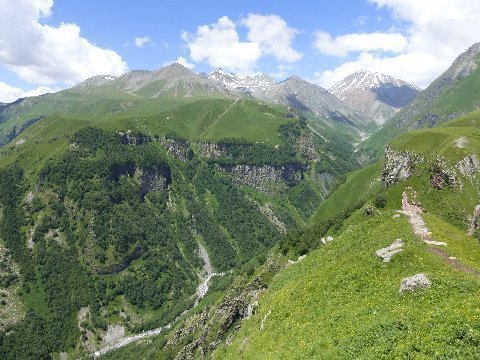
Above: 03 July 2014. Great Caucasus. Image taken from lookout on Georgia Military Highway.
The Georgian Military Highway crosses the Great Caucusus from Tiblisi, Georgia to Vladikavkaz, in North Ossetia, Russia. It was first properly engineered as a road in the 19th century with the Russian occupation of the Caucasus.
Georgia's identity hinges on the Caucasus that rises in Abkhazia, forms the border with Russia and runs the length of the country into Azerbaijan.
The Great Caucusus includes the highest mountain in Europe, Mt. Elbrus (5642m, on the Russian side of the border), and remains little touched by commercial development.
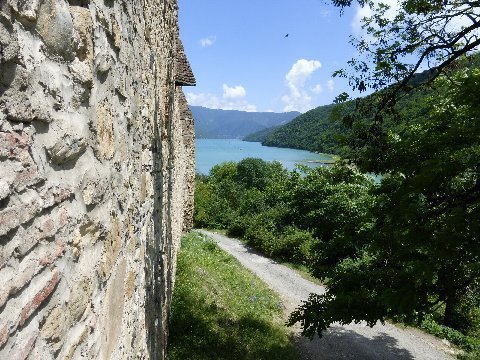
Above: 02 July 2014. Assumption Church at Ananuri, on the Georgia Military Highway. Zhinvali Reservoir is in the backbround. 66 km from Tiblisi.
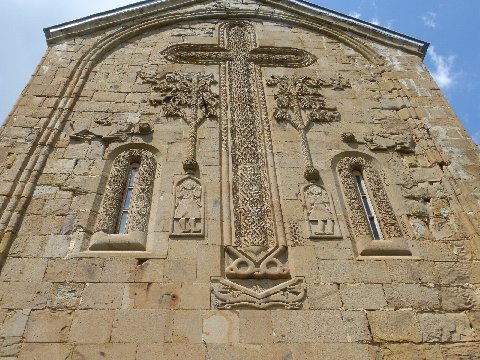
Above: 03 July 2014. Stone carving on the exterior of the Assumption Church.
Inside are 17th and 18th century frescoes.
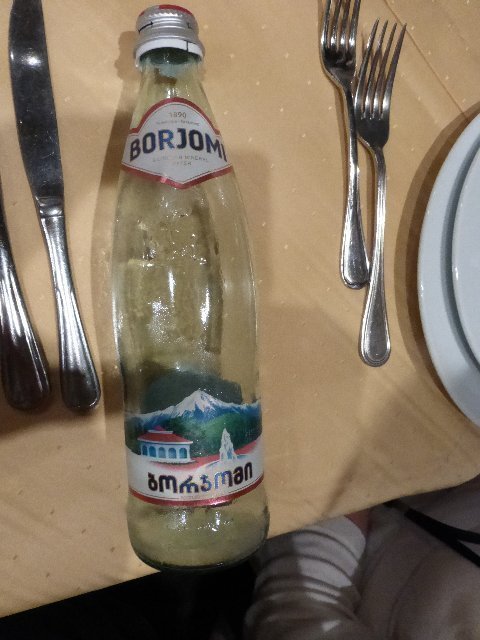
Above: 03 July 2014. For The Monk. Borjomi Water.
Borjomi Water is from.... Borjomi, Georgia, a town which we have ridden through twice, already, and a town we will ride through once again on the penultimate day of our trip which ends in Kars, Turkey.
Borjomi Water, the sparkling variety as shown here, has a slight sulphur after taste that differentiates it a bit from the better known brands.... Perrier... San Pelligrino.
I guzzled a lot of Borjomi at meals. It is served very cold.
Note the Georgian language script at the bottom of the Borjomi water bottle.
The Georgian alphabet is one of only fourteen alphabets in the world. The Georgian language is known for having numerous consonants together not separated by a vowel. The river running through Tiblisi, is Mktvari. VBRDGVNI, which strings seven consonants together, translates, loosely, as "freaking out."
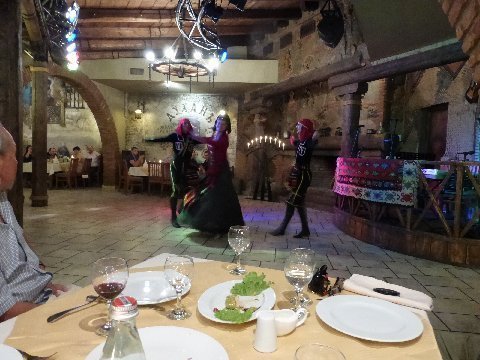
Above: 03 July 2014. Dancers. Traditional Georgian folk dance. Sololakis Kari Restaurant, Tiblisi, Georgia. Accompanying singers were off to the right.
Stalin loved to sing.
The Russian teachers (Gori religious school) were brutal pedants in Russian uniforms - tunics with gold buttons and peaked caps - who disdained the Georgian language. But one teacher was beloved - the singing master.
Simon Gogchilidze, a kindly dandy who always wore the latest fashions: spats, winged collars and a buttonhole. The schoolgirls were in love with him and even wrote songs about him. His favorite choirboy was Stalin, whom he tried to help in every way:
"In two years he learned music and began to help the conductor. There were a lot of solos and Soso always sang them." It was not just his "beautiful, sweet high voice," writes the romantic teacher, but his "grand style of performance." Stalin was often hired to sing at weddings. "People would turn up just to watch him sing, saying, 'Let's go see how the Djugashvili boy amazes everyone with that voice.'" When Stalin "appeared for the solo in the pulpit wearing his surplice and sang in his wondrous alto, it delighted everyone!"
"Young Stalin", Simon Sebag Montefiore, p. 43.
03 July 2014 Addendum:
Looks like a sensational trip but that's normally how you keep your bikes.
Markco,
Ojai, CA
Steve,
Great Trip, I am so jealous!
Any chance you are heading to Irkutsk? We have a library named after our family there.
"The Polevoy Family Library"
There are portraits of my Father and Mother in the library lobby.
My Father donated and shipped his entire Library to them, It was a 10 year project that the last shipment was opened a few weeks ago.
My Great, Great Uncle was a famous Russian author born in Irkutsk.
http://en.wikipedia.org/wiki/Nikolai_Polevoy
Best,
Ziziboy,
Salt Lake City, UT
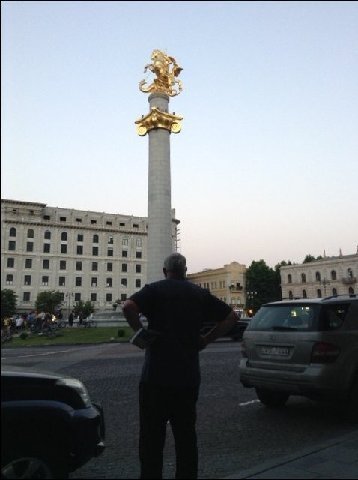
Above: 04 July 2014. The Bishop looks at St. George monument in Freedom Square,Tblisi, Georgia, his mind uncontrollably channeling back to the chaotic events that took place, right here, in 1907. In 1907, Freedom Square was called Yerevan Square.
Freedom Square was the site of the famed, 1907 Tiflis bank robbery, orchestrated by Josef Stalin.
Few outside the gang knew of the plan that day for a criminal-terrorist "spectacular," but Stalin had worked on it for months. One man who did know the broad plan was Vladimir Lenin, the leader of the Bolshevik Party, hiding in a villa in Kuakola, Finland, far to the north. Days earlier, in Berlin, and then in London, Lenin had secretly met with Stalin to order the big heist, even though their Social-Democratic Party had just strictly banned all "expropriations," the euphemism for bank robberies. But Stalin's operations, heists and killings, always conducted with meticulous attention to detail and secrecy, had made him the "main financier of the Bolshevik Centre.".....
On that dazzling steamy morning, the Oriental colour of Tiflis (now Tbilisi, the capital of the Republic of Georgia) hardly seemed to belong to the same world as the Tsar's capital, St. Petersburg, a thousand miles away. the older streets, without running water or electricity, wound up the slopes of Mtatsminda, Holy Mountain, until they were impossibly steep, full of crookedly picturesque houses weighed down with balconies entwined with old vines. Tiflis was a big village where everyone knew everyone else....
Exotically dressed hawkers and stalls offered spicy Georgian lobio beans and hot khachapuri cheesecake. Water-carriers, street-traders, pick-pockets and porters delivered to or stole from the Armenian and Persian Bazaars, the alleyways of which more resembled a Levantine souk than a European city. Caravans of camels and donkeys, loaded with silks and spices from Persia and Turkestan, fruit and wineskins from the lush Georgian countryside, ambled through the gates of the Caravanserai. Its young waiters and errand boys served its clientele of guests and diners, carrying in the bags, unharnessing the camels - and watching the square.....
Kamo "was completely enthralled" by Stalin, who had converted him to Marxism. They had grown up together in the violent town of Gori forty-five miles away. He was a bank robber of ingenious audacity, a Houdini of prison-escapes, a credulous simpleton - and a half-insane practitioner of psychopathic violence. Intensely, eerily tranquil with a weird "lustreless face" and a blank gaze, he was keen to serve his master, often begging Stalin: "Let me kill him for you!" No deed of macabre horror or courageous flamboyance was beyond him: he later plunged his hand into a man's chest and cut out his heart.....
The Stalin of 1907 was a small wiry, mysterious man of many aliases, usually dressed in a red satin shirt, grey coat and his trademark black fedora. Sometimes he favored a traditional Georgian chokha, and he liked to sport a white Caucasian hood, draped dashingly over his shoulder. Always on the move, often on the run, he used the many uniforms of Tsarist society as his disguises, and frequenty escaped manhunts by dressing in drag.
Attractive to women, often singing Georgian melodies and declaiming poetry, he was charismatic and humorous, yet profoundly morose, an odd Georgian with a northern coldness. his "burning" eyes were honey-flecked when friendly, yellow when angry. He had not settled on the moustache and hair en brosse of his prime: he sometimes grew a full beard and long hair, still with the auburn tinge of his youth, now darkening. Freckled and pockmarked, he walked fast but crookedly, and held his left arm stiffly, after a spate of childhood accidents and illnesses.
Indefatigable in action, he bubbled with ideas and ingenuity. Inspired by a hunger for learning and an instinct to teach, he feverishly studied novels and history, but his love letters was always overwhelmed by his drive to command and dominate, to vanquish enemies and avenge slights. Patient, calm and modest, he could also be vainglorious, pushy and thin-skinned, with outbursts of viciousness just a short fuse away.
Immersed in the honour and loyalty culture of Georgia, he was the gritty realist, the sarcastic cynic and the pitiless cuttthroat par excellence. It was he who had created the Bolshevik bank-robbery and assassination courseness of a peasant, a trait which alienated comrades but usefully concealed his subtle gitfs from snobbish rivals.....
Just as the robbery was about to collapse, "Captain" Kamo rode into the square driving his own phaeton, reins in one hand and firing his Mauser with the other. Furious that the plan had failed, cursing at the top of his voice "like a real captain," he whirled his carriage round and round, effectively retaking possession of the square. Then he galloped up to Datiko, leaned down and, aided by one of the gun girls, heaved the sacks of money into the phaeton. He turned the carriage precipitously and galloped back up the boulevard right past the Viceroy's Palace, which was buzzing like a beehive as troops massed, Cossacks saddled up and orders for reinforcements were despatched.
Kamo notice a police phaeton cantering along the opposite direction bearing A.G. Balabansky, the deputy police chief. "The money's safe. run to the square," shouted Kamo. Balabansky headed for the square. Only the next day did Balabansky realize his mistake. He committed suicide....
The shockwaves of Stalin's spectacular reverberated around the world. In London The Daily Mirror announced RAIN OF BOMBS; REVOLUTIONARIES HURL DESTRUCTION AMONG LARGE CROWDS OF PEOPLE: "About ten bombs were hurled today, one after another, in the square in the centre of town, thronged with people. The bombs exploded with terrific force, many being killed..." The
Times just called it TIFLIS BOMB OUTRAGE; Le Temps in Paris was more laconic: CATASTROPHE.
In another sense, the Tiflis spectacular was the making of him. Stalin had now proved himself, not only as a gifted politician but also as a ruthless man of action, to the one patron who really counted. Lenin decided that Stalin was "exactly the kind of person I need."
"Young Stalin," Simon Sebag Montefiore
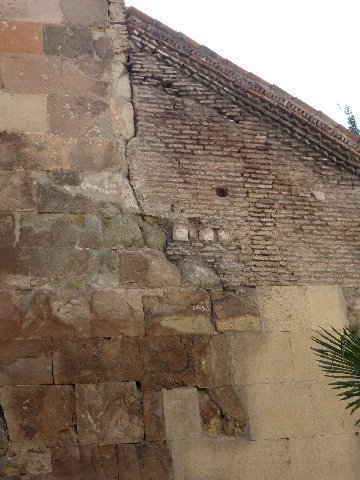
Above: 04 July 2014. Wall from the Anchiskhati Basilica, Tbilisi's oldest surviving church built by King Gorgasali's son Dachi in the 6th century. Old Town, Tbilisi, Georgia.
Armenia and Georgia were the among first countries... or peoples.... to adopt Christianity.
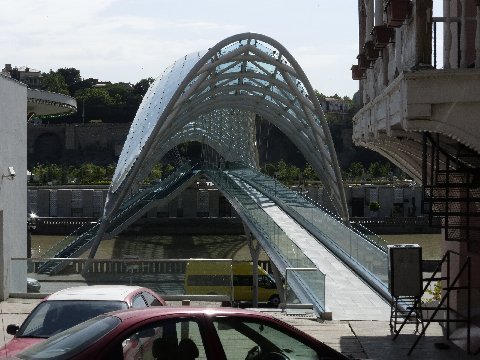
Above: 04 July 2014. The Bridge of Peace, Tbilisi, Georgia.
The bridge, which stretches 490 feet over the Mtktvari River was ordered by the city Hall of Tbilisi to create a contemporary design feature connecting Old Tbilisi with the new district.
Our MotoDiscovery/Kazoom Motorcycle Adventures group walked through Old Tbilisi with our guide, young thirties, Nene.
Nowhere better blends the romance of Georgia's past with its striving for anew future than Tbilisi's Old Town. Winding lanes lined by rakishly leaning houses lead past tranquil old stone churches to shady squares and glimpses of the unltracontemporary Peace Bridge spanning the Mtkvari River. Causual cafes and bohemian bars rub shoulders with trendy lounge clubs, folksy carpet shops, new travelers' hostels and small quirky hotels. The aeons-old silhouette of Nariqala Fortress supervises everything, while Georgia's 21st century Presidential Palace, with its egg-shaped glass dome, looks on from over the river. "Lonely Planet, Georgia, Armenia, and Azerbaijan."
Asia or Europe?
I posed the following question to Nene as we walked through Old Tbilisi. "True or False." Georgia is in Asia. She thought for a moment, smiled, and said, "False.... but...." We who were near her awaiting her answer, laughed.
Having been in the Caucusus for over a week, I am beginning to understand why this question has been difficult to answer. Each of Azerbaijan, Georgia, and Armenia has characteristics of both Asia and Europe.
Contrast the western look of their cities, but the eastern sounding music of Armenia.... and the eastern food: shasliks, cheese pies, and kebabs of Georgia.
Though the cartographer may consider the geography of the Caucasus as part of Europe, consider that Georgia, for one, has been a vassal of the Arabs and the Persians over centuries.
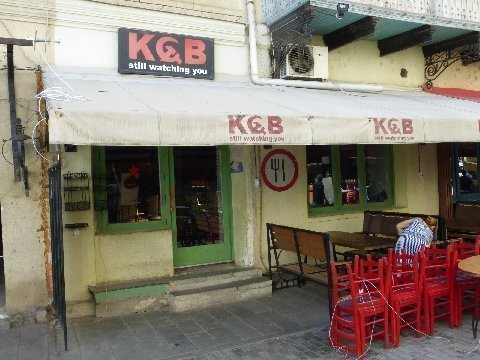
Above: 04 July 2014. KBG Cafe, Old Town, Tiblisi, Georgia.
Georgian humor after the demise of the Soviet Union?
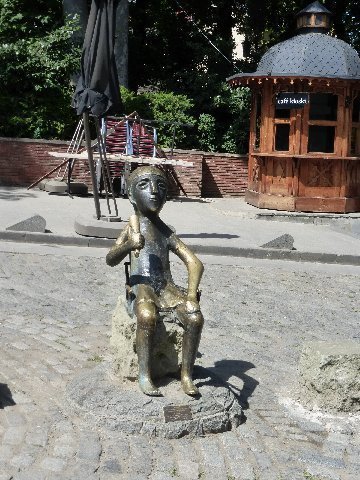
Above: 04 July 2014. Stature of Toast Master, Tamada. Old city. Tblisi, Georgia.
tamada[1] (Georgian: თამადა, Russian: Тамада) is a Georgian toastmaster at a Georgian Supra (feast) or at a Russian wedding,[2] corresponding to the symposiarch at the Greek symposion or the thyle at the Anglo-Saxon sumbel.
At all Supras regardless of size, there is a tamada (or toastmaster), one person who introduces each toast. Georgians like to say that the tamada is dictator of the table, but it would be more appropriate to compare him to a leader or even a teacher. Tamada ought to be eloquent, intelligent, smart, sharp−witted and quick−thinking, with a good sense of humor because very often some of the guests might try to compete with him on the toast making. At the Georgian table a tamada bridges the gap between past, present and then the future. It seems that not only the guests, but their ancestors and descendants are invisibly present at the table. A tamada toasts them with the same love and devotion as the other members of the table. When drinking some toasts all men have to stand up and drink wine in silence. A toast can be proposed only by a tamada and the rest are to develop the idea. Everybody tries to say something more original and emotional than the previous speaker. The whole process grows into a sort of oratory contest.
Historically the tamada had more control over the table than today, which might explain why people report him to be more dictatorial than he ever is at urban Supras. For example, members of the Supra were supposed to ask permission before leaving the table and the party. If they got the permission they could be toasted by the tamada and other members before leaving. If the first toast is to the tamada, it is proposed by someone else, generally by the host, who proposes the nomination of the tamada. Wikepdia

Above: 04 July 2014. Mother of Georgia statue, overlooking Tbilisi, Georgia.
Kartlis Deda (Georgian: ქართლის დედა; Mother of Kartli) is a monument in Georgia’s capital Tbilisi, which has become a symbol of the city.
The statue was erected on the top of Sololaki hill in 1958, the year Tbilisi celebrated its 1500th anniversary. Prominent Georgian sculptor Elguja Amashukeli designed the twenty-metre aluminium figure of a woman in Georgian national dress. She symbolizes the Georgian national character: in her left hand she holds a bowl of wine to greet those who come as friends, and in her right hand is a sword for those who come as enemies. (Wikepedia)
Reminds of the Mother of Armenia Stature, in Yerevan.
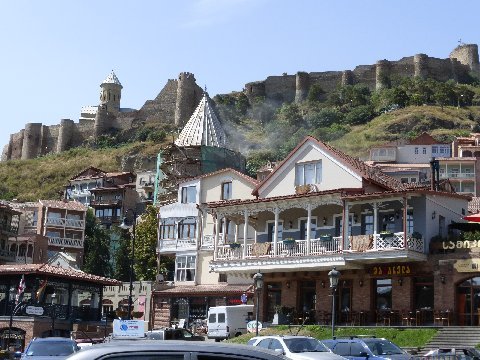
Above: 04 July 2014. Nariqala Fortress looks over Tbilisi.
Led by Nene, Taos and Mwah walked up to the fortress.
Dominating the Old Town skyline, Nariqala dates right back to the 4th century, when it was a Persian citadel. The most direct way up to it is by the street beside the Armenian Cathedral of St George. The tower foundations and most of the present walls were built in the 8th century by the Arab emirs, whose palace was inside the fortress. Subsequently Georgians, Turks and Persians captured and patched up Nariqala, but in 1827 a huge explosion of Russian munitions stored here ruined not only the fortress but also the Church of St Nicholas inside it. The church was rebuilt in the 1990s with the help of funding from a police chief. There are superb views over Tbilisi from the top of the fortress. "Lonely Planet"
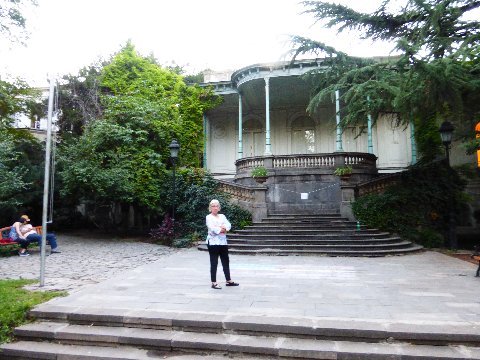
Above: TIMDT stands at the front step of the original, now abandoned, Tbilisi Theological Seminary, Tbilisi, Georgia. 04 July 2014.
The boy of sixteen from Gori, accustomed to the freedom of fighting in the streets or climbing Gorijvari, now found himself locked for virtually every hour of the day in an institution that more resembled the academy: the dormitories, the bullying boys, the rife buggery, the cruel, sanctimonious teachers and the hours in the detention cells made it a Caucasian version of Tom Brown's Schooldays...
Soso and the other 600 trainee priests lived in a four-storey neo classical seminary with noble white pillars. On the top floor, he shared a dormitory of twenty or thirty beds. The other floors contained a chapel, classrooms and a refectory. In a day strictly divided by ringing bells, Soso was awoken every morning at 7 a.m., donned his surplice uniform, then proceeded to prayers in chapel followed by tea and classes. The pupil on duty read another prayer. There were lessons until two. At three he had lunch,, then an hour and a half off before call-over at five, after which he was banned from going out again. After evening prayers, supper was at eight, followed by more classes then yet more prayers and lights-out at 10 p.m. At weekends the church services were interminable, "three or four hours on the same spot, shifting from one leg to the other, under the tireless penetrating eyes of the monks." But the boys were allowed out between 3 and 5 p.m.....
The Empire's seminaries were "notorious for the savagery of their customs, medieval pedagoguery, and law of the fist," comments Trotsky. "All the vices banned by the Holy Scriptures flourished in this hotbed of piety." This seminary, nicknamed the Stone Sack, was worse than most: "utterly joyless," reported one pupil. "Droningly boring - we felt we were in prison."....
The seminary was to pull off the singular achievement of supplying the Russian Revolution with some of its most ruthless radicals. "No secular schoo," wrote another seminarist, Stalin's comrade Philip Makharadze, "produced as many atheists as the Tiflis Seminary." The Stone Sack literally became a boarding-school for revolutionaries.
"Young Stalin," Simon Sebag Montefiore
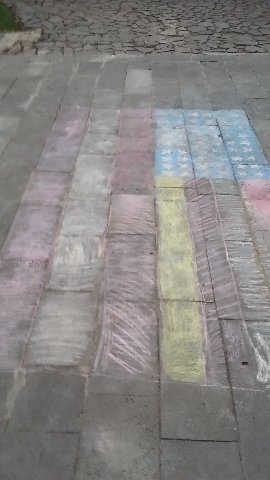
Above: 04 July 2014. Impressionistic chalk drawing of American flag. On steps of now abandoned, but still standing, Tiblisi Theological Seminary. Stalin want to high school here in mid 1890's. He entered the school to become a priest. He left as a radicalized, anti Tsar, atheist, Bolchevik... a supporter of V.I. Lenin.
What did the artist intend coloring one of the stripes, yellow?
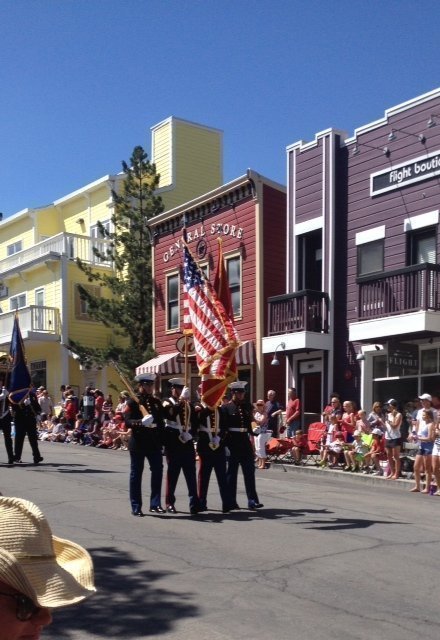
Above Color Guard, 4th of July Parade, Park City, UT. 04 July 2014, Park City, UT
Kudo's to TWO3
04 July 2014 Addendum:
Steve, glad you found the Borjomi--I recall a salty taste. I liked the photo of you and the two Chechens--the guy with his arm around you looks like he could slit your throat while drinking his Borjomi. If I recall correctly, J. Henry told me once that many of the slavic languages originate in the Caucasus. I am really enjoying your commentary and photos and only wish I were there.
TIMDT is a real trooper.
The Monk
pohan is pagan in czech--or gentile. that from a czech girlfiend :) enjoying you picto trip..
brand man, venice, ca
Great stuff . . I am inspired to do similar.
Hand, San Jose, CA
thank you for the well illustrated history lesson steve.
brand man, venice, ca
So good to know that you are home and okay... ... Steve's blogs are really great - a real history lesson along with all the comments and photos.
Aunt Joyce,
Ashland, OR
another great one. thanks.
brand man, venice, ca
by the way--pagan is not necessarily religious or a belief as most hippies would have you believe--it is the same as peasant, peon, paisano and in some cases--gentile. (had a librarian girlfriend:)
brand man, venice, ca
So, how are we supposed to feel about Stalin?
.........................................................................................................................
MotoDiscovery/Kazoom Motorcycle Adventures Tour - From the Black Sea to the Caspian. 05 July 2014.
We are riding our motorcycles from Tbilisi, Georgia to Kars, Turkey, 200 km. Stop-off in Gori, Georgia, birthplace of Josef Stalin, to visit the Josef Stalin Museum.
Today, 05 July 2014, ends a motorcycle ride through Azerbaijan, Georgia, Armenia, Dagestan, Chechnya, and North Ossetia...broadly, the Caucusus Region. The area is the setting for the growth and development of "Young Stalin" who, as the world's most successful - for a time - exponent of totalitarianism, became one of the most important - and controversial - figures of the modern world.
I have made "Young Stalin," as characterized in the book, "Young Stalin," by Simon Sebag Montefiore, a subtext of this motorcycle trip. Today's visit to Gori, where Stalin was born and raised, is a culmination of the tour's (for me) Stalin subtext theme.
Following are random images taken from within the Josef Stalin Museum Gori, Georgia, ... and commentary.
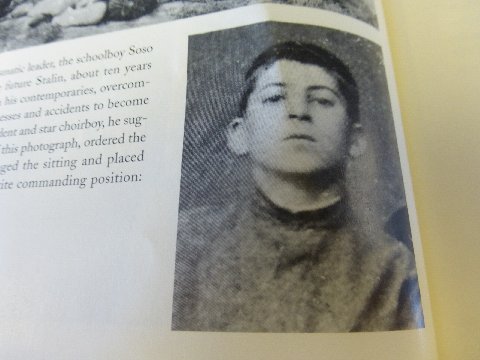
Above: Josef Stalin, at about 10, school picture from Gori church school.
...We avoided him out of fear," says Iremashvili, "but we were interested in him" because there was something peculiarly "unchildish" and "excessively passionate" about him. H was an odd child: when he was happy, "he'd express his satisfaction in the most peculiar way. he'd snap his fingers, yell loudly and jump around on one leg!" Whether written within the oppressive cult of personality when Stalin was a dictator or in vicious opposition to him, all memoirs of his childhood agree that Stalin, even aged ten, exerted a singular magnetism...
...He was a typical Goreli, for the denizen of Gori was notorious throughout Georgia as a matrabazi, a boastful, violent scallywag. Gori was one of the last towns to practice the "picturesque and savage custom" of free-for- all town brawls with special rules but no-holds-barred violence. The boozing, praying and fighting were all interconnected, with drunken priests acting as referees. The sallon-bars of Gori were incorrigible stews of violence and crime....
...no one could quell Gori's irrepressible lawlessness. It was no wonder too that, during the punch-ups, horses bolted and phaetons knocked down youngsters on the streets. Psychological historians attribute much of Stalin's development to his drunken father, but this streetfighting culture was just as formative...
Town brawls, wrestling tournaments and schoolboy gang-warfare were the three Goreli fighting traditions...
...The boys' real energies were reserved for gang-warfare. "The kids of our hometown were organized into gangs based on the streets or quarter where they lived. These bands were in constant warfare" - though they were melting pots too. "Gori's kids were educated together in the street without distinction of religion, nationality or fortune."
The schoolboy Stalin, like the politician he became, was a bundle of contradictions: "Soso Djugashvili," Iremashvili sums up, "was the best but also the naughtiest pupil.".
"Young Stalin," Simon Sebag Montefiore
Stalin was expelled from the seminary in 1899 for missing his exams... this is about the time he became enamored by the works of V.I. Lenin.

Above: Map showing Stalin's exiles at hand of Tsar, and escape/returns, prior to the successful 1917 Bolshevik revolution.
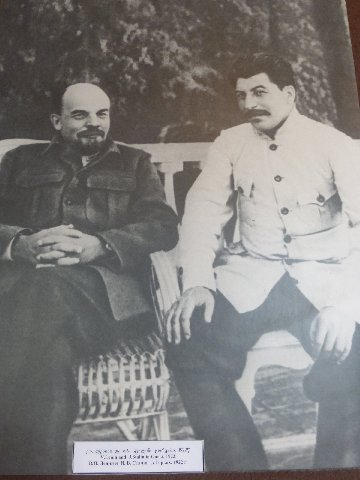
Above: Lenin and Stalin. Gorki, 1922.
Gorki 1922. Lenin lived in Gorki in a state of semi-retirement after a stroke. Stalin visited Gorki frequentlky andbecame Lenin's voice tube back to the party apparatus.
Lenin became increasingly critical of Stalin until he (Lenin) died in 1924. Stalin was able to suppress Stalin criticisms Lenin wrote just prior to his death thereby maneuvering successfully to consolidate his own control.
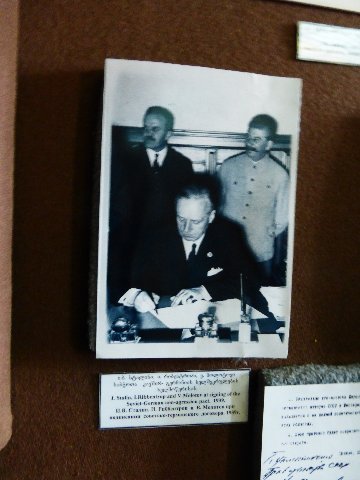
Above: Stalin, right, with J. von Ribbentrop (seated) and V. Molatov signing the 1939 Soviet/German non-aggression pact.
The pact's publicly stated intentions were a guarantee of non-belligerence by either party towards the other and a commitment that neither party (Russia or Germany) would ally itself to or aid an enemy of the other party.
The pact remained in force until the German government broke it by invading the Soviet Union on 22 June 1941.
So, how are we supposed to feel about Stalin?
By opening up an Eastern front in World War (violating the Ribbentrop/Molatov non aggression pact) Hitler turned from Stalin's "friend" to his enemy. In fighting Hitler on the eastern front, Russia absorbed the brunt of the casualties suffered by the allies during WWII. Without Stalin's help, Britain could have ended up as a German vassal country and the United States, at best, would have been isolated in the world.
Stalin was twice Time Magazine's Person of the Year.
Yet... Stalin was a ruthless killer of his own people.
1 million people were imprisoned or exiled between 1927 to 1929.
9 to 11 million peasants were forced off their lands and another 2 to 3 million peasants were arrested or exiled in the mass collectivization program.
6 to 7 million peasants were killed by an artificial famine in 1932-1934 when Stalin force-collectivized farms (mainly Ukrainian).
1 million people were exiled from Moscow and Leningrad in 1935.
1 million people were executed during the "Great Terror" of 1937-1938.
4 to 6 million people were dispatched to forced labor camps.
10 to 12 million people were forcibly relocated in WWII.
1 million people were arrested for various "political crimes" from 1946 to 1953.
Although not everyone who was swept up in the aforementioned events died from unnatural causes... Roy Medvedev, a Russian historian, estimates that there were 20 million non-combatant deaths attributed to Josef Stalin. Most consider this a conservative estimate.
Aleksandr Solzhenitsyn, who wrote about the Soviet gulag system, claimed the true number of Stalin's victims might have been as high as 60 million.
In his book, "Unnatural Deaths in the U.S.S.R.: 1928-1954," I.G. Dvadkin estimated that the U.S.S.R. suffered 56 to 62 million "unnatural deaths" during that period, with 24 to 49 million directly linked to Stalin.
From those to whom I talked about Stalin while traveling through the Caucasus, there seems to be considerable ambivalence about the Gori, Georgia native.
I would distill the feedback I heard thus: "Stalin is liked and respected by many of the older citizens, but the young people don't like him."
The Caucasus republics fared pretty well during the Soviet period. Jobs were plentiful even if there wasn't much to buy. Some of the older generation seem to miss such "good times."
In 1992, when the Soviet Union collapsed, federal subsidies and support to the Caucasus countries ended. Each of Armenia, Azerbaijan, and Georgia underwent four or five years of real hardship when their economies tanked. Food was in short supply. Electrical grids were down for years. People were literally burning the furniture to supply heating.
Today, when the Caucasus countries, former Soviet vassal states, are recovering as independent entities, with growing economies... even if unemployment remains high, and income not well distributed, younger people are hopeful. I asked our Tbilisi guide, Nene, if she was hopeful about the future and she said, "yes..., I and my generation are hopeful about the future."
Caucusus young people are more connected to the world by internet, cable TV, and social media. They can better understand, as compared to the previous generation, the contrasts between the brutal, oppressive system that Stalin set up and democratic system... hence, their disdain for Stalin today.
It understandable that some of the older people remember fondly the good old days of plentiful jobs and support from the Soviets where the young people, more in tune with the possibilities freedom provides, have different views about Stalin and the Soviet era.
The evils done by Stalin in killing his own people are staggering in their scope.
It must be a real challenge for Georgia to deal with Gori grown Stalin and his legacy.
The Gori museum, where we spent about an hour and a half, is in a 1950's Stalin/Soviet commissioned building where, according to our museum guide, Stalin wanted to tell the story of the Russian revolution. When Stalin died, the museum became a showpiece for the life of Stalin himself.
The museum is somewhat run down... we saw only a few Asian tourists while we were there. No locals. The guide said the museum is funded by the Georgian Government.
Its seemed to me as though Gori, Georgia was saying..."we're not sure we really like this guy anymore... he was a killer... and persecuted many Georgians. Notwithstanding he was born here in Gory...his importance in being a key contributor to the allied victory in WWII and to overseeing a period of significant industrialization in the U.S.S.R., can't really be ignored. Let's not put a lot of effort into this museum... but, let's not shut it down, either."
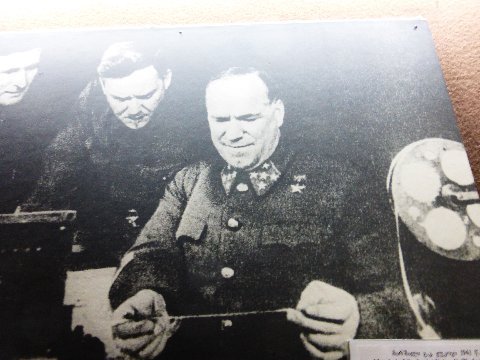
Above: Gregory Zhukov
Zhukov was a Soviet career officer in the Red Army who, in the course of World War II, played a role in leading the Red Army drive through much of Eastern Europe to liberate the Soviet Union and other nations from the occupation of the Axis Powers and, ultimately, to conquer Berlin. He is the most decorated general officer in the history of the Soviet Union and Russia.
Amongst many notable generals in World War II, Zhukov was placed at the top due to the number and scale of victories, and his talent in operational and strategic command was recognized by many people. Many famous military leaders in the world such as Bernard Montgomery and Dwight D. Eisenhower recognized Zhukov's great contributions in many important victories in the Second World War His combat achievements became valuable heritages in humanity's military knowledge, exerting great influence on both the Soviet and the whole world's military theory.
Wikepedia.
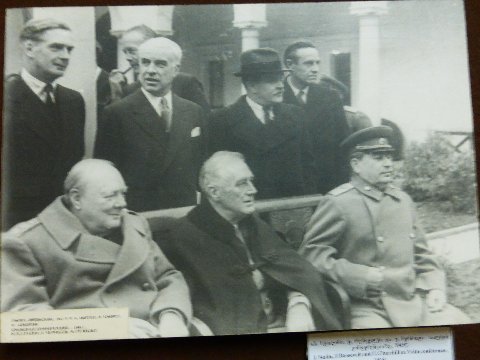
Above: Three "friends." Churchill, FDR, and Josef Stalin at 1945 Yalta conference.
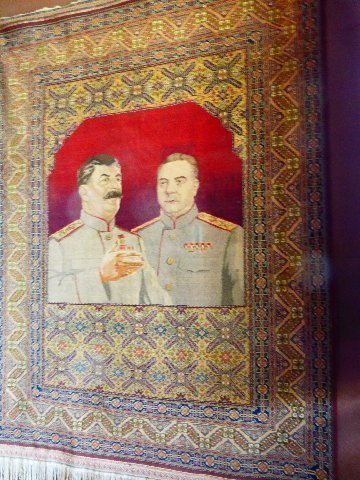
Above: Azeri Carpet showing images of Stalin and Zhukov.
Fabricated in 1945. I felt the weave... it was very tight. Valuable (to someone, I'd guess), likely, for its quality weave and its one of a kind uniqueness.
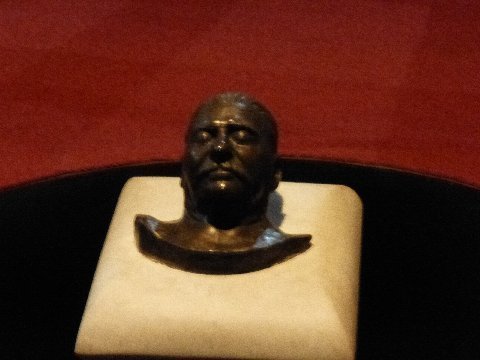
Above: Stalin death mask.
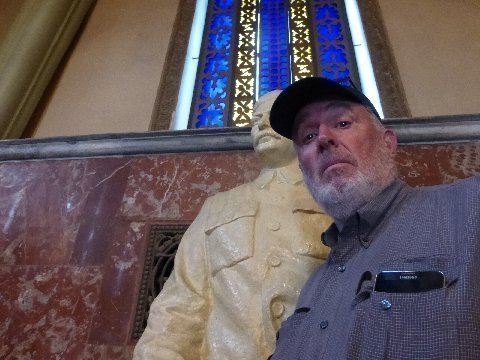
Above: Stalin and The Bishop. Selfie. Josef Stalin Museum, Gori, Georgia. 05 July 2014.
05 July 2014 Addendum:
Hi Steve :-)
It seems unbelivable for me: my first attempt to moto in Georgia was in 2008 - but one week before start of our trip the Russian-Georgia war started. Next attempt - we decided to make this trip this year - riding across Ukraine. And what? War in Ukraine started...At mom I do not want to think abt going to Georgia during next two years ;-) Instead - in one week I'm riding to Scotland...:-)
kisses-
Johanna, Warsaw, Poland
Welcome back. Let's get together when u r up for it and see your photos of trip. Glad u r back safe and sound. What an adventure!!
Comic Mom, Park City, UT
Good thing you were too tired to take the ride in Grozny--it might have been your last.
That image of Stalin is so kind and loving--could hang in a church as picture of Christ.
The Monk,
Salina, UT
Morning Margaret...
What an adventure, it must have been terrifying for all concerned...those on their bikes, the pillion riders (another new word for me), separated in the car...
The Airport Marriott must have seemed like paradise by then...especially after the no name, no water, 2 bread hotel!!!
There is a part of me that is also envious to not create a trip like that for my life, but other parts of me would be to scared to go...
You are a well traveled trouper, and many would say "a real good woman!!!" Which you are. I loved the picture of you in the village with the 3 Russian women...very beautiful...
I have an 8:15 this morning with the ophthalmologist, and it's 6:45, so I have to jump in the shower...
Thank you so much for sharing so much with me...
Hi to Steve...
Love,
Carol
New York City, NY
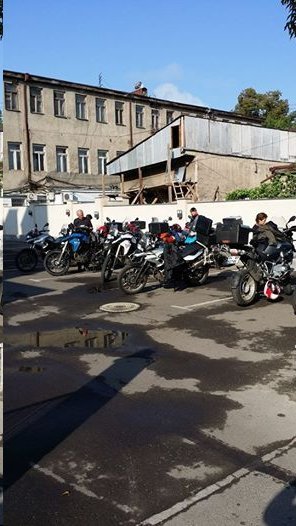
Above: 06 July 2014. Riders ready motorcycles for the final riding segment of the tour. Parking lot, Hotel Lomsia, Akhaltsikhe, Georgia.
Today, Georgia/Turkey border crossing, visit to ancient Armenian city of Ani (now in Turkey), and Kars, Turkey and end of the motorcycle segment of the trip. 280 kilometers, including detour to Ani.
The rented bikes will be shipped via truck, 1200 miles to the owner/outfitter, BMW Motorcycles of Istanbul.
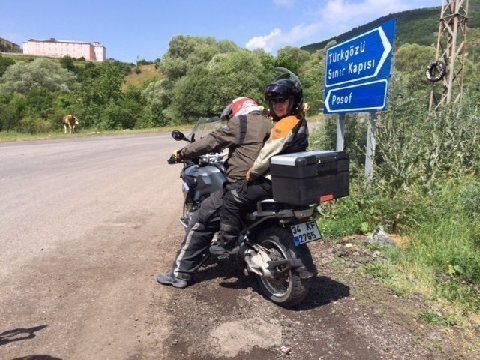
Above: 06 July 2014. The Bishop and TIMDT, riding a BMW R1200 GS motorcycle, parked at intersection in eastern Turkey after having, five kilometers previously, crossed the frontier from Georgia into Turkey. Destination, Kars, Turkey... the final ride of the MotoDiscovery/Kazoom Motorcycle Adventures motorcycle adventure into the Caucasus... from the Black Sea to the Caspian.... Josef Stalin's spawning grounds.
Image by Claudia.
06 July 2014.
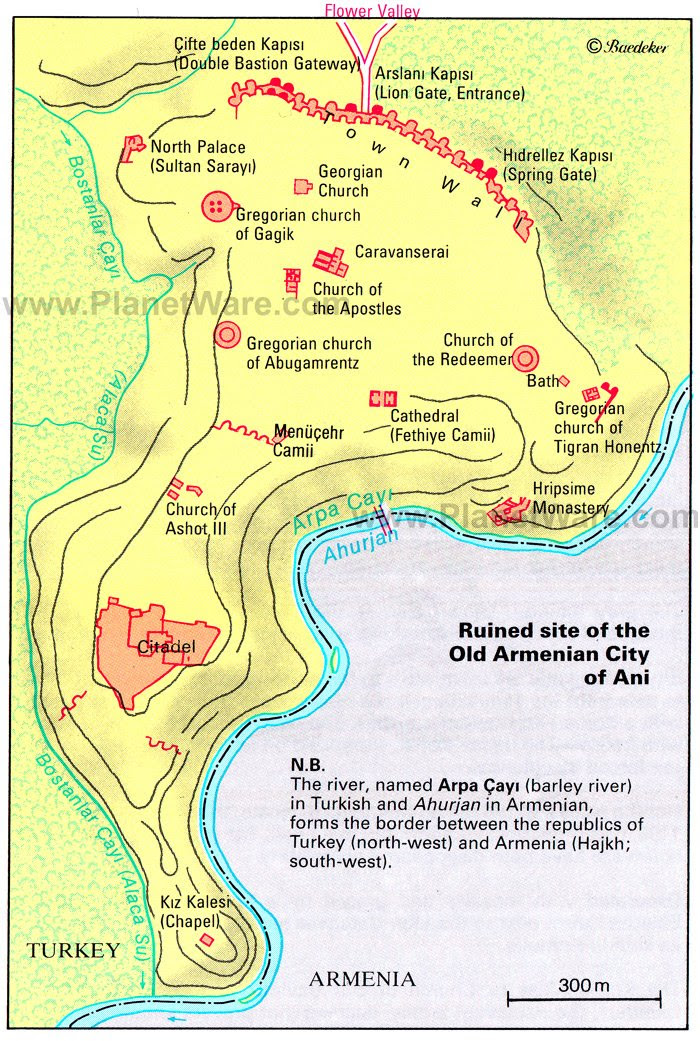
Above: 06 July 2014. Map of Ani, ancient Armenian city in Eastern Turkey.
Before reaching Kars, we took a 90 km round trip detour to the ancient Armenian capital, Ani.
Ani was once a powerful Silk Road city which today sits abandoned on the plains close to Turkey's modern border with Armenia.
Between 961 and 1045 it was the capital of the medieval Armenian Kingdom that covered much of present day Armenia and eastern Turkey.
Ani stood on various trade routes and its many religious buildings, palaces, and fortifications were amongst the most technically and artistically advanced structures in the world.
At its height, Ani had a population of 100,000–200,000 people and was the rival of Constantinople, Baghdad and Damascus. Long ago renowned for its splendor and magnificence, Ani was abandoned and largely forgotten following the earthquake of 1319.
Once beautiful red brick buildings are crumbling away amidst the steppe grass. The effect of the setting is mesmerizing.
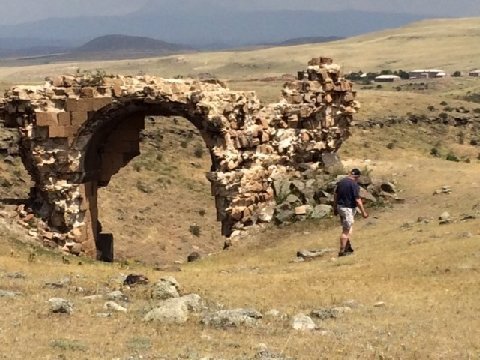
Above: 06 July 2014. The Bishop walks back from archway ruin at Ani. Image by Claudia.
In the far distance, across the Arpa Cayi river, not visible in image, is an Armenian military installation.
Armenia and Turkey have no diplomatic relations due to a 100 year dispute, due, from Armenia's point of view, to Turkey's failure to recognize its culpability in the so-called Armenian Genocide, where 1.5 million Armenians were putatively killed by the Ottoman Turks during WWI.
Armenia has criticized Turkey for what it says are anemic efforts to maintain and restore the Ani ruin.
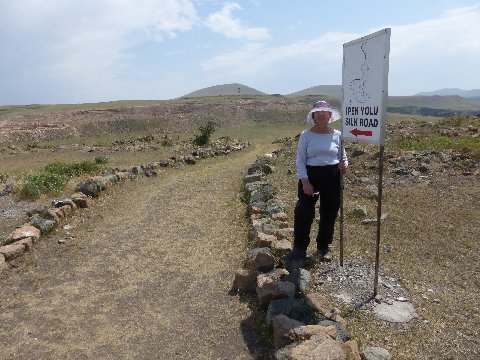
Above: 06 July 2014. TIMDT on the Silk Road.
From this point, China is 2000 miles to the east, and the Black Sea with its shipping access, via the Dardanelle Straits, to the traders of far off Venice, is over 1000 miles across Anatolia.
I try to imagine how... centuries ago... camel trains from China passed directly through Ani... a hundred years before China was accessible by ship around the Cape of Good Hope.
Venice trader Marco Polo likely passed through Ani on his visit to China in the 13th century.
Ani makes many lists of the top ten tourist attractions in Turkey... yet, because of its isolation, it is little known and little visited. Kars, where there are decent hotel accommodations and a very good airport, is 45 kilometers away.
Sumela Monestery, near Trabzon, Turkey, which we visited on the first riding day of our motorcycle tour, is also a top ten attraction.
Other top ten Turkey sites include Haggia Sophia, Ephesus, Cappadocia, Topkapi Palace, and Aspendos... all of which TIMDT and Mwah (sic) have visited on prior trips to Turkey.
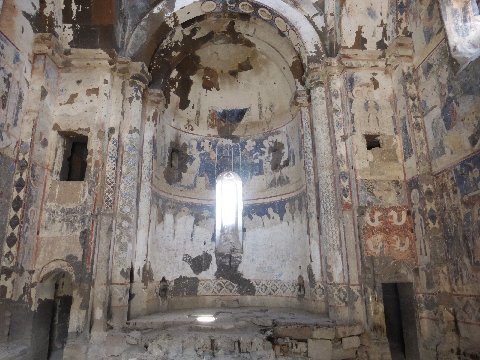
Above: 06 July 2014. Original 10th century fresco remnants in the Church of St. Gregory. Ani, Turkey.
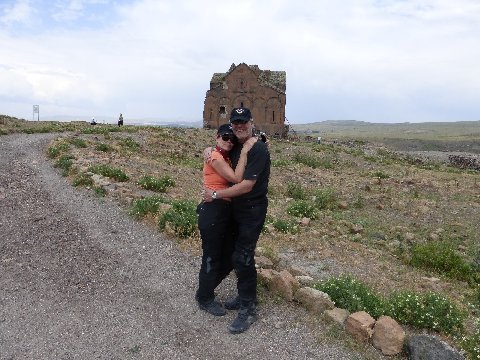
Above: Annie Oakely and Plane.
Lovebird shot at Ani, Turkey. 06 July 2014.
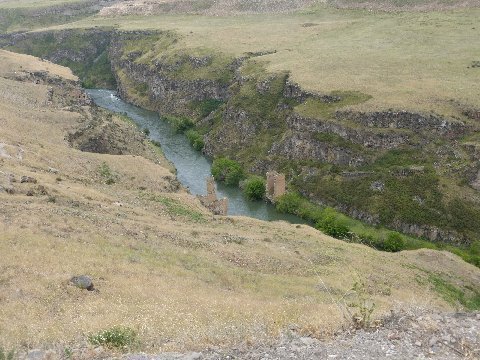
Above: 06 July 2014. Arpa Cayi River. Defines the border between present day Turkey and Armenia.
Note Silk Road bridge ruin. Countless camel trains and Marco Polo crossed this bridge traveling between China and the Black Sea.
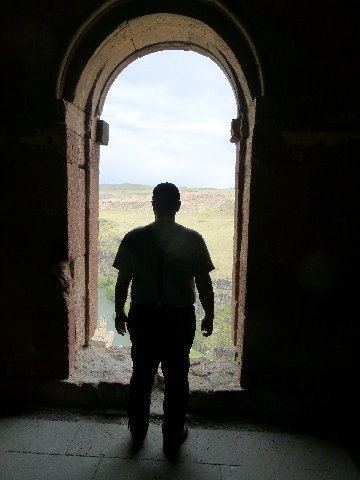
Above: Shock looks through Minuchihr Mosque window towards Arpa Cayi River and Armenia.
The presence of a mosque in this otherwise Christian city is a matter of ongoing controversy.
This mosque, built at the very edge of the ravine overlooking the Akhurian River or Arpa Çay, is said to have been founded by the emir Minuchihr. He was the first of the Shaddadid dynasty that ruled Ani from around the year 1072 onwards. However, the actual construction date and origin of this building is still subject to much argument - arguments based more on competing nationalistic claims of Armenia and Turkey than on any hard architectural or archaeological evidence.
Some (Armenians mostly) hold that the building predates the Turkish conquest and that it was originally a palace from the Bagratid period, later converted into a mosque. Nikolai Marr, in a surprising lapse of reasoning, dated it to the reign of King Ashot III for no other reason than that the colour of its stone is similar to that of the nearby Wall of Ashot. Because of its position beside King Ashot's walls, and its fortified appearance, it has also been suggested that it was originally a customs house, or even the residence of the Armenian Catholicos. Another Armenian theory is that the building is actually the zhamatun of a now destroyed church, converted to a mosque after the church's destruction. These theories have the same dubious basis - the belief that the Muslim rulers of Ani were incapable of building anything substantial during their period of control.
Others (Turks mostly) consider the whole structure to have been purpose-built as a mosque just after the Turkish conquest of Ani, making it the earliest surviving Turkish mosque in Anatolia.
Yet others suggest that though it was built as a mosque, it dates from a later period since the interior is similar to other 12th and 13th century buildings. I believe this to be the most likely option, but that the present structure partly utilises older foundations - hence its strange alignment. Also, the minaret predates the present structure, which explains the minaret's strange location, and was probably built to accompany an earlier mosque.
Source: VirtualANI
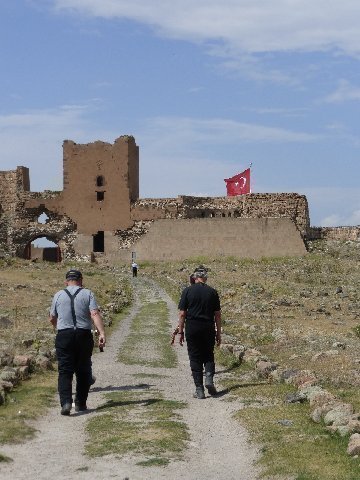
Above: 06 July 2014. Turkish flag flies over Ani Citidel...ancient Armenian city of Ani, Turkey.
For the Armenians, the presence of the Turkish flag flying over Ani must grate a bit as they monitor the site through field glasses from their military base across the Arpa Cayi river.
Notwithstanding the festering dispute about the "Armenian Genocide," in 2009, diplomatic relations were almost renewed between Turkey and Armenia. Turkey backed out at the last minute due Armenia's "belligerence" towards fellow Turkic country, Azerbaijan on the Nagorno Karabach question.
Interestingly, the story board at the entrance to the site, written in both Turkish and English, makes no mention of the terms, Armenia or Armenian, with respect to Ani's origins.
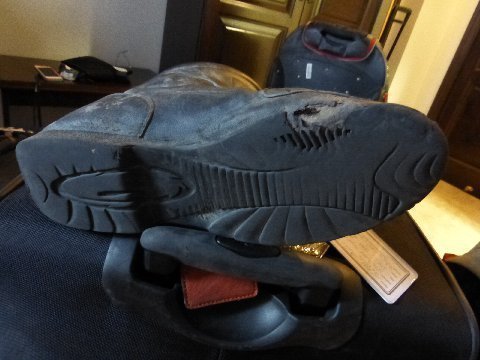
Above: 06 July 2014. My motorcycle boots in our hotel room, Hotel Cheltikov, Kars, Turkey.
Time to dump the boots.
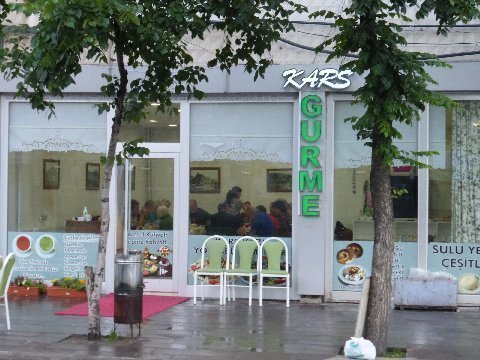
Above: 06 July 2014. Our motorcycle tour group dines at Gurme Restaurant, which specializes in goose, Kars Turkey.
It is Ramadan so there is not much going on at Kars restaurants, before sundown, at Kars restaurants. Alcoholic drinks are not available before sundown, even for tourists.
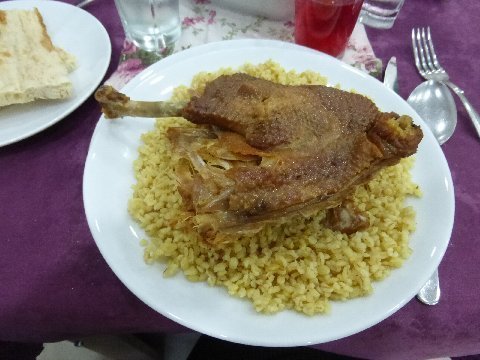
Above: 06 July 2014. Bulgar and goose. Gurme Restaurant. Kars, Turkey.
Very good! Dark... almost reddish meat.
We have seen gaggles of geese frequently as we ride through Turkish villages.
06 July 2014 Addendum:
Loved the history lesson and all your amazing experiences you so elegantly and generously share.
LaDoc and LaPsy,
Los Angeles, CA
another great one and thank you for the stalin stats.
brand man,
venice, ca
In that last photo which one is Stalin, the one on the right or the one on the left?? In Russia I often heard that Lenin was critical of Stalin. I flew into New York late one evening from Moscow dead tired with some Russian friends. A friend and his wife invited us all to join them for the midnight showing of Schindler's List. The Russians wanted to go so I agreed thinking I would be soundly sleeping during the movie. Of course I didn't sleep a wink because the film was so compelling. Leaving the theater I turned to my friends and said can you imagine Hitler killing six million jews! The Russians reaction was stunning. With little emotion they replied, Oh that's nothing Stalin killed 50 to 60 million Russians. In Russia I met so many who had family or friends murdered by Stalin. In Moscow many were shot by the KGB in the basement of the KGB headquarters in Lubyanka Square. Often Russians would tell me that Stalin shot anyone wearing glasses. Reportedly he was extremely wary of intellectuals and that is likely why all the writers, artists and intellectuals were housed together in fine buildings in Moscow and even given dachas in Peredelkino. Having them all together made it much easier to keep an eye on them. I spent many weekends in Peredelkino with families of well known Soviet writers and artists.
I became acquainted with a well known Russian diplomat who spent time at marvelous "health" spa near Peredelkino. The man on the street knew nothing of this it was for the .01% and the liberals talk about the 1%! This gentlemen's wife was a Georgian. She was brilliant and very aggressive--she got her way. She spoke excellent English and was obviously involved with the KGB. I would say she had a Georgian personality.
The older people had suffered much and had lost all hope of making something of their lives--they were looking at the end of their lives and just wanted to have a tiny apartment with a bath, toilet, hot water and electricity. The young people had a vision of the future that said they could make something of their lives. Although I have been gone from Russia for some years I think that still holds true.
At Yalta Stalin felt safe with FDR but tried to bluff the bulldog. Churchill, of course, had it right.
Thanks so much for these wonderful photos and your excellent running dialogue.
Ride safely and see you soon in UT.
the monk,
Salina, UT
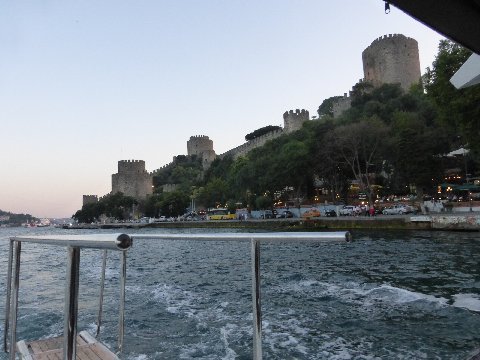
Above: 07 July 2014. Bosphorus from dinner cruise boat.
Today, the MotoDiscovery/Kazoom Moto Adventures tour group, which had completed its motorcycle ride from the Black Sea to the Caspian Sea and back, flew from Kars, in eastern Turkey, to Istanbul. Event of the day was a dinner cruise on the Bosphorus.
I relayed to my tour mates my idea for a fireworks display on the Bosphorus; "Phosphorus on the Bosphorus." My idea was not only not panned, ridiculed or booed. It was totally ignored.
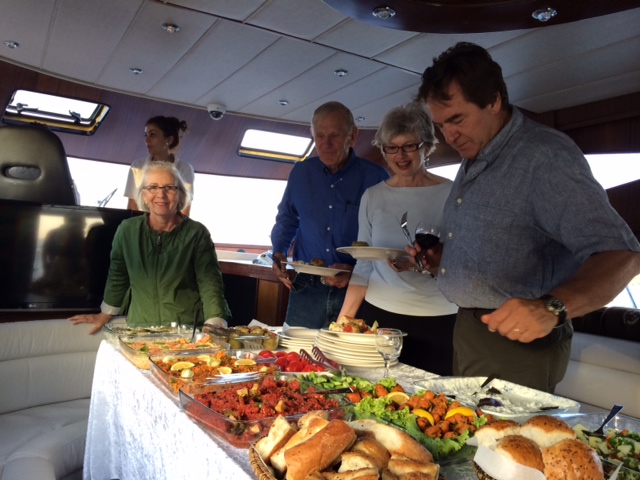
Above: 07 July 2014. Dinner cruisers. From left: TIMDT, Gary, Carol, Taos. Image by Claudia.
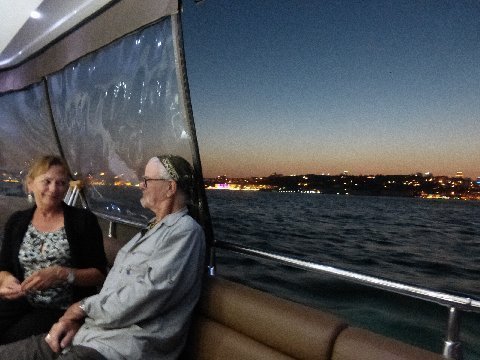
Above: 07 July 2014. Nancy and Petrolia.
Nancy is wife of Skip Moscorro. Together they are self employed owners and operators of MotoDiscovery Motorcycle Tours, co tour organizer, along with Kazoom Moto Adventures, of our motorcycle tour through the Caucasus.
http://www.motodiscovery.com/
http://www.kazoom-moto-adventures.com/
Nancy rode pillion with Skip. There was never a moment throughout the trip where Nancy was not cheerful and helpful.
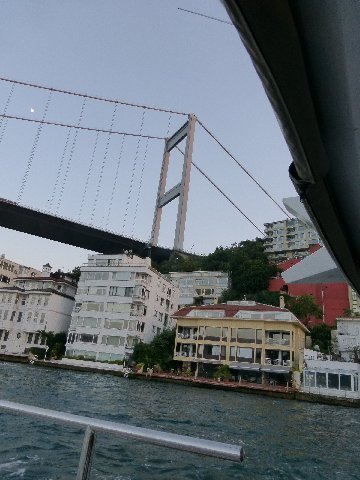
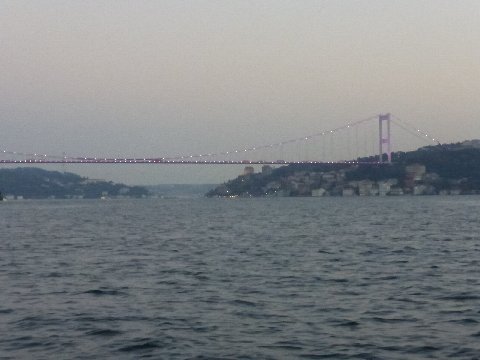
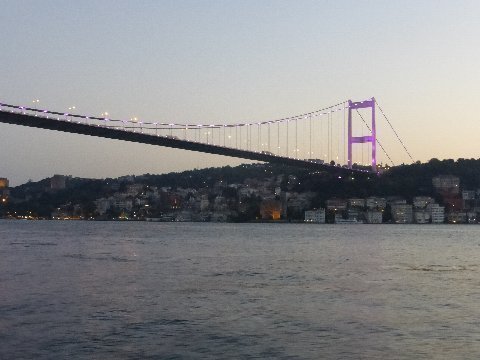
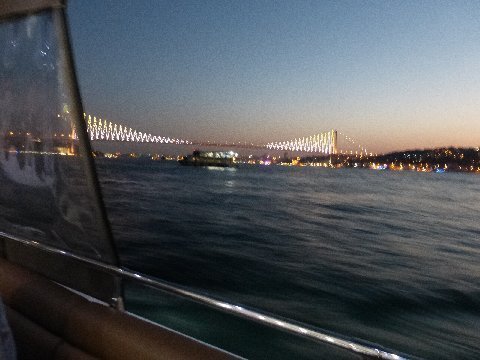
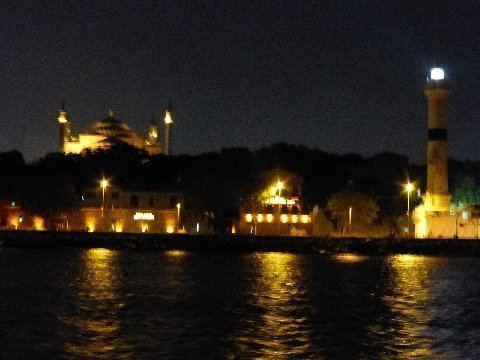
07 July 2014 Addendum
Steve - What an incredible journey and daily saga. Thank you for your fascinating travelogue of a far off the beaten path part of the world. Your query “How are we supposed to feel about Stalin?” is a real grabber. When I read it I had to pause. It's like asking “How are we supposed to feel about Hitler?”
Safe travels home.
Congratulations on what you and TIMDT have done.
Desert,
Salt Lake City, UT/Palm Desert, CA
Yet FDR was enamored with Stalin. The enemy of my enemy is my friend?
Steve,
What a trip! I have very much enjoyed your commentary; thanks so much for including me on your list. Where to next?
Susan,
Park City, UT
Back to Istanbul in September. Black Sea, Adriatic Sea, Seabourn Cruise.
Bonjour Steve,
Pourriez vous me dire ce que veulent dire les initialesTIMDT, j'assume que vous vous référez à votre épouse... mais je suis intrigué! Elle doit surement avoir un joli prénom
Amitié et au plaisir peut être d'avoir un jour votre visite dans notre belle province!
Pierre (Flic),
Montreal, Canada
TIMDT = The Incomparable Margaret Dickerson Taylor
En ce qui concerne une visite a votre 'belle province," j'aimerais bien. Merci de l'invitation. J'y pense... serieusement.
THANK YOU for sharing your amazing journey. I enjoyed the trip and your comments. Brought up many memories!
In college I had major hours in Poli Sci and history, including a semester Russian history course. A few years ago, [ZZZZ] and I enjoyed a Viking River trip from St. Petersburg to Moscow on Viking River. Vast difference between major and rural cities.
Immediately after graduation, I joined [XXXXX] in June, 1966, assigned to South East Asia, promoted to Asst Cashier in 1968 and posted to Asst Mgr in Hong Kong in 1969. In January 1971, when I told [YYYYY] I was planning to marry [ZZZZ] who was with Irving Trust, [YYYYY] asked for my resignation due to conflict of interest.
Your comments brought to mind country conditions of honeymoon travel in 1971 to Beirut, India's Golden Triangle and Darjeeling...and in 1973 in Pakistan, Afghanistan and Iran. Isfahan and its market were amazing!
Working and living overseas was a wonderful experience! Interesting postings, wonderful trips and worldwide friendships.
Thank you for your efforts to share with us and keep us in touch. I also very much enjoy your travel accounts.
Dusty,
Seattle, WA
(redacted somewhat... by Mwah [sic])
Thanks for the beautiful pictures and commentary Steve
Joe
Sydney, Australia
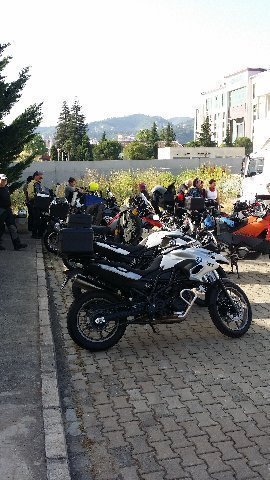
Above: 1st riding day. Novotel Hotel, Trabzon, Turkey. 20 June 2014.
Before riding to Batumi, Georgia, we would detour to see the Sulema Monestery, one of the top ten tourist destinations of Turkey.
20 June... it seems like a long time ago!
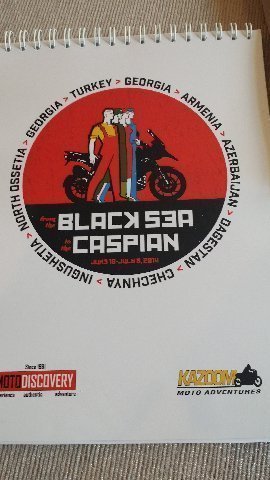
Above: 08 July 2014. Trip notes, with maps, sight descriptions, hotel information, etc. produced by tour organizers... MotoDiscovery and Kazoom Moto Adventures.

Above: TIMDT on Armada Hotel breakfast patio with Haggia Sophia as a back drop. 08 July 2014.
Shortly after this image was taken, TIMDT would fly from Istanbul to Paris... overnight at the airport Marriott, and take the Delta to SLC direct flight, the next day, 09 July 2014.
It was a great trip. Our thanks to the organizers, MotoDiscovery and Kazoom Moto Adventures... as well as our great traveling companions.
Back to hiking in the Wasatch and grandchildren for a while.
Travel certainly educates.
I was quite unfamiliar with the Caucasus area, its geographical outlines and historical significance, before traveling there on the MotoDiscovery/Kazoom Moto Adventures, 2100 mile motorcycle journey, TIMDT riding pillion with me on a 2014 BMW K1200 GS motorcycle.
Here are some stream of conscious, quick and dirty, certainly not exhaustive, impressions that come to mind as I close out this trip report.
The Caucasus. The isthmus separating the Black Sea from the Caspian Sea links Europe and Russia, in the north, to the Middle East and Anatolia, to the south. The Caucasus mountain range divides the northern and southern portions of the isthmus, which has been home to various ethnic groups voire. Ossetians, Abkhazians, Chechens, Gerogians, Armenians, Dagistanis, and Azeris. The Caucasus isthmus has, because of its strategic location on the Silk road, and natural resources (oil) been an important prize for outside foreign invaders: Arabs, Tartars, Ottomans, Russians, Sassinids and Persians. While there have been periods of relative peace in the Caucasus, more often than not, the ethnic groups have warred with one another and with their foreign invaders.
Josef Stalin, one of the most ruthless dictators in world history, was born in the Caucasus (Gori, Georgia) in 1878. By 2005, while still in his 20's, Stalin had become an important person in the anti-Tsar, Bolshevik movement headed by V.I. Lenin. While a student at the Tiflis (Tbilisi) Theological Seminary he became an atheist and a Marxist. Expelled from school he went underground and spearheaded anti Tsar terrorist activities throughout the Caucasus... from blowing up oil refineries in Batumi, to robbing banks in Tiflis, to fire bombing oil installations in Baku. Booty from bank robberies he instigated funded the Bolshevik Party and brought him quickly to the attention of Lenin.
Soviet Rule. In the 1920's after the Bolsheviks had consolidated their power, they created three semi autonomous republics in the southern Caucasus: Azerbaijan, Georgia, and Armenia. The area had been under Russia's control as one administrative unit during the time of the Tsars. The three republics fared relatively well during Soviet times, benefiting more than most areas in the Soviet Union from Soviet industrialization. Employment was high, money was available, even if there was nothing to spend it on.
Post Soviet fall and recovery. When Soviet subsidies ended in 1991, after the fall of the Soviet Union, the economies of the three Caucasus, former Soviet Republics went into severe depression. Only in the last ten years have Georgia, Armenia, and Azerbaijan, shown economic come back. Azerbaijan, in particular, has benefited from its significant Caspian Sea oil resources.
Armenian Wariness. Armenia is a country most of whose citizens profess Christianity and are members of the Armenian Apostolic Church, the oldest, organized Christian Church in the world. Armenians are wary... on their guard. To Armenia's east is Muslim Azerbaijan, with whom they have an unresolved dispute as to the ownership of the province of Nagorno Karabach. To Armenia's west is Turkey, who, Armenia claims, has not acknowledged its responsibility in perpetrating a genocide on Armenian citizens during WWI, which resulted in the death of 1.5 million Armenians. The Armenian diaspora, 7 million strong, are strong givers back to Armenia. Armenia has a strong relationship with Russia, which supplies troop support to help police Armenia's frontier with Turkey.
East/West Ambivalence. It was hard to get a one word answer from anyone in the Caucasus to the question, "Is Georgia/Armenia/Azerbaijan in Europe or in Asia? In fact one observes elements of both continents in each of the cities we visited. Yerevan looks European. Its folk music, however has decidedly more in common with eastern music than it does western music. Food throughout the Caucasus seems more "eastern," with shasliks and kebabs being principle main courses most places we visited. The Caucasus form a bridge from Europe to Asia. That the area has been influenced by both continents is easy to discern. Perhaps the question doesn't require an answer.
Russia and Extremists. Russia doesn't mess around with separatist, Islamic insurgents. The Chechen city of Grozny was leveled by Russian military power in the early 1990's to eliminate an Islamic, Chechen initiative to gain independence from Russia. The city has been rebuilt. Notwithstanding, there remains a low grade Islamic insurgency in the mountains outside of Grozny.
Soviet Repression of Religion. Religion was suppressed during the 80 year period of Soviet rule. The suppression did not have equal effect in all areas. Today, Azerbaijani's, though titular Muslim, are mostly secular in life style. Conversely, in Armenia, the Armenian Apostolic Church is strong with a solid majority of Armenians being church goers. The Georgian Orthodox Church is strong, but, Georgian Christians are not as devout as the Armenians.
Caucasus People. People we encountered along the route, including border crossing officials, were always cordial and friendly. Many wanted to see our motorcycles up close. On announcing I was an American, I always received a bright smile as a response. This reinforced my longstanding belief, buttressed by having traveled to over 100 countries and having lived 20 years outside of the United States, that Americans are generally well liked throughout the world.
Tendonitis. Half way through the motorcycle trip through the Caucasus, I developed tendonitis in my left elbow and forearm. Lots of clutch work, up shifting and down shifting, was required on the twisty roads, dirt roads, and in the cities. The BMW R1200 Motorcycle performed perfectly on the trip.
Technology facilitates problem solving in, and exports American culture to, the most remote areas imaginable today. At the Azerbaijani/Russian border, my lost visa could have sunk the trip for everyone. But, the immediate retrieval of a scanned copy of my visa, from a hotel where I had stayed three days previously, which was instantaneously emailed to the hand held of our tour leader at the obscure border crossing, saved the day. The Azerbaijanis could scan the bar code of the emailed visa and I could pass through to Russia. The Azerbaijani "in charge" further reacted to his examination of my passport: "Utah? Utah Jazz!" he exclaimed.
Logistics and Planning. The trip was a logistical and planning tour de force accomplished by the organizers. Seven border crossings (ergo 14 border checks), hotels successfully booked in six countries... a do-able itinerary where riding and sightseeing were well balanced. Weather was mostly good, though the rain storm that muddied up the road in mountainous Dagistan, might have, but didn't, put a spanner in the works.
TIMDT. I really enjoyed traveling with her on this trip. She's not into motorcycling, but has, on occasion, been a trouper pillion rider when the organizers, companions, hotels and destinations were right. TIMDT rode pillion with me for about 3/4 of the way... 1700 miles. She and other pillion riders rode in a car for the more difficult Russian riding sections. This was truly a one of a kind trip. Notwithstanding the occasional hardships... like the hotel in the Dagistan Caucasus that had no water.... she told me she was glad she went.
Sights. The shear number of important, but obscure historical sights we saw was amazing... to name the most important:
Haggia Sophia, Istanbul
Sulema Monastery, eastern Turkey
Black Sea Beaches, eastern Turkey and Georgia
Godherzi Pass, Lessor Cauasus, Georgia
Bakuriani Ski Resort, Georgia
Cave City, Georgia
Gyumri, Armenia
Cascade Monument, Yerevan, Armenia
Armenian Genocide Monument, Yerevan, Armenia
Hripseme Church, Yerevan, Armenia
Naftalan Oil Spa, Azerbaijan
Flame Towers, Baku, Azerbaijan
Caspian Sea, Baku, Azerbaijan
Derbent Citidel, the only Sassinid fortification in existence today
Djuma Mosque, Derbent, the oldest mosque in Russia
Tsovkra village, Dagastan... home of the famous tight rope walkers
Grozny - Leveled and rebuilt Chechen city
Akhmad Kadryrov Mosque - Grozny, Chechnya
Martyrs Monument - Grozny, Chechnya
Beslan monument to martyred school children, North Ossetia
The high, greater Caucasus near Vladikavkaz, North Ossetia
The Georgian Military Highway through the Greater Caucasus
Freedom Square, Tbilisi, Georgia, site of Stalin's bank heist in 1907.
Ari. 10th century Armenian capital in present day Turkey.
08 July 2014 Addendum:
Steve, my humble offering from this side of the pond......did not the Old Bear play Churchill and FDR like an old Russian fiddle? I seriously doubt, however, that either leader was truly "enamoured" with their Communist counterpart.
Josef Stalin taunted and humiliated both men. With spies everywhere, he knew exactly how to win the endgame he wanted. He was devious, ruthless and clever. He proved himself to be a brilliant negotiator as he flouted Yalta, profiteered from the War and the Poles' misery. And then, he even had the audacity to ask for 16 seats at the UN table!! Humorous, too!!!!!
I much enjoy the writing of Simon Sebag Montefiore (Jerusalem and One Night in Winter) and should love to borrow his biography of Stalin if you might consider lending it to me this summer. His wife, Santa, writes intelligent chick lit too which, I feel sure, TIMDT would find most comforting after her 1700+ miles riding pillion!
We take our hats off to you both for your most recent adventure. My Father took me out to lunch last week: "My dear girl, life is for living," he counselled, wisely, and what tremendous fun you both have living yours!
Looking forward to seeing you all next week and with our love to you all.
Eton Mum,
Devon, UK
Good Evening Steve,
We’ve enjoyed your Picto Diary entries and I was wondering if you could include your Stalin death mask photo and the one in this entry of the lighted Bosphorus bridge when you send pictures to the Drop Box that Allison has set up. That way we would have them in a higher resolution which would be nice. We will have a limited number of photos to include as all the photos on my phone disappeared the day after Baku and no one was able to retrieve them once we got home. At least we had our regular camera and we remind ourselves that all of life is not a Kodak moment.
We enjoyed the company of you and Margaret on this latest adventure with a bunch of motorcycle enthusiasts. Oh the places we’ve been and the things we have seen….
Cheers,
Carol and Gary,
Missoula, MT
Will do. Enjoyed being with you guys, too.
Steve,
Margaret is looking cute on your bike. You look very much like that anonymous figure that seems to pop up in some of your accounts.
You have provided all of us with a great ride.
Basketball,
Pelham, NY